Preprint
Review
Naturally Occurring Nor-Steroids and Their Design and Pharmaceutical Application
This version is not peer-reviewed.
Submitted:
16 April 2024
Posted:
16 April 2024
You are already at the latest version
A peer-reviewed article of this preprint also exists.
Abstract
The main focus of this review is to introduce readers to the fascinating class of lipid molecules known as norsteroids, exploring their distribution across various biotopes and their biological activities. The review provides an in-depth analysis of various modified steroids, including A, B, C, and D-norsteroids, each characterized by distinct structural alterations. These modifications, which range from the removal of specific methyl groups to changes in the steroid core, result in unique molecular architectures that significantly impact their biological activity and therapeutic potential. The discussion on A, B, C, and D-norsteroids sheds light on their unique configurations and how these structural modifications influence their pharmacological properties. The review also presents examples from natural sources that produce a diverse array of steroids with distinct structures, including the aforementioned A, B, C, and D-nor variants. These compounds, sourced from marine organisms like sponges, soft corals and starfish, as well as terrestrial entities such as plants, fungi, and bacteria. The exploration of these steroids encompasses their biosynthesis, ecological significance, and potential medical applications, highlighting a crucial area of interest in pharmacology and natural product chemistry. The review emphasizes the importance of researching these steroids for drug development, particularly in addressing diseases where conventional medications are inadequate or for conditions lacking sufficient therapeutic options. Examples of norsteroid synthesis are provided to illustrate the practical applications of this research.
Keywords:
Subject:
Biology and Life Sciences - Biochemistry and Molecular Biology1. Introduction
Steroids are de facto isoprenoid lipids and are found in eukaryotic organisms, from microorganisms to macroalgae, invertebrates, plants, and are present in most sedimentary organic matter [1,2,3,4,5,6,7,8]. Thus, steroids and isoprenoid lipids are an important group of fossil chemical compounds that provide valuable information about the sources of organic matter in modern sediments and ancient sedimentary rocks, as well as crude oil [9,10,11,12]. Diagenesis of organic matter found in waters and sediments modifies the structures of steroid precursors in complex ways.
The concept of "norsteroids" was introduced in the scientific literature by American chemist Russell Marker in the early 1930s. Marker discovered a way to synthesize hormones such as progesterone from plant sterols, leading to the development of the first oral contraceptive pill. He coined the term "norsteroids" to describe these compounds, which are structurally related to steroids but have a carbon removed from the steroid nucleus. This term has since been used to refer to a class of compounds that are derived from steroids but have modified structures [13]. Marker was a pioneering figure in the field of steroid chemistry and made significant contributions to the synthesis of various steroid compounds, including the development of methods to produce progesterone from diosgenin, a compound found in plants. His work laid the foundation for the production of cortisone and other important steroid medications [14,15]. The synthesis of some norsteroids is described in the literature, and additional review literature on the synthesis of norsteroids and their biological activity is provided at the end of this review.

Russell Earl Marker was born on his father's farm near Hagerstown, Maryland, on March 12, 1902. His journey into the world of chemistry began in 1925 when he decided to forgo a Ph.D. in chemistry at the University of Maryland, as he did not wish to complete the course requirements. Marker then took a position at the Ethyl Gasoline Company, where he helped develop the octane rating for gasoline. He later moved to the Rockefeller Institute to study the Walden inversion and then to Penn State College, where his already prolific publication record reached even greater heights. In the 1930s, Marker's interest shifted towards steroids and their potential as pharmaceuticals. He collected plant specimens from the southwestern US and Mexico, discovering many sources of steroidal sapogenins. At Penn State College, where he rose to the rank of full professor, he and his students uncovered the structure of these sapogenins and invented the "Marker degradation" process, which converted diosgenin and other sapogenins into progesterone. Marker's groundbreaking work led to the co-founding of Syntex with Emeric Somlo and Federico Lehmann, marking the beginning of the commercial manufacture of progesterone. However, Marker's tenure at Syntex was short-lived; he soon left the company, started another pharmaceutical venture in Mexico, and eventually retired from the field of chemistry altogether. Russell E. Marker passed away on March 3, 1995. His contributions to chemistry, particularly in the synthesis of steroids, have left an indelible mark on the field and paved the way for significant advancements in pharmaceuticals. His legacy is preserved in part through photographs and archives at The Pennsylvania State University.
Nor-steroids (see Figure 1) are natural and/or synthetic isoprenoid lipids that have undergone any ring size reduction (removal of one carbon atom) or side chain reduction (removal of methyl groups) by biosynthetic or synthetic means. Based on these de facto principles, four groups of steroids or triterpenoids can be distinguished [1,2,3,4,5,7,14,15]. The first group, it includes steroids in which the A ring is reduced by one carbon atom, these are A-nor steroids are natural or synthetic isoprenoid lipids that have undergone any ring size reduction (removal of one carbon atom) or side chain reduction (removal of methyl groups) by biosynthetic or synthetic means. Based on these de facto principles, four groups of steroids or triterpenoids can be distinguished. The first group, it includes steroids in which the A ring is reduced by one carbon atom, these are A-nor steroids. The second group includes steroids in which the B ring is reduced by one carbon atom, these are B-nor steroids, and as an alternative to using the prefix nor-, the prefix “abeo” can be used. The third group includes steroids in which the C ring is reduced by one carbon atom, these are C-nor steroids, and the fourth group includes steroids in which the D ring is reduced by one carbon atom, these are D-nor steroids [16,17].
Furthermore, the structures of abeo-steroids are complex and diverse, containing a seven-membered ring embedded in the fused or bridged A/B ring system and possessing numerous stereogenic centers. Besides their structural complexity, various abeo-steroids have shown remarkable biological activities. However, the most interesting for this review is the information about A, B, C, and D-nor steroids, which are found in marine organisms, algae, and are also synthesized by fungi or fungal endophytes [1,2,3,4,5,6,7,8,16,17].
This review presents information on the content of these steroids in various biotopes, as well as the remains of these compounds found in marine and freshwater sediments and sedimentary rocks. Also of interest is information on the biological activity of A, B, C, and D-nor steroids, which is demonstrated by both natural and synthetic analogs.
2. A-Nor Steroids and Triterpenoids Derived from Marine Sources
A-nor-steroids, also known as nor-steroids or A-nor analogs, are a class of organic compounds that are structurally derived from steroids by removing one carbon atom from the steroid framework. Specifically, the carbon atom that is removed is located between the A and B rings of the steroid structure, leading to the prefix "A-nor" (meaning "without A") in the name. The removal of this carbon atom results in an open or missing ring structure in the A-ring of the steroid molecule. This modification alters the overall shape and properties of the steroid, leading to changes in its biological activity and pharmacological properties [18,19,20,21,22,23].
A-nor-steroids can be synthesized through various chemical methods, including rearrangements, oxidations, or reductions of existing steroids. They have been of particular interest in medicinal chemistry and drug development due to their potential to exhibit unique biological activities and improved therapeutic profiles compared to the parent steroids. These compounds have been investigated in various therapeutic areas, such as anti-inflammatory, anti-cancer, and hormonal therapies. Some examples of A-nor-steroids include norethisterone (a synthetic progestin), nor-androstenedione (a precursor to the anabolic steroid nandrolone), and norbolethone (a synthetic anabolic steroid) [20,21,22,23].
It is important to note that the specific properties and effects of A-nor-steroids can vary depending on the exact structural modifications made and the specific compound under consideration. Therefore, it's necessary to evaluate each A-nor-steroid individually in terms of its structure, biological activity, and potential applications.
The study of ancient sediments, crude oils, marine, and freshwater sediments for their steroid and other isoprenoid lipid contents is crucial for both academic research and practical applications [6,9,24,25,26]. This area of research provides insights into the biological and chemical transformations of lipid molecules over extended periods under varying temperature and geochemical conditions. Bacteria play a pivotal role in the mineralization of steroids in the biosphere. The aerobic breakdown of steroid hormones relies on oxygen as a co-substrate for oxygenases, which activate and cleave the resilient steroid core ring. In anaerobic environments, denitrifying bacteria utilize pathways to decompose various steroid structures. Recent metaomics studies reveal that microorganisms can alter or convert steroid molecules into a wide array of intriguing compounds found across diverse ecosystems. Among the numerous steroids identified, a small subset known as nor-steroids [6,9,24,25,26,27,28] is particularly notable. Figure 2 illustrate most common A-nor steroids (1-16) which found in crude oil extracts, marine sediments, and other geological and environmental sources. The deformed ring A in A-nor steroids (1-188) is highlighted in red in the Figure 2, Figure 4, Figure 5, Figure 7, Figure 8, Figure 9 and Figure 10.
Sponges, belonging to the Porifera phylum, are some of the earliest multicellular organisms, with fossils dating back over 580 million years to the Precambrian era. Sponges play a significant role in tropical reefs, often dominating the biomass, and are also present in polar and deep ocean environments, as well as freshwater habitats. Both marine and freshwater sponges are sources of various biologically active compounds, including A-nor steroids [1,2,3,4,5,6,29,30].
Although sponges are recognized as sources of bioactive substances, the exact origin of these compounds remains unclear. Sponges are known to form symbiotic relationships with bacteria, fungal endophytes, and microalgae [31,32]. Despite this, the metabolites isolated from sponges are categorized as their own compounds. A-nor steroids derived from sponges are detailed below.
The marine sponge Axinella carteri, harvested from the Bay of Bengal off the Orissa coast, was found to contain A-nor 5α-cholestan-2-one (12) [33]. This particular steroid has been identified as an agonist for nerve growth factor [34]. In Western Australia's ocean waters, sponges such as Agelas mauritiana, Clathria major, Darwinella australiensis, Didiscus aceratus, Haliclona sp., and Teichaxinella labirintica have been collected and analyzed for their steroid content [35]. From these sponges, approximately 60 different steroids were isolated, with A-nor steroids (17-26) among them. Notably, extracts from Agelas mauritiana and Darwinella australiensis (samples of sponge see in Figure 3) have displayed hemolytic activities [33,34,35,36].
A collaborative team of French and Saudi Arabian scientists investigated various sponges along the Senegalese coast, including Pseudosuberites sp., Suberites massa, Suberites sp.1, Suberites sp.2, and Rhizaxinella elongata. Additionally, three Ciocalypta species (sp1, sp2, sp3) were collected from Dakar, and Stylissa carteri was gathered from the Red Sea near Jeddah, Saudi Arabia [37]. Analysis of these sponges revealed the presence of eight A-nor steroids (19, 27-31, structures see in Figure 4) in their extracts. Furthermore, the steroid 3-hydroxymethyl-24-methyl-A-norcholestane (19) was identified in Axinella verrucosa, Hymeniacidon perlevis, Homaxinella trachys, Phakellia aruensis, and the triton Charonia tritonis [38,39,40]. The compound 24-ethyl-3-hydroxymethyl-A-norcholestane (31) was detected in Acanthella aurantiaca, Axinella verrucosa, and Homaxinella trachys [38,40]. A-Norcholistane-3-methanol (28) was found in Axinella verrucosa and Hymeniacidon aldis [41,42,43,44], and (3β,5α,22E,24R)-3-Hydroxymethyl-24-methyl-A-norcholest-22-ene (36) was isolated from these same sponges [41,42,43,44].
Figure 4.
A-Nor steroids derived from marine species.
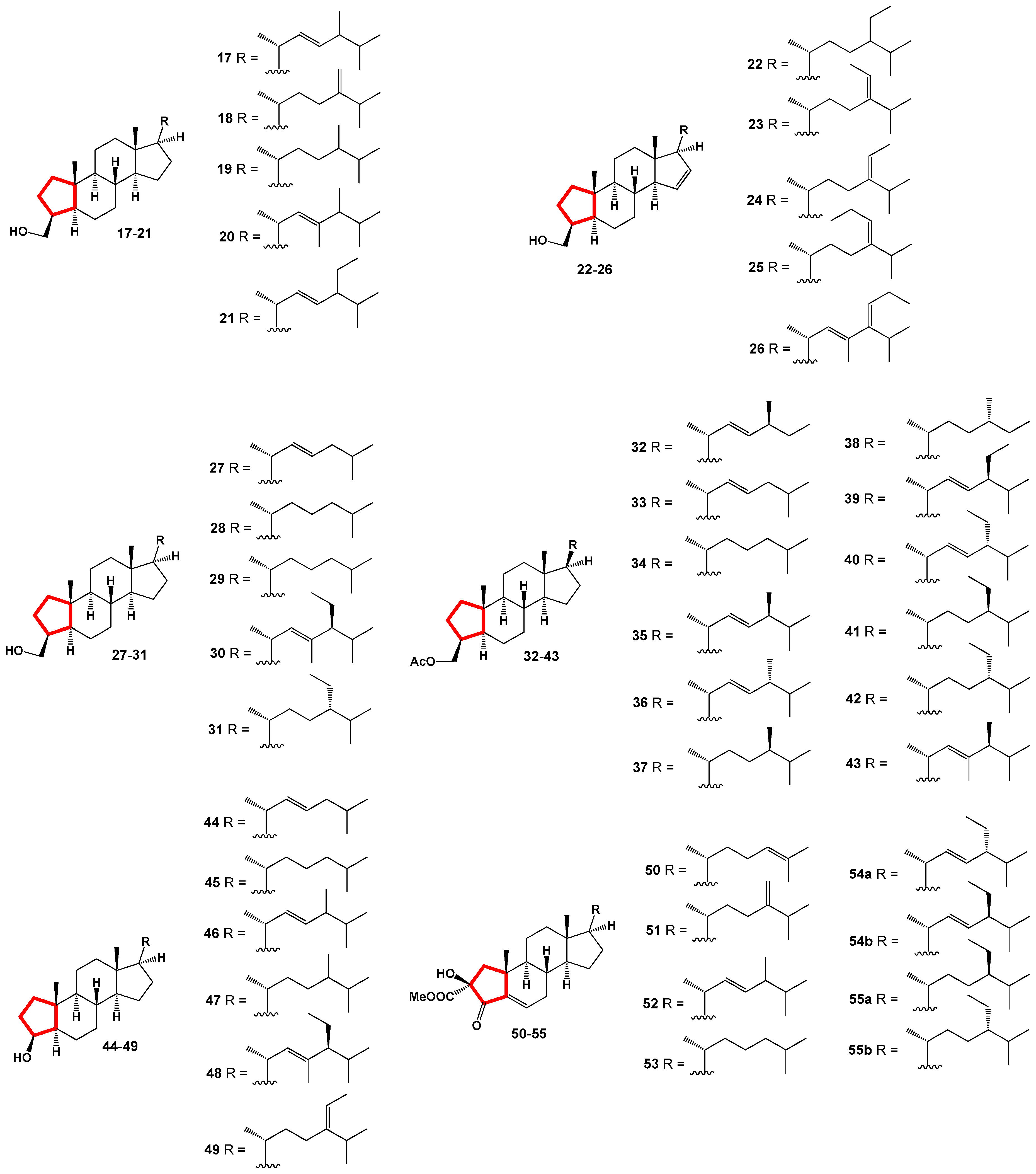
Researchers from the University of California focused on the Gulf of Mexico sponge Teichaxinella morchella, discovering that its extracts contained exclusively 3-hydroxymethyl-A-nor-sterols (32-43). The exclusive presence of A-nor-sterols, with no normal sterols, indicates that these compounds might be biotransformation products of dietary precursors or result from bacteria transforming common sterols into A-nor-sterols [41,42,45].
Bulgarian lipidologists studied Halichondria panicea and Hymeniacidon sanguinea from the Black Sea, finding A-nor-sterols in both sponges (44-49). The similarity in sterol composition led scientists to hypothesize a shared diet or other food sources [46].
The Florida sponge Phorbas amaranthus is known to contain A-nor steroids, specifically anthosterones A (50) and B (51), and other steroids named phorbasterones A-D (52-55). These compounds exhibited moderate cytotoxicity against HCT-116 tumor cells [47]. Anthosterone A (50) and B (51) were previously isolated from the sponge Anthoarcuata graceae in British Columbia's Deer Group of Islands [48]. The red algae Calloseris sp. (family Delesseriaceae), found along Madagascar's eastern coastline, yielded phorbasterone B (53), also found in Phorbas amaranthus, and another A-nor-steroid, (−)-2-ethoxycarbonyl-2β-hydroxy-A-norcholest-5- en-4-one (56) [49]. This steroid (56, see the structure in the Figure 5) was also detected in the soft coral Acropora formosa [50]. Lasiodiplodia pseudotheobromae, a pathogenic fungus from the Botryosphaeriaceae family, produced two steroids: phorbasterone A (52) and the unusual 3β,14β-dihydroxy-6-oxo-A-nor-ergosta-7,22-diene-4-oic acid δ-lactone (60). This fungus, found on Chinese carcass and Acacia mangium in Venezuela, causes mango fruit rot. Additionally, steroid phorbasterone B (53) was previously identified in the soft coral Dendronephthya sp. [52].
In the South China Sea, research on the spine body sponge Acanthella cavernosa led to the discovery of three A-nor steroids: the ethyl esters of 2β-hydroxy-4,7-diketo-A-norcholest-5-en-2-oic acid (61), 24S-ethyl-2β-hydroxy-4,7-diketo-A-norcholest-5-en-2-oic acid (62), and 2β-hydroxy-4,7-diketo-24R-methyl-A-norcholest-5,22(E)-dien-2-oic acid (63) [53]. These steroids exhibited antifouling properties, showing effectiveness in inhibiting the settlement of Balanus albicostatus, with EC50 values of 8.2, 23.5, and 31.6 μg/mL, respectively.
Anthosterone B (51), along with two other A-nor steroids, crellasterones A (64) and B (65), were isolated from the sponge Crella incrustans, collected in New Caledonia [54]. Both crellasterones structurally resemble the semi-synthetic steroid maltadiolone (66), which is used medically and possesses calcium-binding activity comparable to cells not treated with calcium channel blockers [55]. This category also includes xidaosterol B (67), found in extracts from the South China Sea sponge Neopetrosia chaliniformis [56]. Furthermore, an extract from the brown alga Sargassum carpophylum (seaweed samples are shown in Figure 6), collected from the South China Sea, contained 24-ethyl-3-carbethoxy-3-hydroxy-A-norcholesta-5,24(28)-dien-2-one (68) [57]. A range of 3β-hydroxy-methyl-A-norsterane steroids (69-75) was isolated from the Okinawan marine sponge Hymeniacidon aldis [58]. The sponge Hymeniacidon perlevis (order Halichondrina) was found to contain significant amounts of stanols with a 3β-hydroxymethyl-A-nor-sterane nucleus (18-25), alongside sterols 28 and 70 [59].
A-nor steroids 28, 72, 76, and 3β-(hydroxymethyl)-A-nor-5α-cholest-15-ene (77) were extracted from a Clathria sp. marine sponge, collected from Southeast Sulawesi, Indonesia. Among these, clathruhoate (76), identified as 3β-(butyryloxymethyl)-A-nor-5α-cholestane, is noteworthy [60]. The Australian sponge Phakellia aruensis was the source of A-nor sterols with various nuclei, specifically 19, 21, 78, and 79 [61]. In a Cribrochalina sp. marine sponge, two A-nor steroids, 80 and haplosamate B (81), were discovered. Notably, haplosamate B exhibits inhibitory effects on membrane-type matrix metalloproteinase, with an IC50 value of 160 μg/mL [62].
Figure 5.
A-Nor steroids identified from marine invertebrates and seaweeds.
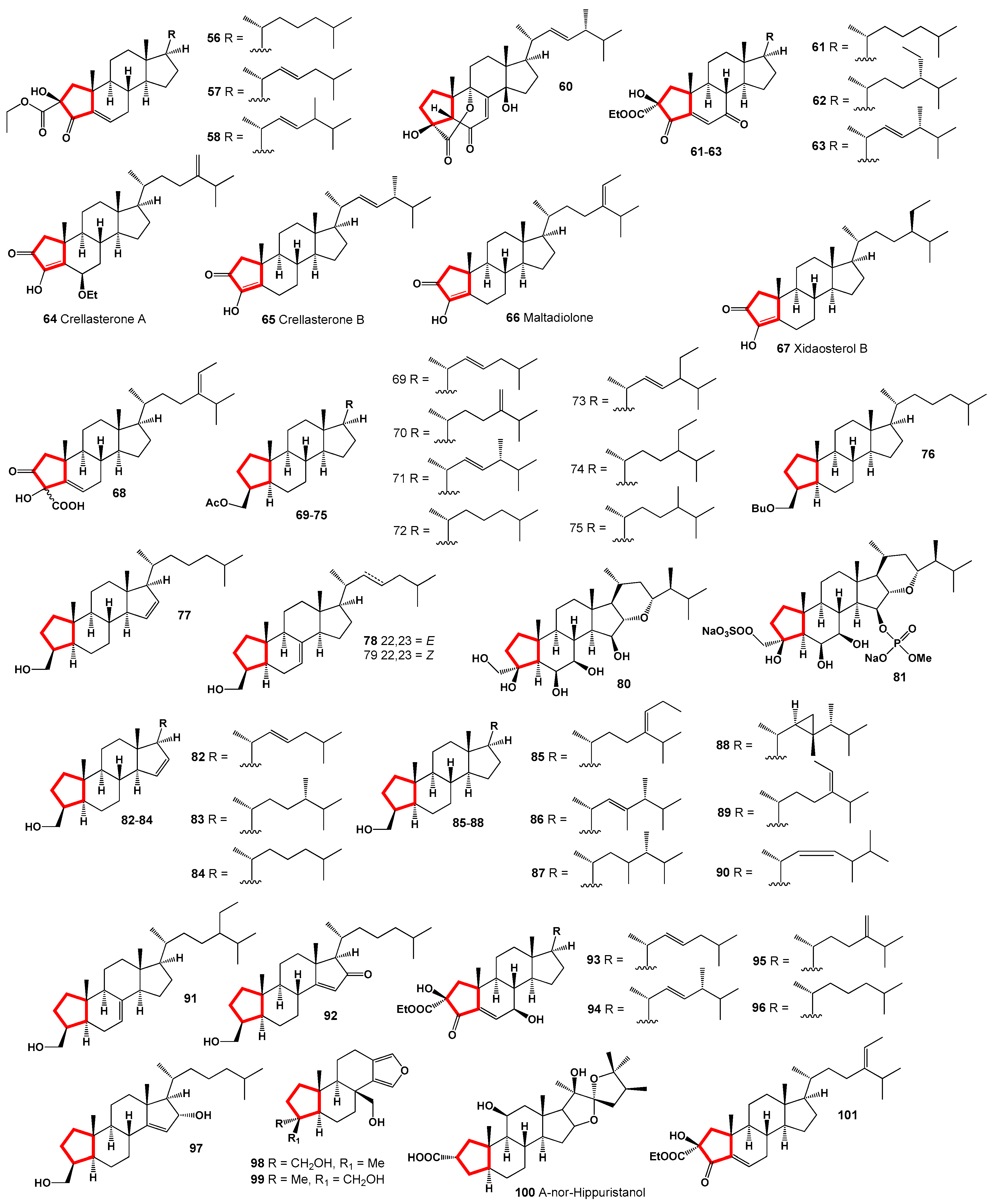
Figure 6.
Samples of some marine sponges and kelp that contain A-nor steroids: a, Crella incrustans, b, Sargassum carpophylum, c, Hymeniacidon perlevis, d, Clathria sp., e, Homaxinella subdola, and f, Stylotella aurontium.
Figure 6.
Samples of some marine sponges and kelp that contain A-nor steroids: a, Crella incrustans, b, Sargassum carpophylum, c, Hymeniacidon perlevis, d, Clathria sp., e, Homaxinella subdola, and f, Stylotella aurontium.
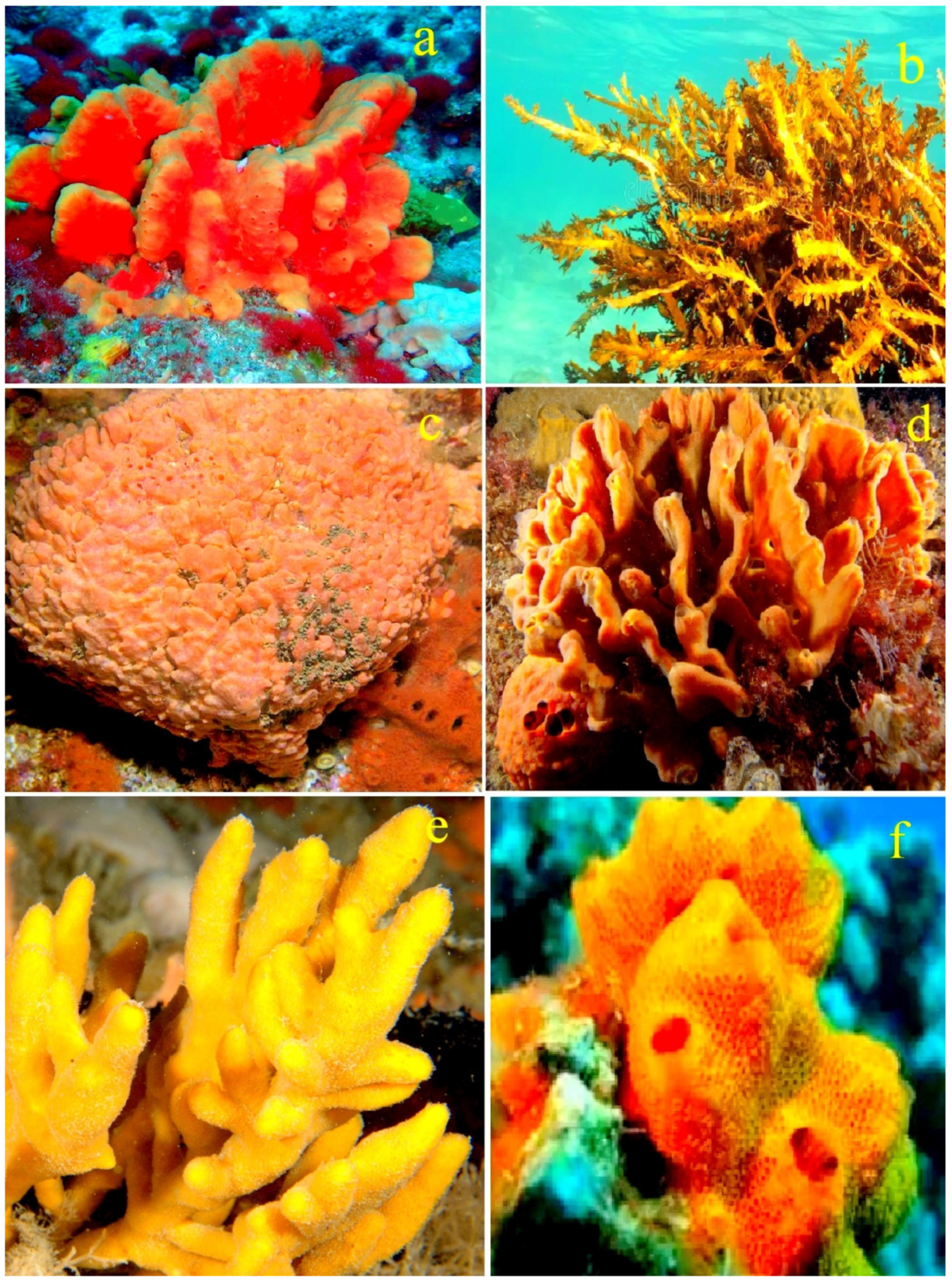
Figure 7.
A-nor steroids isolated plant extracts or individual parts thereof.

Figure 8.
A-nor steroids isolated extracts of plants or their individual parts, bark, leaves, fruits.
Figure 8.
A-nor steroids isolated extracts of plants or their individual parts, bark, leaves, fruits.
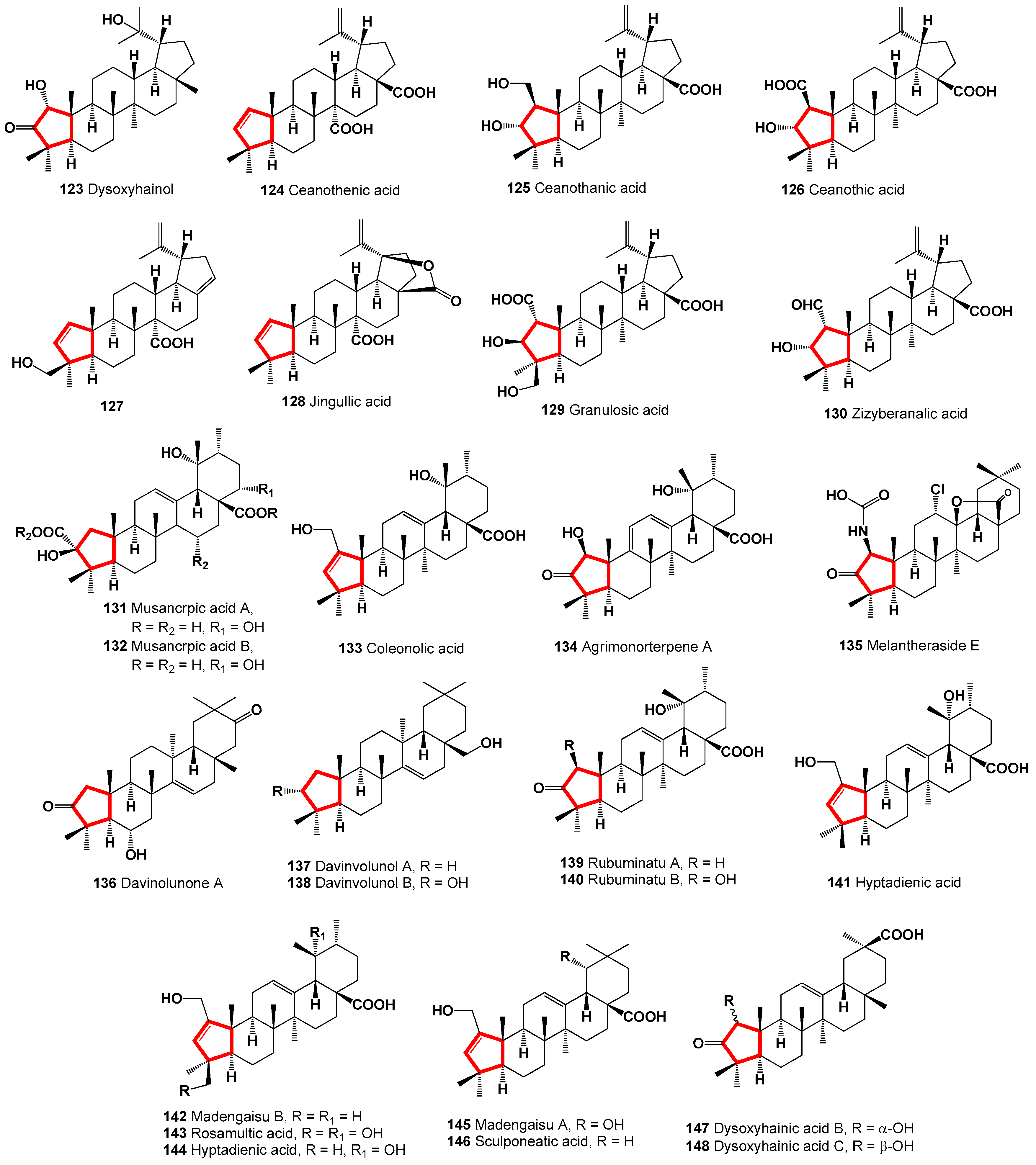
Figure 9.
Samples of plants, or individual parts thereof, in which A-nor steroids were found: a, fruits of Citrullus colocynthis, b, Withania aristata, c, Isodon amethystoides, d, Euphorbia helioscopia, e, Ceanothus americanus, f, Ziziphus mauritiana.
Figure 9.
Samples of plants, or individual parts thereof, in which A-nor steroids were found: a, fruits of Citrullus colocynthis, b, Withania aristata, c, Isodon amethystoides, d, Euphorbia helioscopia, e, Ceanothus americanus, f, Ziziphus mauritiana.

Figure 10.
A-norsteroids isolated extracts of plants or their individual parts, roots, bark, leaves.
Figure 10.
A-norsteroids isolated extracts of plants or their individual parts, roots, bark, leaves.
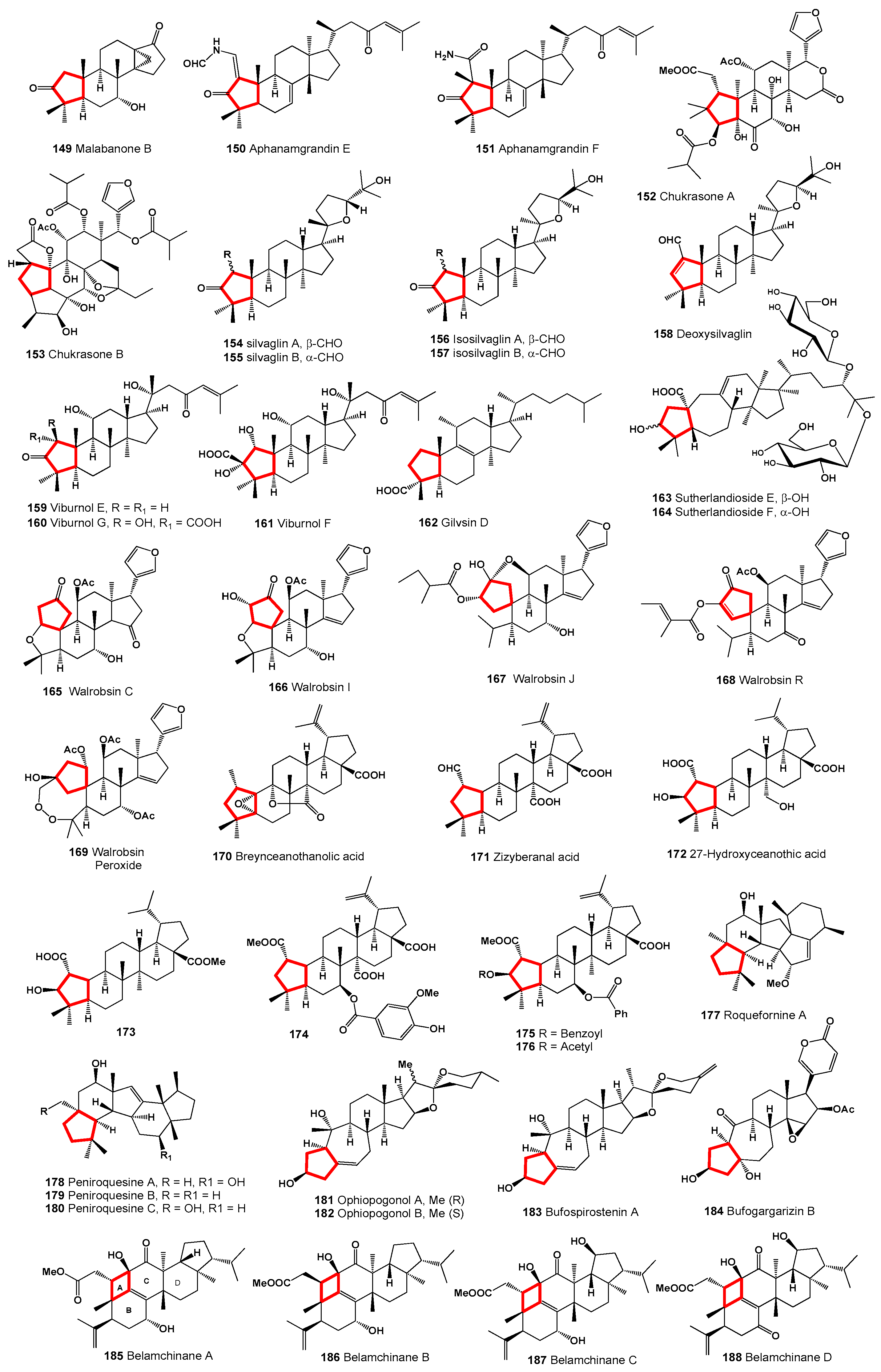
Steroids 82, 83, and 84 were identified in extracts from marine sponges such as Acanthella aurantiaca, Axinella tenuidigitata, Homaxinella trachys, and Phakellia aruensis [39,40,41,42]. Additionally, 22,23-dihydro-A-nor steroids 85-90 were isolated from various marine sponges including Acanthella aurantiaca, Acanthella cristagalli, Axinella verrucose, Homaxinella trachys, Hymeniacidon aldis, Phakellia aruensis, Pseudaxinyssa cantharella, Stylotella agminata, and Teichaxinella morchella in diverse parts of the World Ocean [39,40,41,42,43,58,61]. The marine sponge Acanthella cristagalli contains 3-Hydroxymethyl-24-ethyl-A-norcholest-7-ene (91) [63].
In the waters of Derawan Island, Indonesia, the marine sponge Axinella carteri was found to contain a moderately cytotoxic nor-sterol 92 [64]. The sponge Haliclona oculata yielded unusual A-nor steroids (93-96) [65]. From Axinella proliferans, collected in the Indian Ocean, several A-nor-sterols (27, 28, 30, 31, 36, 37) were isolated, including rare nor-sterols with D-ring unsaturation, 77, and 3β-(hydroxymethyl)-A-nor-5α-cholest-14-ene-16α-ol (97) [66]. A sea sponge from the Fiji Islands, Spongia sp., is the source of furanoditerpenoids named 3-nor-spongianone A (98) and B (99), which are unique due to their novel nor-spongian carbon skeleton, akin to ring-A-contracted nortriterpenoids [67].
3. A-Nor Steroids and Triterpenoids Derived from Terrestrial Sources
A-Nor steroids and triterpenoids, derived from terrestrial sources, represent two distinct classes of naturally occurring organic compounds, each exhibiting unique structural characteristics and properties. Found in various terrestrial plants and fungi, A-nor steroids, though less common than other steroids, demonstrate significant biological activities and potential therapeutic applications. These applications include hormone therapy and anti-inflammatory treatments [1,2,3,4,5,11,12,70,71]. Triterpenoids, on the other hand, are prevalent in the plant kingdom and exhibit a broad distribution among terrestrial plants. As one of the largest and most diverse classes of plant metabolites, triterpenoids have been extensively researched for their pharmacological properties, including anti-inflammatory, antiviral, antibacterial, and anticancer effects. They are also utilized in traditional medicine and as natural supplements [3,4,11,12,70,71].
Both A-nor steroids and triterpenoids are crucial in the fields of natural product chemistry and pharmacology due to their varied structures and biological activities. They are key subjects in drug development and therapeutic applications. However, their efficacy and safety profiles require further research to fully comprehend their potential in medicine and other uses.
Viburnum dilatatum, commonly known as linden viburnum, is a deciduous shrub from the Adoxaceae family, introduced in the mid-Atlantic regions of the USA, from New York to Virginia. A notable feature of this shrub is its production of clusters of red drupes when ripe. Traditional Chinese medicine uses the berries, leaves, and stems to create remedies for snake bites, dysentery, and as an anti-helminthic. From the leaves of this shrub, A-nor triterpenoids viburnols E (102), F (103), and G (104, structures see Figure 7) have been isolated [72,73].
The fruits of Citrullus colocynthis contain a cucurbitane 3-nor-triterpenoid named norcolocynthenin B (105), featuring a unique 5/6/6/5-fused ring system. This compound exhibited significant cytotoxic activity against human cancer cell lines HL-60 (IC50 = 6.49 μM) and PC-3 (IC50 = 13.42 μM) [74].
Dysoxylum hainanense, a plant known for its twigs and leaves, is a source of triterpenoids like dysoxyhainic acids with a contracted five-membered ring A. Dysoxyhainic acid A (106), possessing an unprecedented 2-nor-1,3-cyclotirucallane skeleton, showed moderate antibacterial activity against Gram-positive bacteria [75].
The fruits of Citrullus colocynthis were also analyzed phytochemically, revealing the presence of structurally diverse nonanorcucurbitane-type triterpenoids, including colocynins, one of which is the bioactive colocynin A (107). This triterpenoid exhibited anti-acetylcholinesterase activity and significant cytotoxicity against PACA, A431, and HepG2 cells [76,77].
Three triterpenoids, cucurbalsaminones A (108), B (109), and C (110), were isolated from a methanol extract of Momordica balsamina. These compounds feature a unique 5/6/3/6/5-fused pentacyclic carbon skeleton, named cucurbalsaminane, and displayed potent multidrug resistance (MDR)-reversing activity [78].
In the study of Withania aristata, two withanolide-type steroids were identified: 4β-formyl-6β,27-dihydroxy-1-oxo-witha-2,24-dienolide (111), and 4β-formyl-6β,27-dihydroxy-1-oxo-witha-24-enolide (112). These compounds demonstrated potent antiproliferative activity, inducing apoptosis in human tumor cells [79]. Additionally, an unusual withanolide glucoside with two cyclobutene rings, named trichoside B (113), was discovered in the n-butanol fraction of a 75% methanolic extract of the aerial parts of Tricholepis eburnean [80].
From the rhizomes of Isodon amethystoides, a triterpenoid named amethystoidesic acid (114) was isolated. This acid, with an unprecedented 5/6/6/6 tetracyclic skeleton, is the first triterpenoid of its kind, derived from a contracted A-ring and the 18,19-seco-E-ring of ursolic acid, and exhibited inhibitory effects on nitric oxide production [81].
The triterpenoid gilvsin D (115), produced by the fruiting body of the pathogenic fungus Phellinus gilvus, known in traditional Chinese medicine as sanghuang, is used to alleviate abdominal pain and treat cancer [82]. Additionally, a unique A-nor-B-homo steroid 116, containing a 10(5→4)-abeo-ergostane fragment, was isolated from the culture of basidiomycete Polyporus ellisii [83].
3-Hydorpxymethyl-A-nor cholestane (117) was found in extracts of Cretaceous black shales of Upper Barremian age (115 Myr BP), which is believed to be a component of sea sponges [84].
From Urceola quintaretii, two C19 steroids named urceoloids A (118) and B (119), featuring a unique spiro[4.4]nona-3,6,8-triene system, were isolated. These compounds exhibited immunosuppressive activities [85].
Lastly, three nortriterpenes from the roots of Ziziphus mauritiana, zizimauritic acids A (120), B (121), and C (122), with a unique A-nor-E-seco spiro-lactone ceanothane-type triterpene skeleton, were identified. These compounds displayed cytotoxicity, with IC50 values ranging from 5.05 to 11.94 μg/mL, and compounds 120 and 122 inhibited the growth of Staphylococcus aureus, with IC50 values of 2.17 and 12.79 μg/mL, respectively [86].
In the study of Dysoxylum hainanense, a novel triterpenoid named dysoxyhainol (123, structures see Figure 8) was identified from its twigs and leaves. This compound, with a modified ring A structure, exhibited moderate antibacterial activity against Gram-positive bacteria [75]. Additionally, the extraction of Ceanothus americanus (plant samples are shown in Figure 9), commonly known as Jersey Tea, yielded a pentacyclic C29 triterpenoid named A-norlupa-1,22-diene-14,17-dicarboxylic acid or ceanothenic acid (124), along with ceanothic acid (126) [87]. Another compound, ceanothanic acid (125), was isolated from the roots of Ziziphus mauritiana [86,87].
From the roots of Ziziphus jujuba, a cytotoxic compound, 2,28-Dinor-24-hydroxylup-1,17(22)-dien-27-oic acid (127), was discovered [90]. Jingullic acid (128), another noteworthy compound, was found in the bark of Emmenosperma alphitoniodes [91].
Granulosic acid (129) was detected in ether extracts of the heartwood of Colubrina granulosa [87]. Zizyberenalic acid (130) has been identified in various parts of the Ziziphus genus, including Z. jujuba fruit, Z. cambodiana roots and bark, and Z. jujuba roots [88,90,92]. From the roots of Z. jujube, two unique compounds, Musancrpic acid A (131) and B (132), featuring an E-ring clactone structure, were isolated [90].
The roots of Coleus forskohlii yielded a rearranged pentacyclic triterpenoid, 2-hydroxy-methyl A(1)nor-urs-19α-hydroxy-2(3),12(13)dien-28-oic acid or coleonolic acid (133) [93]. Additionally, the whole plant of Agrimonia pilosa led to the discovery of a nortriterpenoid named 19α-hydroxy-2-oxo-nor-A(3)-urs-11,12-dien-28-oic acid, referred to as agrimo-norterpene A (134) [94].
Melantheraside E (135), a 3-oxo-2β-carboxyamino-12α-chloro,13β-hydroxy-1-nor-oleanan-28,13-olide, was found in the aerial parts of Melanthera elliptica [95]. From Davidia involucrata, the ring-A contracted nortaraxerane davinolunone A (136) was isolated [96]. This plant also yielded two taraxerene-type triterpenes, 2-nor-D-friedoolean-14-en-28-ol (137) and 2-nor-D-friedoolean-14-en-3α,28-diol (138), which demonstrated moderate cytotoxicity against various cancer cell lines [97].
Figure 11.
Samples of plants, or individual parts of leaves, fruits in which A-nor steroids were found: a, Coleus forskohlii, b, Melanthera elliptica, c, Rubus innominatus, d, Potentilla freyniana, e, Aphanamixis grandifolia,.and f, Chukrasia tabularis.
Figure 11.
Samples of plants, or individual parts of leaves, fruits in which A-nor steroids were found: a, Coleus forskohlii, b, Melanthera elliptica, c, Rubus innominatus, d, Potentilla freyniana, e, Aphanamixis grandifolia,.and f, Chukrasia tabularis.

The roots of Rubus innominatus produced two nortriterpenes, rubuminatus A (139) and B (140), each containing a unique contracted five-membered A-ring ursane-type skeleton. These compounds exhibited significant inhibitory effects on cytokines [98]. From Salvia buchananii roots, a pentacyclic triterpene called hyptadienic acid (141) was isolated, inducing a S cell cycle block in HeLa cells [99]. In the roots of Potentilla freyniana, A-ring contracted triterpenoids were detected, including madengaisu B (142), rosamultic acid (143), hyptadienic acid (144), madengaisu A (145), and sculponeatic acid (146) in 95% EtOH extracts [100]. Madengaisu B and hyptadienic acid showed cytotoxic activity against BGC-823 and Hep-G2 cells, respectively.
Dysoxylum hainanense twigs and leaves metabolized ring A modified triterpenoids, namely dysoxyhainic acids B (147), and C (148), alongside dysoxyhainol (123), all showing moderate antibacterial activity against Gram-positive bacteria [75], and from Ailanthus malabarica stem bark, a triterpenoid named malabanone B (149, structures see Figure 10), featuring a unique tricyclo[4.3.1.01,6]decane unit, was isolated [101]. Aphanamixis grandifolia (plant samples are shown in Figure 11) stems yielded aphanamgrandins E (150) and F (151), which are 2,3-seco-tirucallane triterpenoid derivatives [102]. Chukrasia tabularis produced two limonoids, chukrasone A (152) and B (153), exhibiting potential inhibition of the delayed rectifier (IK) K+ current [103].
Figure 12.
Samples of plants, fungi and amphibians in which A-norsteroids were found: a, Belamcanda chinensis, b, Paliurus ramosissimus, c, mushroom Phellinus gilvus, d, toad Bufo bufo gargarizans.
Figure 12.
Samples of plants, fungi and amphibians in which A-norsteroids were found: a, Belamcanda chinensis, b, Paliurus ramosissimus, c, mushroom Phellinus gilvus, d, toad Bufo bufo gargarizans.
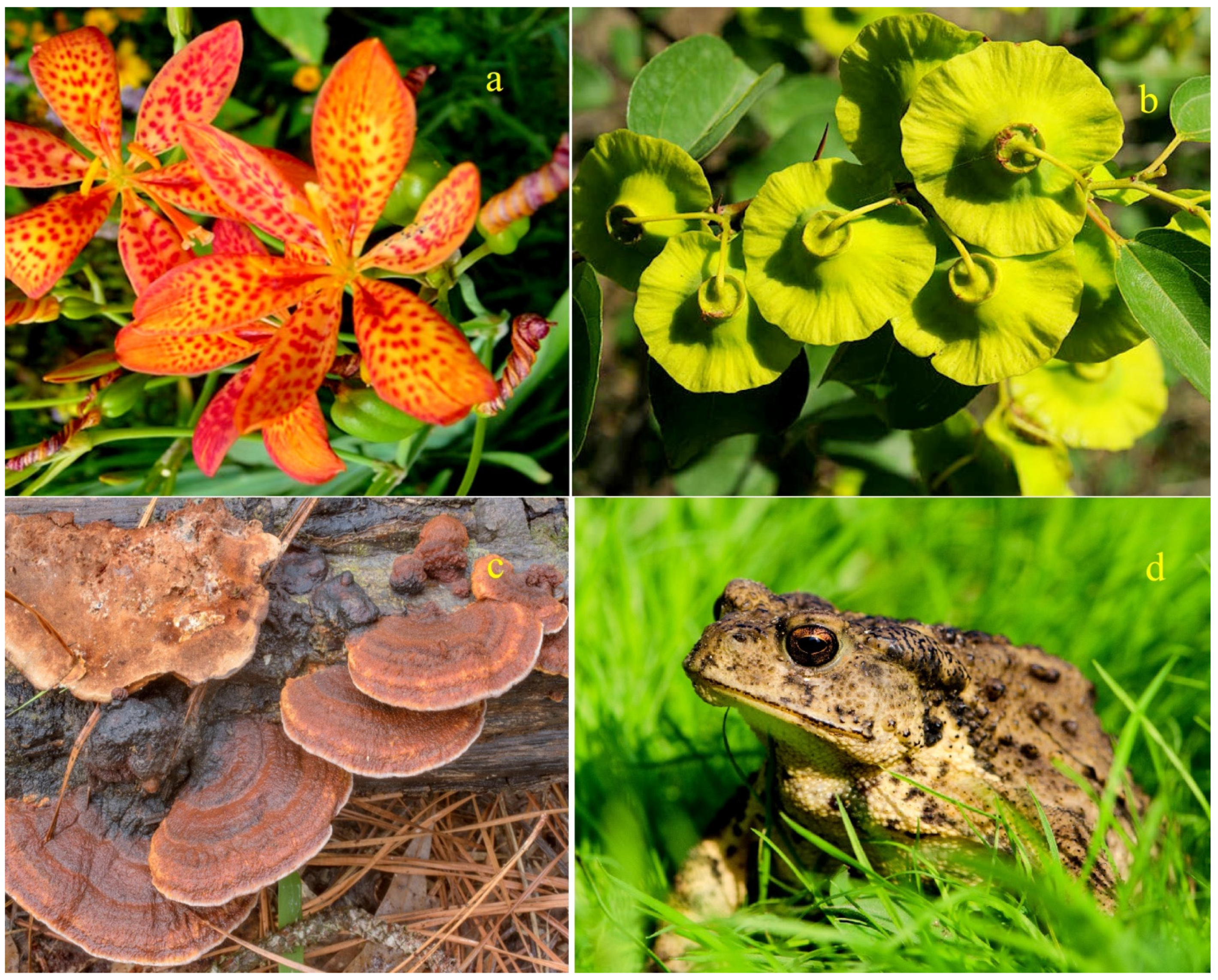
Aglaia sylvestris rootwood provided dammarane-type triterpenoids silvaglin A (154), isosilvaglin A (156), their 1H-β-epimers silvaglin B (155) and isosilvaglin B (157), and deoxysilvaglin (158) with a Δ1(3)-bond [104]. Viburnum dilatatum leaves yielded dammarane triterpenoids viburnols E (159) [105,106], F (161), and G (160). The lanostane-type triterpenoid gilvsin D (162) was isolated from the mushroom Phellinus gilvus [107] (mushroom samples are shown in Figure 12).
From the southern African legume Sutherlandia frutescens, two rearranged cycloartanol glycosides, sutherlandiosides E (163) and F (164), were isolated. These compounds are notable for their aglycones, which feature a unique rearranged five- and seven-membered A/B-ring system [108]. Additionally, several neotecleanin-type limonoids (165-169) were detected in methanol (MeOH) extracts of the root barks of Walsura robusta [109].
A nor-ceanothane-type triterpenoid, breynceanothanolic acid (170), was obtained from the roots of Breynia fruticose. This compound demonstrated moderate cytotoxicity against five human cancer cell lines [110,111]. In the fruits of Ziziphus jujuba (Rhamnaceae), 2α-aldehydo-A(1)-norlup-20(29)-en-27,28-dioic acid (zizyberanal acid, 171) was identified [112].
27-Hydroxyceanothic acid (172) was found in the roots and bark of Ceanothus americanus [113], as well as in the roots of Paliurus ramosissimus [114]. The C-28 methyl ester of ceanothic acid (173) was detected in the bark of Zizyphus joazeiro [115] and in the seeds of Zizyphus jujube [116].
A jujubogenin glycoside, namely 3”-O-acetylcolubrin (174), was isolated from the leaves of Colubrina asiatica [117]. Ether extracts from the heartwood of Colubrina granulosa yielded the polyphenolic coumaranone maesopsin 3,7-O,O-dibenzoyl ceanothic acid methylester (175), and 3-O-acetyl-7-O-benzoyl ceanothic acid methylester (176) [118].
Roquefornine A (177), a sesterterpenoid featuring an unprecedented 5/6/5/5/6-membered pentacyclic system, was characterized from the fungus Penicillium roqueforti YJ-14 [119]. Additionally, other sesterterpenes, peniroquesines A–C (178-180), with a unique 5–6–5–6–5-fused pentacyclic ring system, were isolated from the same fungus through solid fermentation [120,121].
The medicinal herb Ophiopogon japonicus, in a 70% ethanol extract of its rhizomes, contained steroidal glycosides known as ophiopogonols. Notably, ophiopogonols A (181) and B (182) are rare spirostanols with a rearranged A/B ring system (5/7/6/5/5/6 ring system) not previously identified in plants [122]. Bufospirostenin A (183), a steroid with rearranged A/B rings, was isolated from the toad Bufo bufo gargarizans. This compound is notable as the first spirostanol identified in animals [123]. A similar steroid, bufogargarizin B (184) with an unprecedented skeleton, was discovered in the venom of Bufo bufo gargarizans [124].
Belamchinanes A–D (185-188), four triterpenoids with a novel skeleton were isolated from the seeds of Belamcanda chinensis. These structures feature a 4/6/6/6/5 polycyclic system, where a four-membered carbocyclic ring bridges the C-1 and C-11 positions of a classical triterpenoid framework [125].
4. B-Nor Steroids Derived from Marine Sources
B-Nor steroids and abeo-steroids are two distinct types of modified steroids, each characterized by unique structural features. B-Nor steroids involve a modification in the B-ring of the steroid nucleus, where one carbon atom is absent compared to the standard steroid structure. This alteration can significantly impact the biological activity of the steroid, leading to unique pharmacological properties and potential applications in medicine, including contraceptive development and other therapeutic agents [3,5,12,18,35,36,37,41,42].
Figure 13.
Samples of marine invertebrates in which B-nor steroids were found: a, starfish Astropecten polyacanthus, b, marine sponge Theonella swinhoei, c, soft Taiwanese coral Nephthea chabrolii, and d, spongivorous nudibranchs Chromodoris annae.
Figure 13.
Samples of marine invertebrates in which B-nor steroids were found: a, starfish Astropecten polyacanthus, b, marine sponge Theonella swinhoei, c, soft Taiwanese coral Nephthea chabrolii, and d, spongivorous nudibranchs Chromodoris annae.
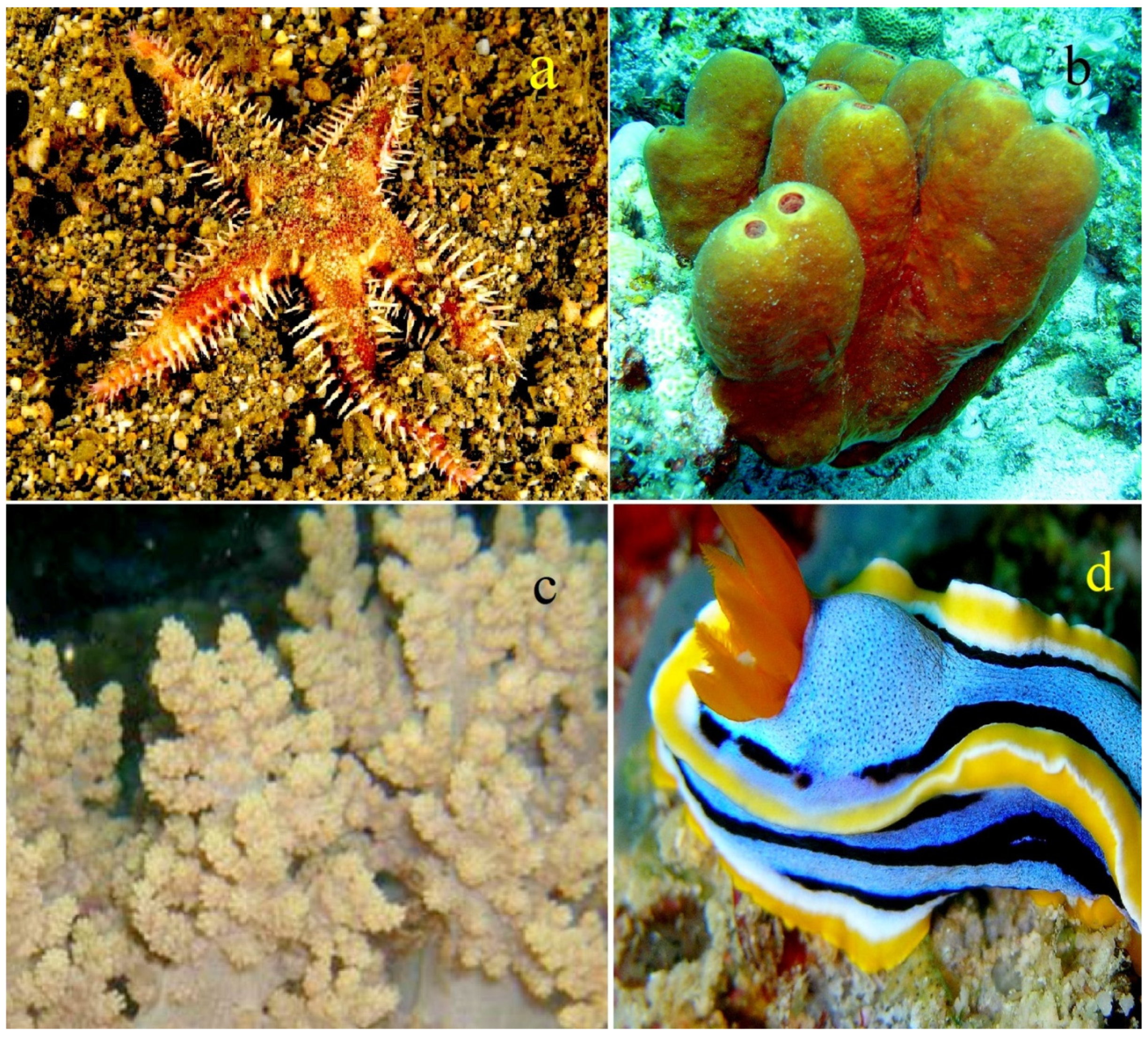
Abeo-steroids, on the other hand, undergo a more drastic structural rearrangement than B-Nor steroids. The term "abeo" signifies a deviation from the normal steroid structure, often involving the breaking and reforming of rings in the steroid nucleus. These rearrangements can result in substantial changes in the biological activity of the steroids, offering potential for unique therapeutic benefits. Like B-Nor steroids, abeo-steroids have potential medicinal and pharmacological applications, though their development and study may be more complex due to significant structural changes [3,5,12,18,35,36,37,41,42]. The deformed ring B in the B-nor steroids (189-287) is highlighted in green in the Figure 14, Figure 16, Figure 19 and Figure 20.
Both B-Nor steroids and abeo-steroids are based on the core steroid structure, sharing the basic four-ring configuration common to all steroids. They are of significant interest in pharmacology and medicinal chemistry for their potential to yield new therapeutic agents, representing key structural modifications in steroid chemistry.
In the field of marine natural products, both B-nor steroids and marine-derived triterpenoids play a significant role. This research branch focuses on the ocean's biodiversity for novel compounds that could lead to new or improved pharmaceuticals. Marine ecosystems' unique conditions often produce structurally distinctive and biologically potent compounds not found in terrestrial environments [41,42,126,127,128,129].
From the methanolic extract of the starfish Astropecten polyacanthus (a sample starfish is shown in Figure 13), four steroids named astropectenols A–D were identified, but only astropectenol A (189, structures see Figure 14) possesses a B-nor skeleton. The CH2Cl2 fraction of this extract exhibited strong cytotoxic effects against human leukemia HL-60 cells [130,131]. A sterol derivative, 5(6→7)-abeo-sterol, orostanal (190), was obtained from an extract of the marine sponge Stelletta hiwasaensis and induced apoptosis in human acute promyelotic leukemia cells [132,133].
An anti-tubercular extract from the Caribbean Sea sponge Svenzea zeai yielded 5(6→7)-abeo-sterols, parguesterol A (191), and parguesterol B (192) [134]. A-Homo-B-nor sterol (193) has been identified among the volatile compounds in marine sediments [135,136,137]. 8β-Hydroxy-7α-formyl-B-northeonellasterol (194) was detected in MeOH and CH2Cl2 extracts from the marine sponge Theonella swinhoei, collected from the Bohol province in the Philippines [138].
An unusual metabolite with a spiro-ring A, B system, known as spirosteroid chabrolosteroid C (195), was detected in the organic extract of a Taiwanese soft coral Nephthea chabrolii [139]. Carijodienone (196), featuring a spiro[4,5]decane core derived from an A-B ring rearrangement of a steroidal nucleus, was isolated from the Pacific octocoral Carijoa multiflora [140]. Another spirosteroid, petasitosterone C (197), possessing a rare A/B spiro[4,5]decane ring system, was identified in a Formosan marine soft coral Umbellulifera petasites [141].
An unprecedented triterpene glycoside with the aglycone fallaxoside D3 (198) was found in the sea cucumber Cucumaria fallax, belonging to the Cucumariidae family in the Dendrochirotida order [142]. B-Nor triterpenoids 199 and 200 were discovered in the extract of a cultivated fungus isolated from a marine sponge off the coast of Australia [143].
In recent years, increased attention has been given to secondary metabolites that undergo degradation, including B-nor-steroids and B-nor-triterpenoids. These compounds are associated with aging or other yet-to-be-understood biological processes. Several measurements of degradable steroids or triterpenoids have been identified in marine invertebrates. For instance, pinnigorgiols A-E (201-204), which are 9,11-secosteroids with a unique tricyclic γ-diketone framework, were obtained from a gorgonian coral Pinnigorgia sp. [144,145]. Highly degraded steroids, chromodorolide A (205), B (206), and D (207), were detected in a methanol (MeOH) extract from spongivorous nudibranchs of the genus Chromodoris and the marine sponge Chromodoris sp. collected along the coast of Okinawa [146]. The same chromodorolides A-C were isolated from an Australian sponge Aplysilla sulphurea. All chromodorolides exhibited significant cytotoxicity against the P388 mouse leukemia cell line and showed activity against the free-living larval stages of the parasitic nematodes Haemonchus contortus and Trichostrongylus colubriformis [147].
In the study of a Red Sea Dysidea species, three rearranged spongiane-type diterpenes were isolated: norrlandin (208), seco-norrisolide B (209), seco-norrisolide C (210), and norrisolide (219). Both norrlandin and norrisolide exhibited cytotoxic activities [148]. Norrisolide (219), in particular, has been identified as a phospholipase A inhibitor, possessing anti-inflammatory and ichthyotoxic properties. It was found in various marine organisms, including Chromodoris norrisi, Chelonaplysilla violacea, Dendrilla sp., and Dysidea spp. [149,150,151,152]. The New Zealand sponge Chelonaplysilla violacea contains rearranged sponginess, including cheloviolenes A (211), B (212), C (213), E (214), and norrisolide (216) [152].
An investigation into two Red Sea Dysidea sponges yielded rearranged spongian degraded steroids shahamins A (215), B (216), and C (217), along with aplyviolacene (218) [148,153]. Aplyviolacene (218) was also detected in the Australian sponge Chelonaplysilla violacea [154]. Two rearranged spongiane-type diterpenes, chelonaplysins A (221) and C (222), identified from the Pohnpeian marine sponge Chelonaplysilla sp., demonstrated antimicrobial activity against Bacillus subtilis [155]. Additionally, chromolactol (220) and cheloviolene C (223) were found in extracts of the Indo-Pacific nudibranch Goniobranchus coi [156] (samples are shown in Figure 15).
5. B-Nor Steroids and Triterpenoids Derived from Terrestrial Sources
B-nor steroids, like many steroids, are derived from both natural and synthetic sources. Naturally, they are found in various plants and animals, often playing roles in the organisms' biology, typically as part of defense mechanisms. In the laboratory, chemists can modify naturally sourced steroids or synthesize B-nor steroids from basic organic chemicals using complex chemical processes [12,18,35,36,37,41,42,157,158].
Figure 16.
B-nor steroids isolated from plant extracts, or their individual parts.
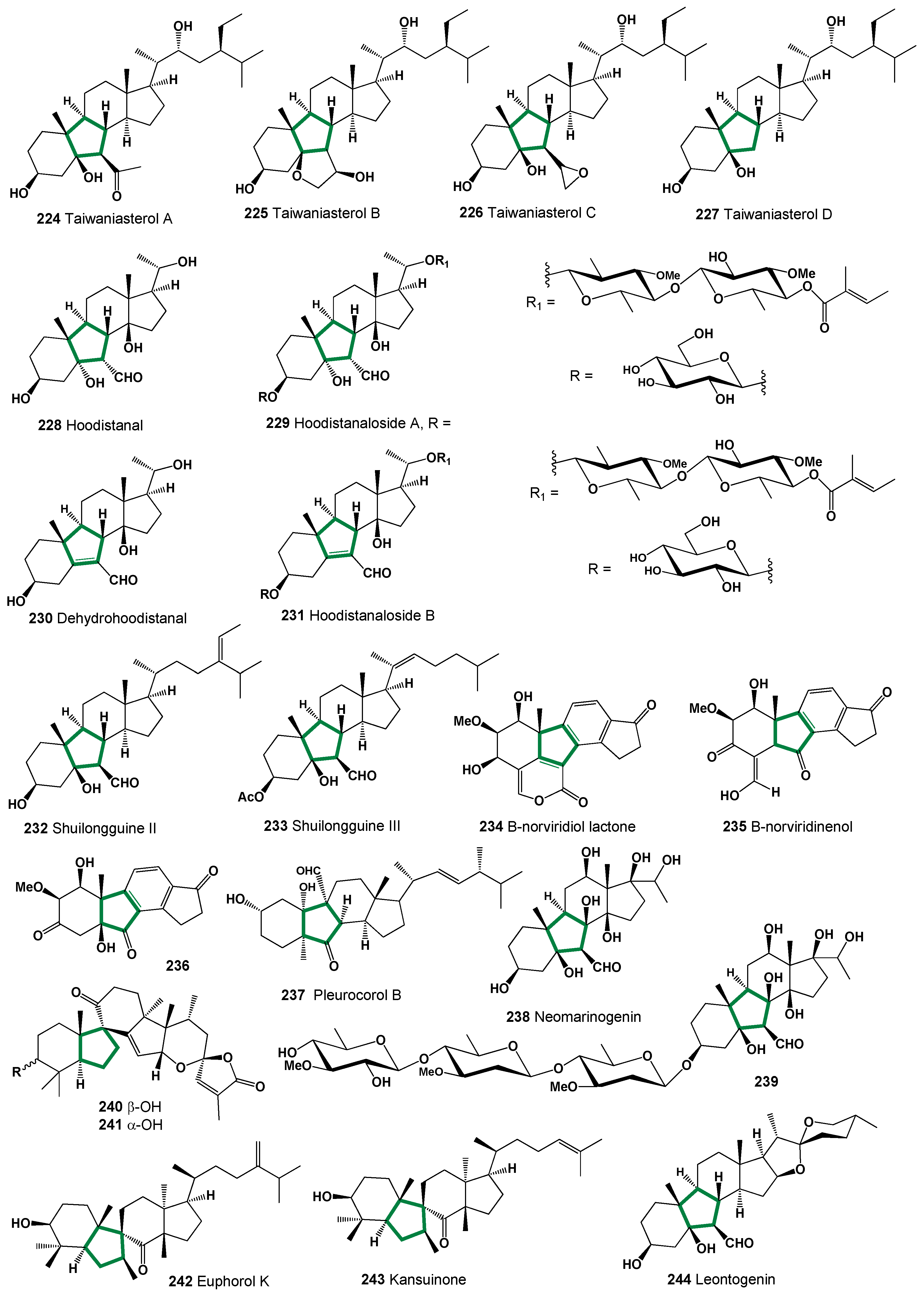
Taiwaniasterols A (224), B (225), C (226), and D (227), with a unique 6-5-6-5 fused ring skeleton, were isolated from the leaves of Taiwania cryptomerioides [159]. Hoodia gordonii, a succulent from the Kalahari Desert, has been used traditionally for various ailments and as an appetite suppressant. The analysis of its aerial parts led to the isolation of active pregnane glycosides, including hoodistanal (228, structures see Figure 16), dehydrohoodistanal (230), and hoodistanalosides (229 and 231) [160].
Figure 17.
Samples of plants and fungi in which B-nor steroids were found: a, Taiwania cryptomerioides, b, Hoodia gordonii, also known as Bushman’s hat, is a leafless spiny succulent plant supposed to have therapeutic properties in folk medicine. It grows naturally in Botswana, South Africa and Namibia, c, fern Polypodium niponicum, d, edible fungus Pleurotus cornucopiae.
Figure 17.
Samples of plants and fungi in which B-nor steroids were found: a, Taiwania cryptomerioides, b, Hoodia gordonii, also known as Bushman’s hat, is a leafless spiny succulent plant supposed to have therapeutic properties in folk medicine. It grows naturally in Botswana, South Africa and Namibia, c, fern Polypodium niponicum, d, edible fungus Pleurotus cornucopiae.
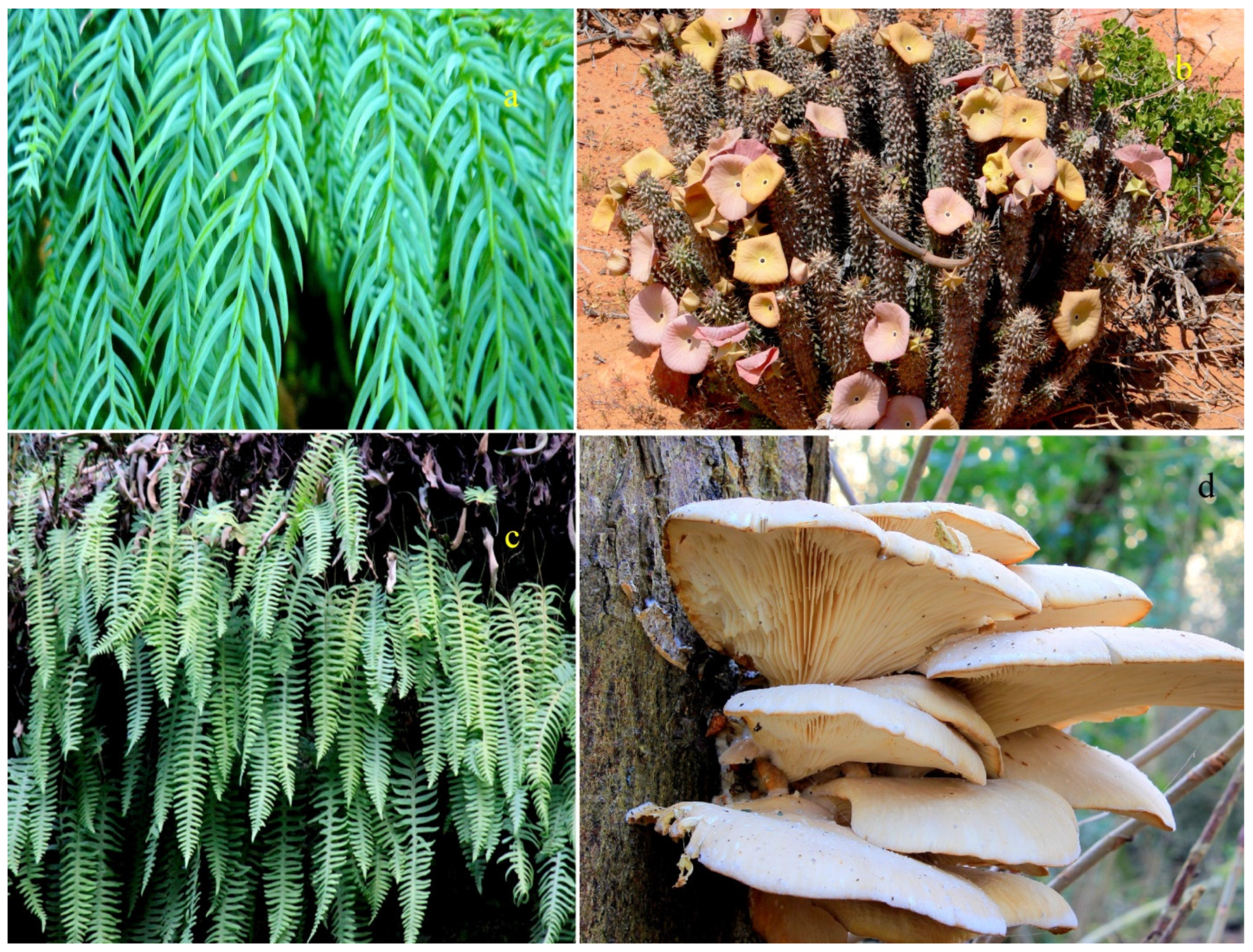
An ethanolic extract of Polypodium niponicum (Chinese name “Shuilonggu”, samples are shown in Figure 17) contained two steroids, shuilongguine II (232) and shuilongguine III (233) [161]. Viridin-related B-norsteroids, B-norviridiol lactone (234), and B-norviridin enol (235), both with unique unprecedented carbon skeletons, were isolated from Hymenoscyphus pseudoalbidus, a fungus responsible for ash dieback. Compound 235 degraded to another B-norsteroidal compound, 1β-hydroxy-2α-hydro-asterogynin A (236), later detected in the original culture [162].
The fruiting bodies of Pleurotus cornucopiae contain pleurocorol B (237) with an unprecedented carbon skeleton [163]. Neomarinogenin (238) and its C21 steroidal glycoside (239) were isolated from Marsdenia incisa [164]. Spirochensilides A (240) and B (241), unique triterpenoids with an 8,10-cyclo-9,10-seco and methyl-rearranged skeleton, were isolated from Abies chensiensis [165].
Euphorol K (242) was found in the water-methanol extract of the dried latex of Euphorbia resinifera, exhibiting cytotoxic effects against MCF-7 [166]. Kansuinone (243), a rearranged euphane triterpenoid with a spiro[5,6] ring system from Euphorbia kansui roots, showed inhibitory activity against 11β-HSD1 [167]. A B-ring contracted spirostane, leontogenin, 25(R)-B-nor(7)-6β-formyl-spirostane-3β,5β-diol (244), was isolated from an acid hydrolysate extract of Tacca leontopetaloides leaves [168].
Hoodia gordonii, a succulent native to the Kalahari Desert, is known for its appetite-suppressing properties and has gained popularity in Western countries as a dietary supplement. This plant contains B-nor-steroids, including hoodistanal (245), dehydrohoodistanal (247), and their glycosides, hoodistanaloside A (246) and B (248) [160].
An endophytic fungus from the small palm Asterogyne martiana produced two unusual steroid-like metabolites, asterogynin A (249) and asterogynin B (250), with potential antimalarial properties [169]. The antibiotic laschiatrion (251), isolated from the orange pore fungus Favolaschia sp. 87129 (samples are shown in Figure 18), exhibited broad in vitro activity against several human pathogens [170].
Phellibarin D (252), a B/C ring-rearranged lanostane triterpenoid with a 6/5/7/5 ring framework, was isolated from Phellinus rhabarbarinus. This compound showed cytotoxicity against human cancer cell lines and inhibited nitric oxide production in macrophages [171].
Echinochlorin C (253), detected in methanol extracts of Echinochloa utilis, and it displayed potential cytotoxic activity against HeLa cells, indicating possible therapeutic applications for cancer treatment [172].
Bufogargarizin (254) was isolated from Chan Su, a traditional Chinese medicine used in cancer treatment, showing weak cytotoxic activities [173]. Bufogargarizin A (255) with an unprecedented skeleton was discovered in the venom of Bufo bufo gargarizans [124], and bufogargarizin D (256) was found in the eggs of the same toad [174].
Premna fulva, used in Zhuang medicine, contained a unique metabolite, premnafulvol A (257), with a 6/5/7/3-fused tetracyclic carbon skeleton, isolated from its aerial parts [175]. Euphorbactin (258), a terpenoid with a similar fused-ring skeleton, was isolated from Euphorbia micractina [176].
Calvatianone (259), a sterol with a 6/5/6/5-fused ring system and a contracted tetrahydrofuran B-ring, was detected in Calvatia nipponica [177]. Kumemicinone D (260), a B/C-ring-rearranged product, was discovered in a deep-sea actinomycete Actinomadura sp. KD439, showing cytotoxicity against leukemia cells [178].
Officimalonic acid A (261), a 24-methyl-lanostane triterpene with a unique skeleton, was isolated from Fomes officinalis [179]. Spiromarienonols A (262) and B (263), triterpene lactones with unique structures, were isolated from Abies mariesii Masters [180].
Spiro-astraodoric acid (264), a lanostane-type triterpenoid with a spirocyclic structure, was discovered in Astraeus odoratus, exhibiting cytotoxicity against various cancer cell lines [181]. Spirosacraoic acid A (265), with a rearranged tirucallane skeleton, was isolated from Boswellia sacra [182].
Spiroseoflosterol (266), a unique ergostane steroid, was isolated from Butyriboletus roseoflavus, showing cytotoxicity against liver cancer cell lines [183]. Methyl ganosinensate A (267), ganosinensic acid A (268), and ganosinensic acid B (269), triterpenoids with a four-membered ring, were isolated from Ganoderma sinense [184].
Teuviscin A (270), a triterpenoid with a rare 7(8→9)-abeo-9R-D:C-friedo-B':A'-neo-gammacerane skeleton, was isolated from the whole plants of Teucrium viscidum [185]. Additionally, other triterpenes (271, 272, and 273, structures see Figure 19) featuring the 11(10→8)-abeo-lanostane carbon skeleton were extracted from the bark of Garcinia speciosa [186].
Figure 18.
Samples of fungi that produce B-nor steroids: a, Favolaschia sp., commonly known as the orange pore fungus, is a species of fungus in the family Mycenaceae. Due to its form it is also known as orange pore conch or orange Ping-Pong bat; b, mushrooms Phellinus rhabarbarinus, soaked in wine has folk usages by local residents of Ailao mountain of Yunnan province, China, which were to daub the wound to prevent infection and to drink to enhance immunity and treat other diseases such as cough, gastritis, and cancer; c, Calvatia nipponica, puffball mushrooms in the genus Calvatia are used as food and traditional medicine for hemostasis and wound dressings, as well as to treat pharyngodynia; and d, fungus Fomes officinalis, The pulp extract of this mushroom tightens pores for oily and combination skin, and is a natural astringent that eliminates excessive secretions, smoothes, tightens and moisturizes the skin.
Figure 18.
Samples of fungi that produce B-nor steroids: a, Favolaschia sp., commonly known as the orange pore fungus, is a species of fungus in the family Mycenaceae. Due to its form it is also known as orange pore conch or orange Ping-Pong bat; b, mushrooms Phellinus rhabarbarinus, soaked in wine has folk usages by local residents of Ailao mountain of Yunnan province, China, which were to daub the wound to prevent infection and to drink to enhance immunity and treat other diseases such as cough, gastritis, and cancer; c, Calvatia nipponica, puffball mushrooms in the genus Calvatia are used as food and traditional medicine for hemostasis and wound dressings, as well as to treat pharyngodynia; and d, fungus Fomes officinalis, The pulp extract of this mushroom tightens pores for oily and combination skin, and is a natural astringent that eliminates excessive secretions, smoothes, tightens and moisturizes the skin.
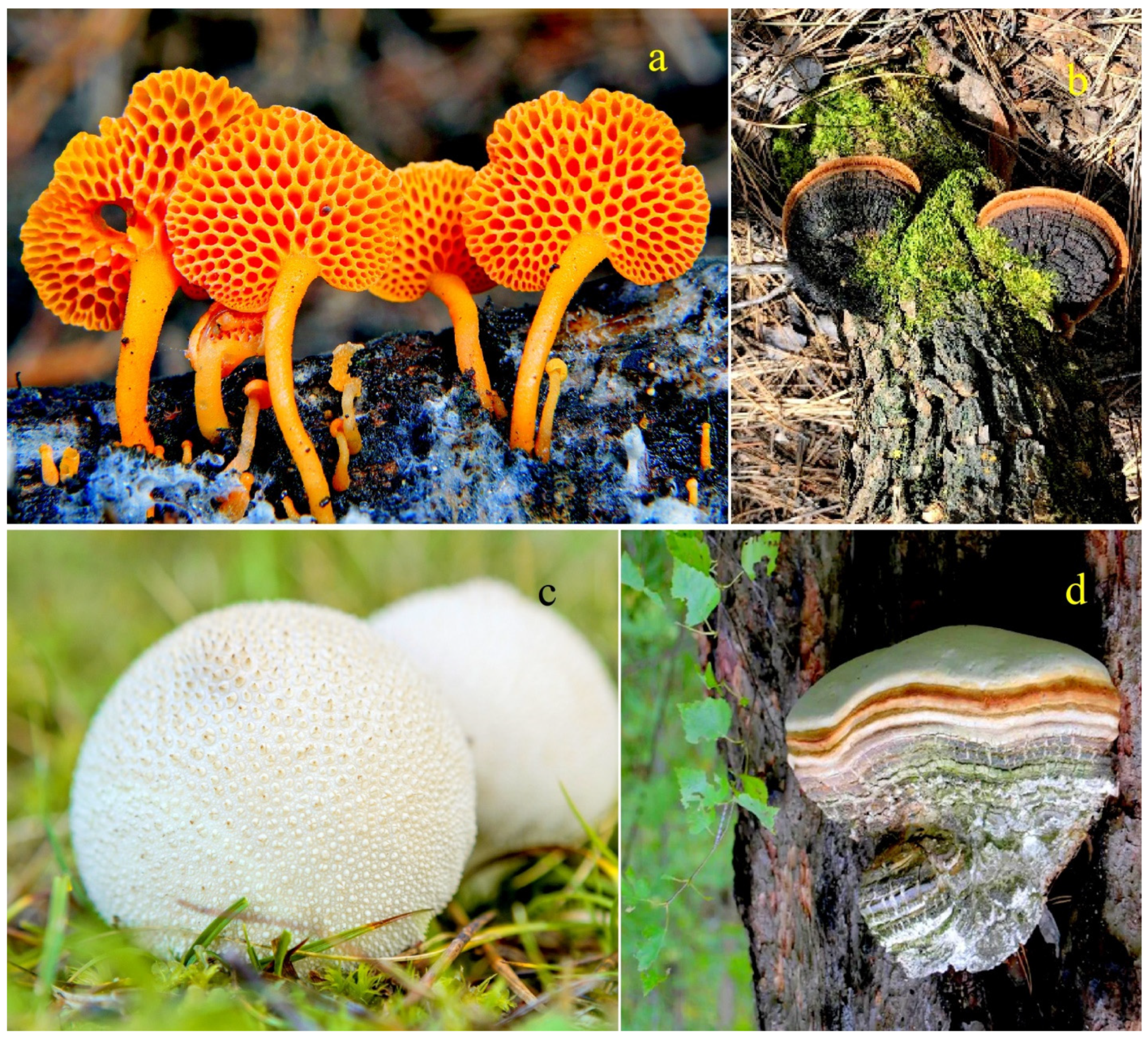
Figure 19.
B-nor steroids are isolated extracts of plants, fungi, and amphibians .
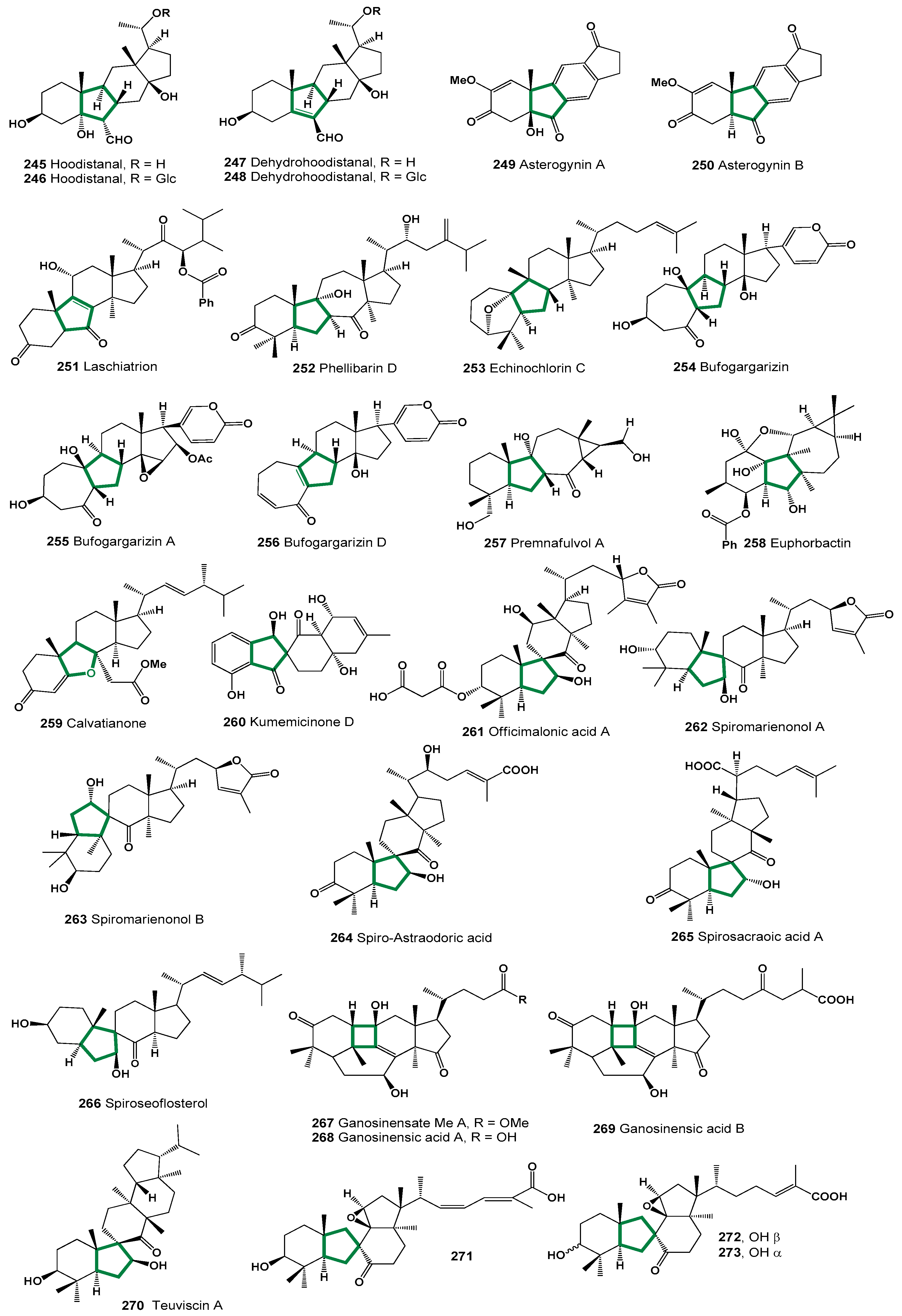
The aerial parts of Tricholepis eburnea, collected from the Ziarat valley in Pakistan's Balochistan province, contained a unique withanolide glucoside named trichoside B (274, structures see Figure 20). This compound was found in the n-butanolic fraction of a 75% methanolic extract [187], and it has also been previously identified in the plant Gypsophila trichotoma [188].
Figure 20.
B-nor steroids and their derivatives are isolated extracts of plants, and fungi,.
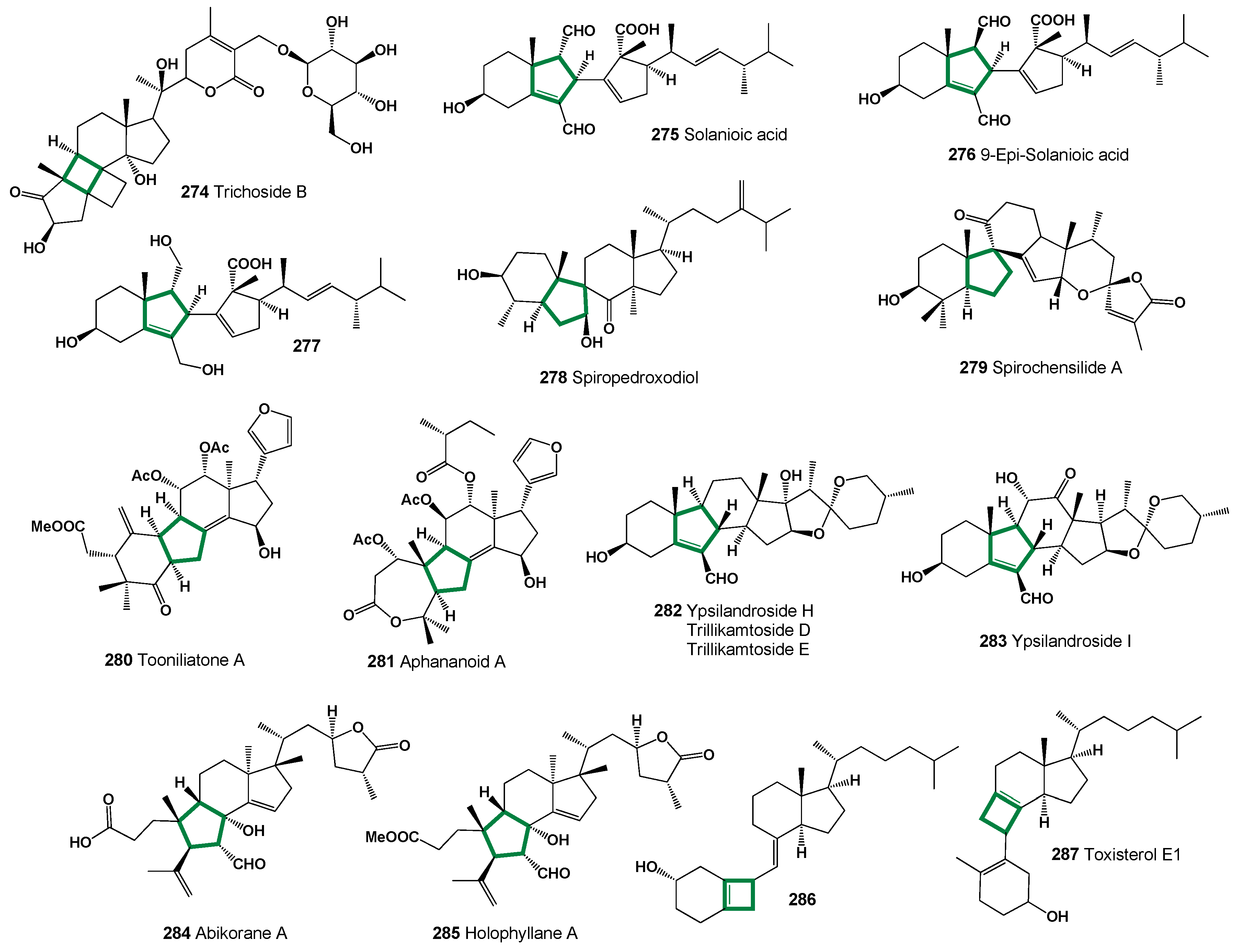
Solanioic acid (275), a degraded and rearranged steroid with in vitro antibacterial activity against methicillin-resistant Staphylococcus aureus (MRSA), was isolated from laboratory cultures of the fungus Rhizoctonia solani, sourced from tubers of Cyperus rotundus collected in Sri Lanka [189]. Subsequently, 9-epi-solanioic acid (276) and another compound (277) were discovered in the same fungus [190], and from the flowering plant Euphorbia pedroi (samples are shown in Figure 21), a tetracyclic triterpenoid with an unusual spiro scaffold, spiropedroxodiol (278), was isolated. This compound proved to be a potent MDR reversal agent in L5178Y-MDR and Colo320 cells [191]. A triterpenoid, spirochensilide A (279), with a unique 8,10-cyclo-9,10-seco and methyl-rearranged carbon skeleton, was found in extracts from the leaves of Abies chensiensis [192]. Tooniliatone A (280), a limonoid with an unprecedented 6/5/6/5 tetracarbocyclic skeleton, was isolated from Toona ciliata var. yunnanensis [193]. Another limonoid, aphananoid A (281), featuring a rare C24 appendage and a 5/6/5 fused-ring framework, was obtained from Aphanamixis polystachya. This compound inhibited nitric oxide production in the RAW2647 cell line [194].
N-nor steroids, featuring novel 5(6 → 7)-abeo-steroidal aglycones, ypsilandrosides H (282) and I (283), were obtained from the whole plants of Ypsilandra thibetica [195]. Additionally, two glycosides, trillikamtoside D and trillikamtoside E with aglycone structures similar to ypsilandroside H (282), were detected in the hemostatic fraction of the 75% aqueous ethanol extract of Trillium kamtschaticum [196].
Abikorane A (284), a nor-3,4-seco-17,14-friedo-lanostane triterpenoid isolated from the leaves of Abies koreana, showed strong cytotoxic activities against several cancer cell lines (A549, SK-OV-3, SK-MEL-2, and HCT-116) with IC50 values ranging from 0.89–9.62 μM. It also inhibited lipopolysaccharide-stimulated nitric oxide production (IC50 value of 11 μM) and exhibited a significant nerve growth factor release effect (192.54 ± 12.33%) from C6 glioma cells [197]. Holophyllane A (285), a triterpenoid with a B-nor-3,4-seco-17,14-friedo-lanostane structure, was isolated from the methanol extract of Abies holophylla trunks. It displayed moderate to weak cytotoxicity and significant inhibitory activity against nitric oxide (NO) production [198].
Two photoproducts of vitamin D were identified during photochemical processes. One, a cyclobutane-containing derivative (286), was identified [199], and a similar secosteroid, toxisterol E1 (287), a minor transformation product of vitamin D2, was found in various mushrooms [200]. Both steroids exhibit anti-hypercholesterolemic and hypolipidemic activities and act as inhibitors of cholesterol synthesis [1].
6. C-Nor Steroids Derived from Marine and Freshwater Sources
C-Nor steroids, characterized by a missing carbon atom(s) in the C ring of the steroid nucleus, are fascinating compounds produced by marine organisms like sponges, corals, and others. These unique molecules, often with significant biological activities, are products of the diverse marine environment, rich in ecological niches and biological interactions [4,5,7,12,18,21].
C-nor-steroids from marine sources display distinct biological properties due to their altered structures, which may include specific interactions with biological receptors, enzymes, or other targets. These properties are of keen interest in pharmacology and natural product chemistry, as they offer potential for new therapeutic applications, particularly in areas where conventional treatments are less effective [5,7,12,18,21,201,202,203].
An interesting fact is that in many C-nor steroids, as the C ring decreases, the D ring increases from five-membered to six-membered or seven-membered. The fact is indeed fascinating, especially in the context of organic chemistry and biochemistry [16,17,199,201]. In these compounds, as the size of the C ring (one of the rings in the steroid structure) decreases, the D ring compensates by increasing in size, often from five-membered to six-membered or even seven-membered. In chemical structures, ring tension plays a significant role in the stability of the molecule. Typically, five and six-membered rings are more stable and less strained than smaller or larger rings due to the angles between the atoms being closer to ideal tetrahedral angles (109.5°). So, a change in ring size can significantly impact the molecule's stability and reactivity. The change in ring size can alter the steric (spatial) and electronic (distribution of electrons) properties of the molecule [16,17,199,201,203]. This can affect how the steroid interacts with other molecules, such as receptors or enzymes, influencing its biological activity. In a biological context, the alteration in ring size might reflect an evolutionary adaptation. Different ring sizes could lead to different biological functions or interactions within organisms. Overall, the interplay between ring tension, molecular stability, and biological function in the context of changes in ring size in C-nor steroids is a remarkable example of the complexity and elegance of organic molecules. The deformed ring C in the C-nor steroids (288-421) is highlighted in pink in Figure 22, Figure 24, Figure 26 and Figure 27.
The exploration of C-nor-steroids is an integral part of the search for novel compounds in drug discovery. Their unique structural features, especially the modifications to the steroid nucleus, are of particular interest for their potential novel mechanisms of action or improved pharmacological profiles. For example, the tetracyclic and pentacyclic isomalabaricanes named rhabdaglostelones A (288), B (289), and C (290) from the marine sponge Rhabdastrella globostellata, showed cytotoxic activities toward various cancer cell lines [204]. 22,23-dihydro-24-nordankasterone A (291) from the sponge Luffariella variabilis exhibited cytotoxicity towards breast cancer cells [205].
The sea sponge Theonella swinhoei produces swinhoeisterols (A-F (292-297, and 298) with an unprecedented 6/6/5/7 ring system. These compounds have shown cytotoxicity towards lung and bone cancer cells, with compound 294 exhibiting an inhibitory effect on (h)p300 [206,207]. Abeohyousterone (299, structures see Figure 22) isolated from the Antarctic tunicate Synoicum adareanum, demonstrated moderate cytotoxicity against several cancer cell lines [208].
Akadisulfate A (300), a sulfated meroterpenoid with a hydroquinone moiety from the sponge Aka coralliphaga, and C-nor steroid 301, found in crude oil, represent the diversity of these compounds [209,210,211]. Rhabdaprovidine G (302), from the Vietnamese sponge Rhabdastrella providentiae (samples are shown in Figure 23), and salmahyrtisol A (303), from the Red Sea sponge Hyrtios erecta, showed significant cytotoxicity against various cancer cell lines [212,213,214]. Hippospongide A (304), similar to salmahyrtisol A, was isolated from Hippospongia sp. [215].
Figure 22.
C-nor steroids and triterpenoids derived from marine and freshwater organisms.
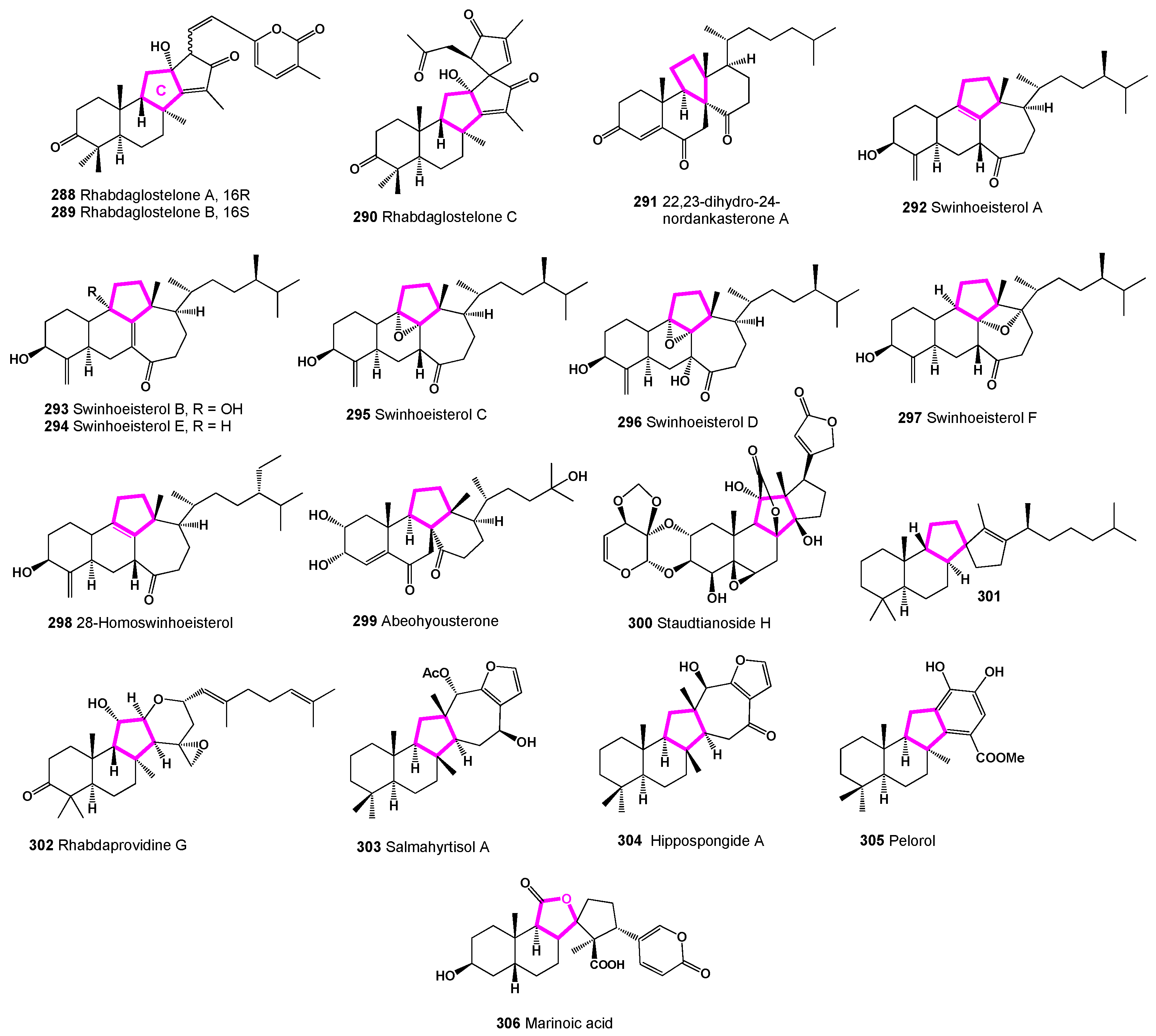
Pelorol (305), an aromatic substituted sesquiterpene from the tropical marine sponge Dactylospongia elegans, exhibited antitrypanosomal and antiplasmodial effects [216]. Marinoic acid (306), found in the skin of the toad Bufo marinus, showed inhibition of Na+, K+-ATPase enzymatic activity [217]. These findings underscore the rich potential of marine-derived C-nor steroids and related compounds in developing new pharmacological agents.
Figure 23.
Samples of marine invertebrates and amphibians in which C-nor steroids were found: a, marine sponge Rhabdastrella globostellata, b, marine sponge Theonella swinhoei, c, the toad, Bufo marinus, d, Red Sea sponge Hyrtios erecta.
Figure 23.
Samples of marine invertebrates and amphibians in which C-nor steroids were found: a, marine sponge Rhabdastrella globostellata, b, marine sponge Theonella swinhoei, c, the toad, Bufo marinus, d, Red Sea sponge Hyrtios erecta.
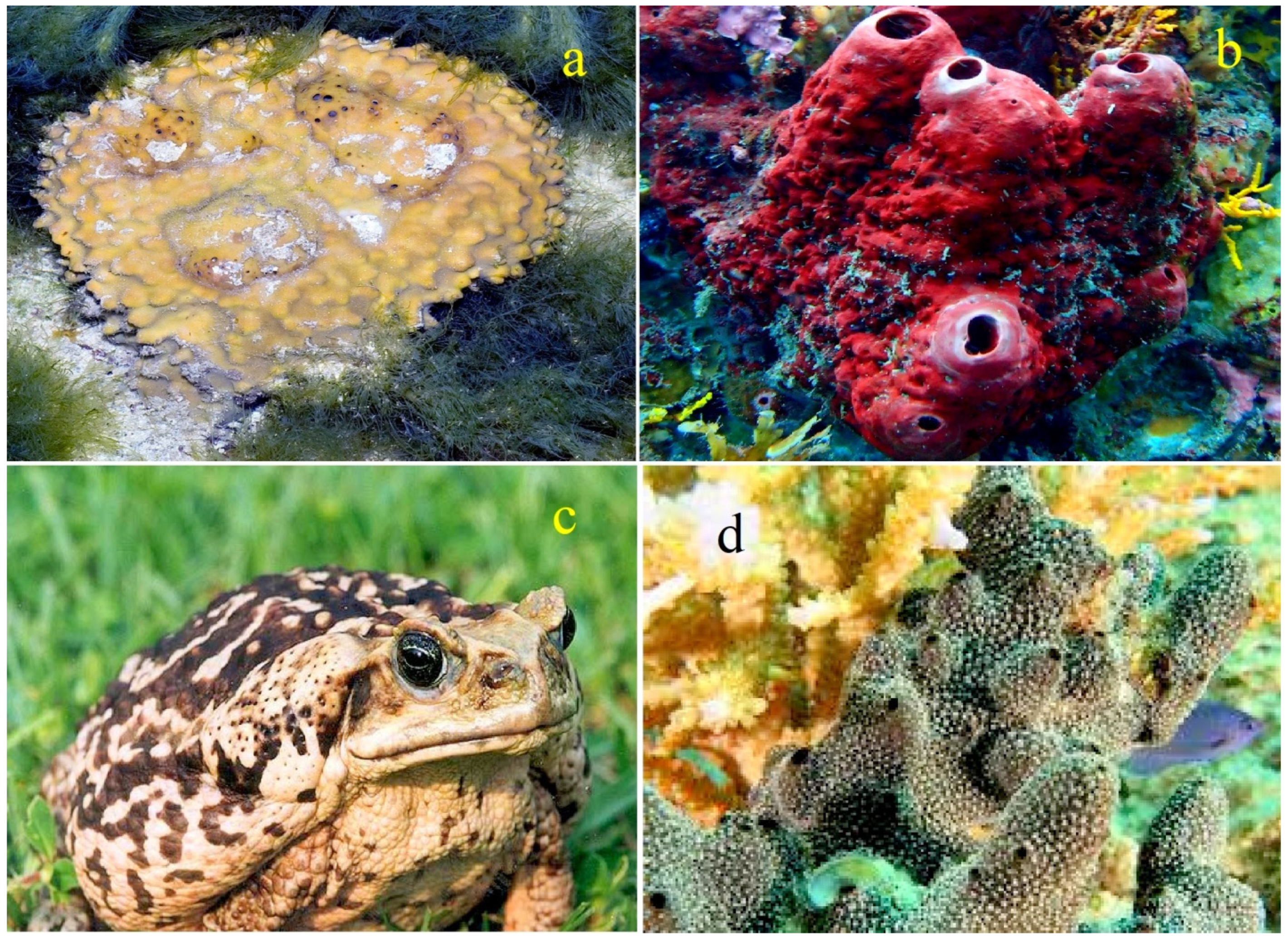
7. C-Nor Steroids Derived from Fungi and Fungal Endophytes
Periconiastone A (307), an ergosterol with an unprecedented pentacyclo-[8.7.0.01,5.02,14.010,15]-heptadecane system, was isolated from the fungus Periconia sp. TJ403-rc01. It exhibited antibacterial activity against Gram-positive S. aureus and E. faecalis with MIC values of 4 and 32 μg/mL, respectively [218]. Dankasterone A (308) and dankasterone B (309), produced by the endophytic fungus Phomopsis sp. YM355364 from Aconitum carmichaeli, showed significant inhibitory activity against influenza A and moderate antifungal activities against four pathogenic fungi [219].
Phomopsterone B (310), an ergostane-type steroid isolated from Phomopsis sp. TJ507A, exhibited anti-inflammatory activity [220]. Pleurocorol A (311), an 11(9→8)-abeo-ergostane steroid from Pleurotus cornucopiae, showed inhibitory effects on nitric oxide production and cytotoxic activity against cancer cell lines [163].
Emeridones A (312), D (313), E (314), and F (315, structures see Figure 24), 3,5-demethylorsellinic acid-based meroterpenoids from Emericella sp. TJ29, were isolated. Emeridone A represents the first meroterpenoid with a unique rigid 6/6/5/6 tetracyclic ring system; compounds 313 and 315 exhibited moderate cytotoxic activities [221].
Figure 24.
C-nor steroids produced by fungi and isolated from their extracts.

Figure 25.
Samples of fungi that produce C-nor steroids: a, edible mushrooms Pleurotus cornucopiae, b, Ganoderma applanatum, a wood-decay fungus, causing a rot of heartwood in a variety of trees; c, cultures of the ascomycete Dasyscyphus niveus was isolated from spore prints of fruiting bodies growing on a dead twig of beech wood; d, Stereum sp., the type genus of the Stereaceae family of fungi, in the Russulales order.
Figure 25.
Samples of fungi that produce C-nor steroids: a, edible mushrooms Pleurotus cornucopiae, b, Ganoderma applanatum, a wood-decay fungus, causing a rot of heartwood in a variety of trees; c, cultures of the ascomycete Dasyscyphus niveus was isolated from spore prints of fruiting bodies growing on a dead twig of beech wood; d, Stereum sp., the type genus of the Stereaceae family of fungi, in the Russulales order.
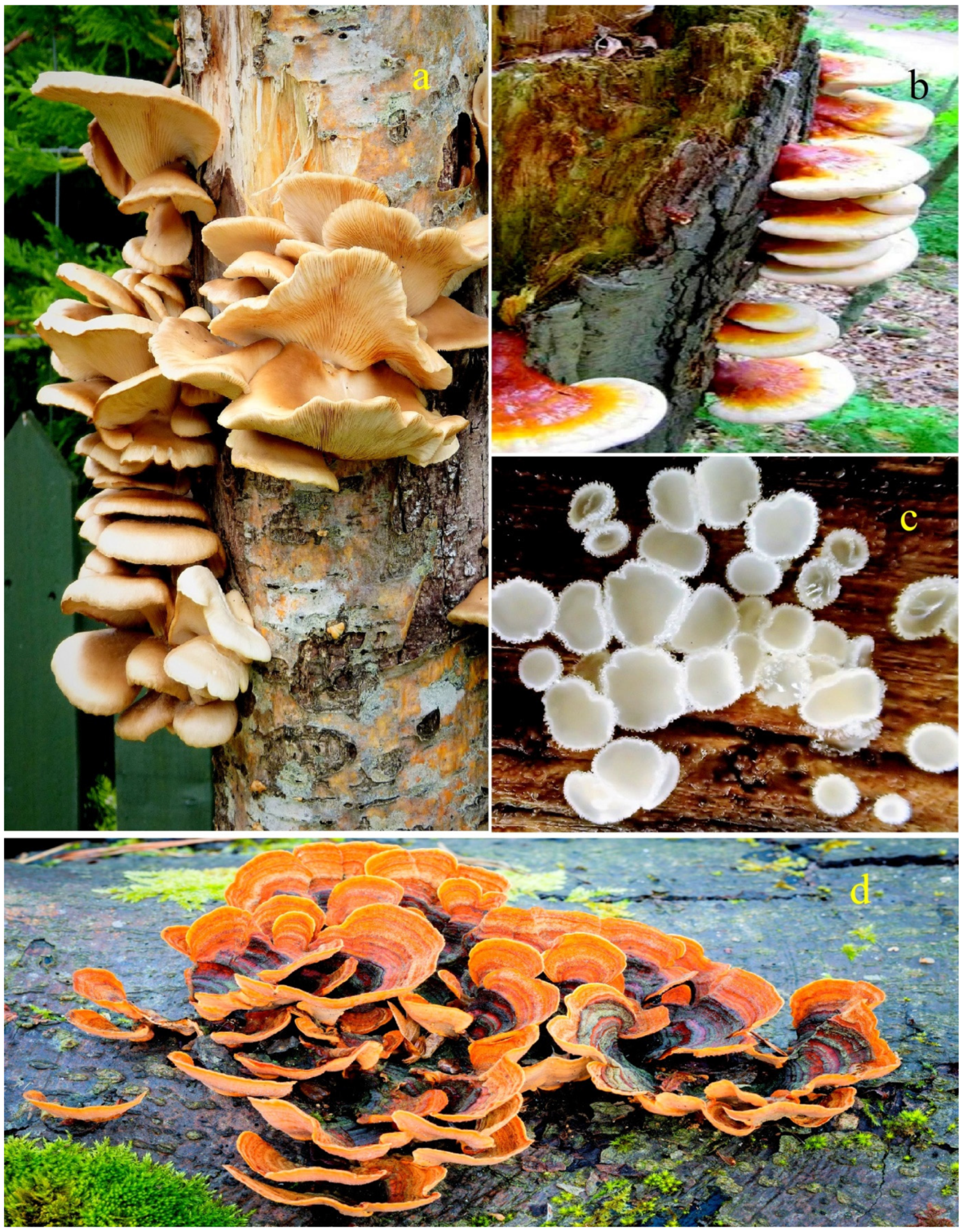
Applanoids A (316), B (317), and C (318) with a 6/6/5/6/5 pentacyclic system, isolated from Ganoderma applanatum (samples are shown in Figure 25), activated the human pregnane X receptor [222]. Gloeophyllin A (319), an ergosteroid from Gloeophyllum abietinum, showed cytotoxicity against human cancer cell lines [223].
Dasyscyphins A (320), B (321), C (322), D (323), and E (324) from Dasyscyphus niveus exhibited cytotoxic activities against various human cell lines, with dasyscyphins D and E inhibiting the germination of Magnaporthe grisea conidia [224,225].
Ganoapplanic acid A (325) and B (326), along with ganodapplanoic acids A (327) and B (328) from Ganoderma applanatum, featured an uncommon C-13/C-15 oxygen bridge in a rearranged lanostane-type triterpenoid structure [4,226]. Ganolearic acid A (329), a rare 3/5/6/5 tetracyclic system triterpenoid, was found in Ganoderma cochlear, along with ganocochlearic acid A (330), a hexanorlanostane [227,228].
Sterenoids A–L (331-342) from Stereum sp., rare 14(13→12)-abeo-lanostane triterpenoids with 13R configurations, were isolated, with compound 336 showing potent cytotoxic activities [229]. Lanostane (343) was identified in Ganoderma lucidum [230]. These findings highlight the diversity and potential pharmacological importance of steroids and triterpenoids from various natural sources.
8. C-Nor Steroids Derived from Plant Species
C-nor steroids, a class of steroids with a structural modification in the C ring, are represented by C23 terpenoids like apianane (344, structures see Figure 26) and its derivatives found in Salvia apiana. Derivatives such as 14-hydroxy-7-methoxy-11,16-diketo-apian-8-en-(22,6)-olide (345) and 7-methoxy-11,16-diketo-apian-8,14-dien-(22,6)-olide (346) have been identified in this plant [231]. Additionally, three other apianane terpenoids from Salvia officinalis, with complex structures, were isolated (347, 348, and 349) [232].
Cardenolide (350), with distinct antibacterial activity, was isolated from the seeds of the Cameroonian medicinal plant Salacia staudtiana [233]. Neoabiestrine D (351), E (352), and F (353) are cytotoxic rearranged lanostanes from Abies recurvata, with compound 352 showing potent anti-proliferative effects [234]. Abiestetranes A (354) and B (355), unique tetraterpenes, were found in Abies fabri, demonstrating significant cytotoxic activities [234]. Lanostanes 356 and 357, with a unique 8(14→13)-abeo-17,13-friedo moiety, were isolated from Abies nukiangensis [235].
Forrestiacids C (358) and D (359), rearranged spiro-lanostenes with an abietene from Pseudotsuga forrestii, inhibited key enzymes in the lipogenesis pathway [236]. CD-spiro-triterpenoids spirocaracolitones B (360), D (361), and 362 were identified in Ruptiliocarpon caracolito [237].
Officinalins A (363) and B (364), novel C23 terpenoid epimers from Salvia officinalis, feature a unique carbon skeleton and showed NO inhibitory activity [238]. Abibalsamins A (365) and B (366), tetraterpenoids from Abies balsamea exhibited cytotoxicity against cancer cell lines [239].
Petilium raddeana yielded steroidal alkaloids edpetiline (367) and edpetine (368) [240,241]. Jervine (369) and veratramine (370), and C-nor-D-homo-steroids 371-377, were found in Veratrum species and are known for their teratogenic effects, while some veratrum alkaloids have hypotensive applications [242,243,244,245]. Fischeriana A (378, structures see Figure 27), a meroterpenoid from Euphorbia fischeriana, showed anti-tumor activities [246], and two C-nor-D-homo-estrones (379 and 380) were discovered in the Solanum family [245]. These diverse compounds highlight the potential of C-nor steroids in various therapeutic applications.
Figure 26.
C-nor steroids isolated from plant extracts.

The genus Kadsura, belonging to the Schisandraceae family and native to Asia, has been a rich source of biologically active steroids and triterpenoids, including numerous nor-steroids [247]. From Kadsura coccinea, two triterpenoid epimers, kadcoccitones A (381) and B (382), were isolated, featuring an unprecedented 6/6/5/5-fused tetracyclic system and a C9 side chain. These compounds demonstrated anti-HIV-1 activity [248]. Neokadsuranic acid A (383) from Kadsura heteroclita and neokadsuranic acid C (384) from Kadsura longipedunculata, both with a 14(13→12)-abeo-lanostane skeleton, were identified [249,250].
Figure 27.
C-nor steroids isolated from plant extracts.
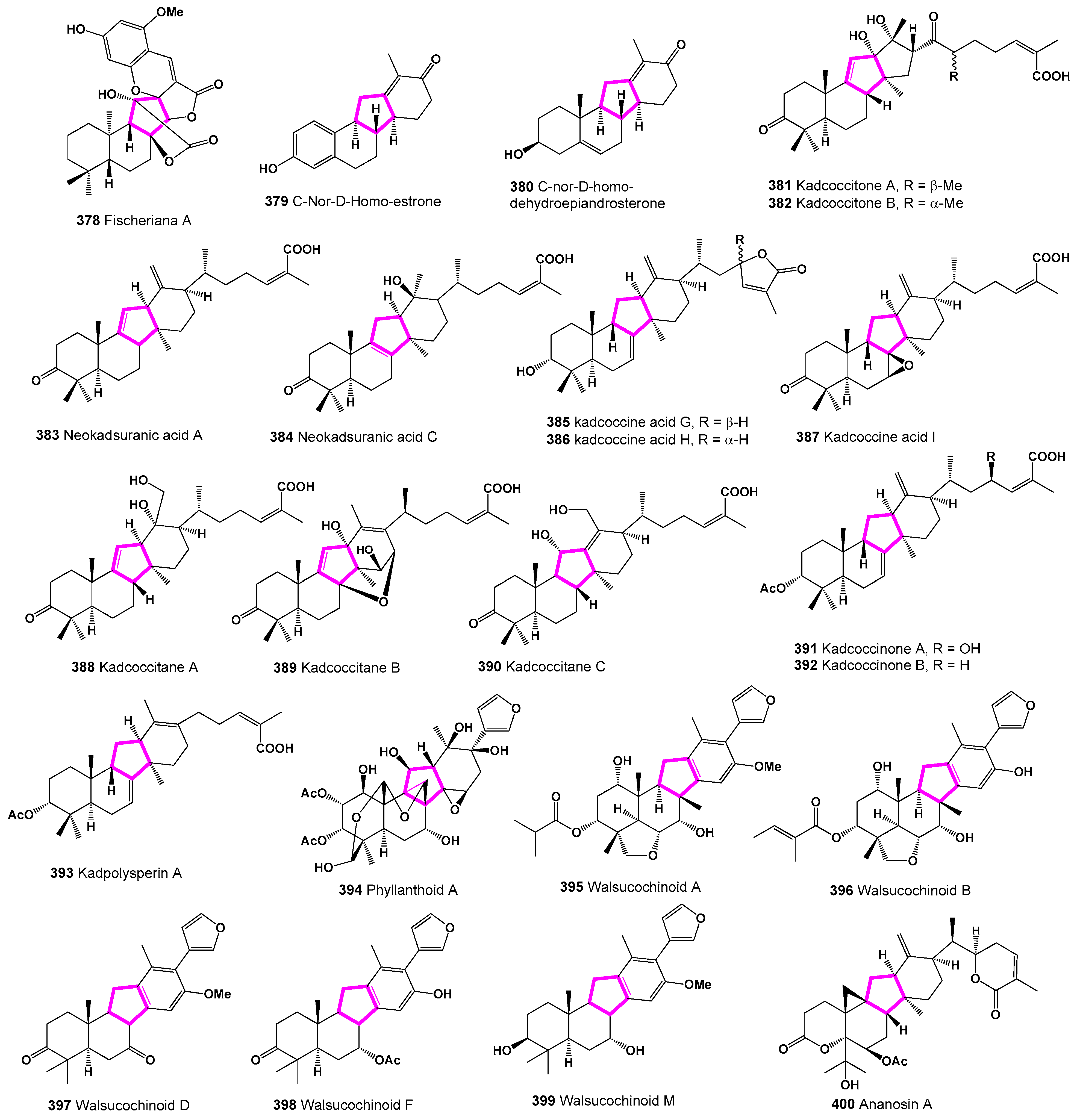
Figure 28.
C-nor steroids derived from plants, or individual parts of leaves, fruits.
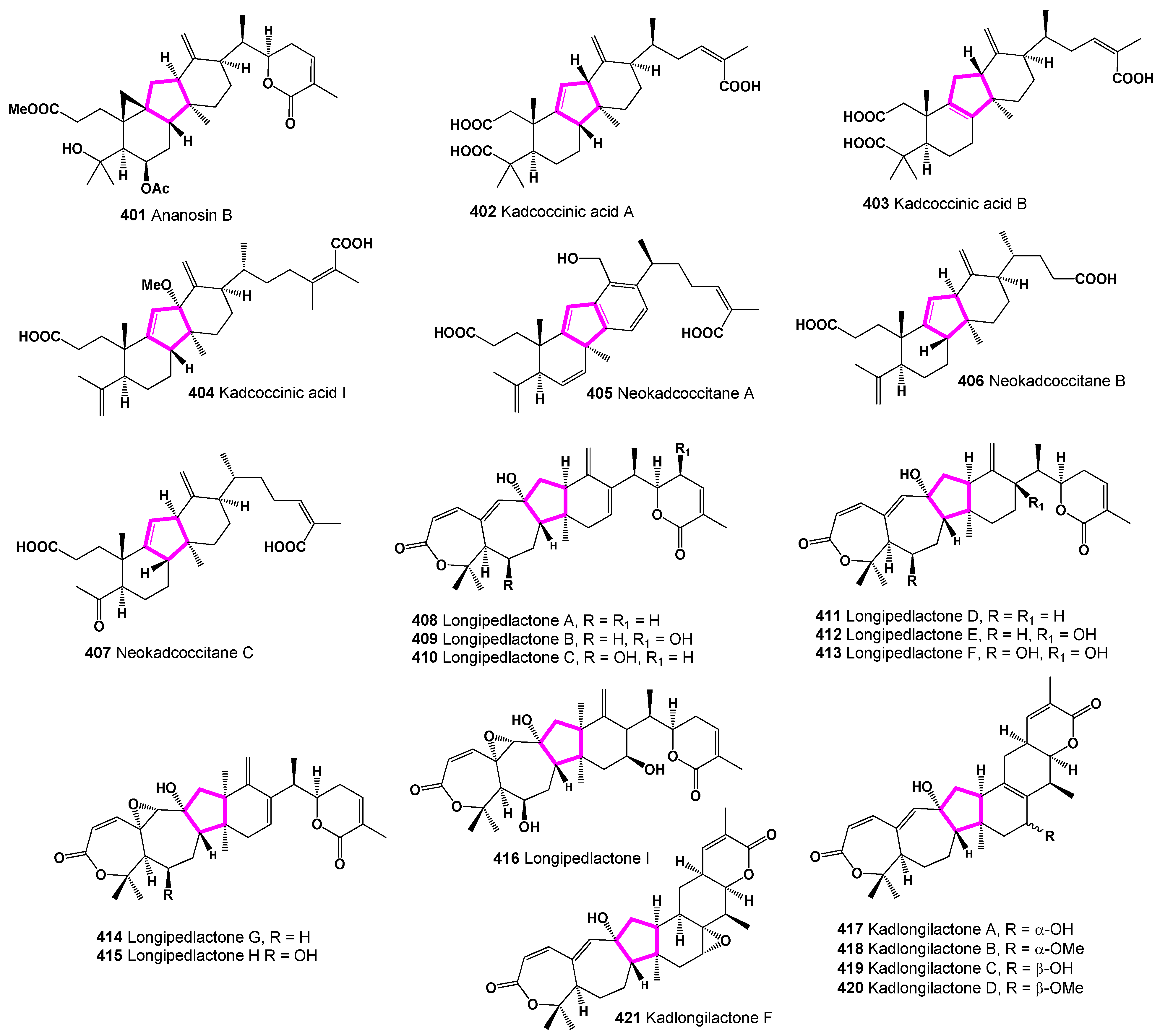
Kadcoccine acids G (385), H (386), and I (387) from Kadsura coccinea showed cytotoxicity against various human tumor cell lines [251]. Kadcoccitanes A (388), B (389), and C (390) from the roots of the same plant, with compound 390 exhibiting anticoagulant activity, were isolated [252]. Kadcoccinones A (391) and B (392) were also detected in Kadsura coccinea [253].
Kadpolysperin A (393), a cytotoxic lanostane triterpene from Kadsura polysperma, demonstrated effectiveness against multiple human tumor cell lines [254]. Phyllanthoid A (394) from Phyllanthus cochinchinensis displayed moderate antifeedant activity against Spodoptera exigua and cytotoxicity against the MCF-7 cell line [255]. Several walsucochinoids (395-399) from Walsura cochinchinensis, with a unique carbon framework, were also isolated [256].
Figure 29.
Samples of plants, or individual parts of leaves, fruits in which C-nor steroids were found: a, Petilium raddeana, b, Veratrum califoricum, c, Euphorbia fischeriana, d, Phyllanthus cochinchinensis, e, Kadsura heteroclita.
Figure 29.
Samples of plants, or individual parts of leaves, fruits in which C-nor steroids were found: a, Petilium raddeana, b, Veratrum califoricum, c, Euphorbia fischeriana, d, Phyllanthus cochinchinensis, e, Kadsura heteroclita.

Ananosins A (400) and B (401) from Kadsura ananosma, with rearranged 5/6 consecutive carbocycle rings, were identified [257]. Kadcoccinic acids A (402), B (403), and I (404, structures see Figure 28) from Kadsura coccinea, representing 2,3-seco-6/6/5/6-fused tetracyclic triterpenoids, were isolated [258].
Neokadcoccitane A (405) from Kadsura coccinea, along with two other 14(13→12)-abeo-3,4-seco-norlanostane triterpenoids (406 and 407), showed moderate anti-platelet aggregation activity [259]. Longipedlactones A–I (408-416) from Kadsura longipedunculata exhibited significant cytotoxicity against various cancer cell lines [260]. Kadlongilactones A−F (417−421) from the same plant also demonstrated notable cytotoxicity [261]. These diverse compounds from Kadsura species (plant samples are shown in Figure 29) highlight the potential of this genus in contributing to the discovery of novel pharmacologically active natural products.
9. D-Nor Steroids
The absence (excluding terpenoids (422a and 422b), which are found in Petunia patagonica [262]) of naturally occurring classic D-norsteroids (where the D ring is decreased in size) and the existence of stable synthesized D-norsteroids is a fascinating aspect of steroid chemistry [71]. This scenario can be attributed to several factors. In nature, the biosynthesis of steroids follows specific enzymatic pathways that are evolutionarily optimized for producing certain structures. These natural pathways may not favor the formation of D-nor steroids with a decreased D ring, possibly due to the structural and enzymatic constraints in the organisms that synthesize steroids. The stability of a steroid is significantly influenced by its ring structure. In general, five and six-membered rings are more stable due to less ring strain. Decreasing the size of the D ring (for example, from five members to four) can increase the ring strain, making such structures less favorable and potentially less stable in natural conditions. In contrast to natural biosynthetic limitations, synthetic chemistry allows for greater flexibility in creating novel structures. Chemists can use various techniques to synthesize and stabilize structures that do not occur naturally, including D-norsteroids with a decreased D ring. These methods can involve using different reaction conditions, catalysts, or protecting groups that are not available in biological systems. The steroids naturally produced by organisms are typically those that have functional and biological significance, such as hormones like testosterone and estrogen. The absence of naturally occurring D-norsteroids with a decreased D ring suggests that such structures may not have a role or advantage in biological systems, or they could be less efficient in carrying out the necessary biological functions. The diversity of chemical structures found in nature is a result of millions of years of evolution, driven by natural selection and ecological needs. Structures that are not advantageous or are less efficient in a biological context may not be favored in natural selection, leading to their absence in natural products.
D-norsteroids are synthetic steroids distinguished by the removal of a methyl group from the carbon at position 19 of the steroid nucleus. This modification alters the molecule's shape and properties, potentially leading to different biological activities and pharmacological profiles. D-nor steroids are researched for applications in hormone therapy, contraception, and treatment of various medical conditions [262,263,264]. The deformed ring D in the D-norsteroids (423-432) is highlighted in blue in the Figure 30 and Figure 31.
During the 1960s and 1970s, significant research was conducted on the synthesis of D-nor steroids (423-432) incorporating the cyclobutane fragment, investigating their potential as hormonal drugs for reproductive system conditions, hypertension, and various cancers [265,266,267,268,269,270,271,272,273,274].
Using the nor-steroid methodology, C20-terpenoids (433-449), isolated from various plant species, can be categorized as classical D-nor steroids. In these compounds, the D ring is reduced by two carbon atoms. Notably, while the biosynthetic pathways of typical steroids and terpenoids (434-449) may differ, they share a common structural framework. Mimosol D (433, structures see Figure 30) has been identified in extracts from Caesalpinia bonducella seeds and C. mimosoides roots. This compound exhibits significant anti-inflammatory properties, demonstrated by its ability to inhibit the production of inflammatory mediators NO and TNF-α with IC50 values of 3 μM and 6.5 μM, respectively [275]. Additionally, the isopimarane C20-terpene, smardaesidin A (434), was isolated from the endophytic fungal strain Smardaea sp. AZ0432, found in the photosynthetic tissue of the moss Ceratodon purpureus [276].
Figure 30.
Natural and synthetic D-nor steroids.
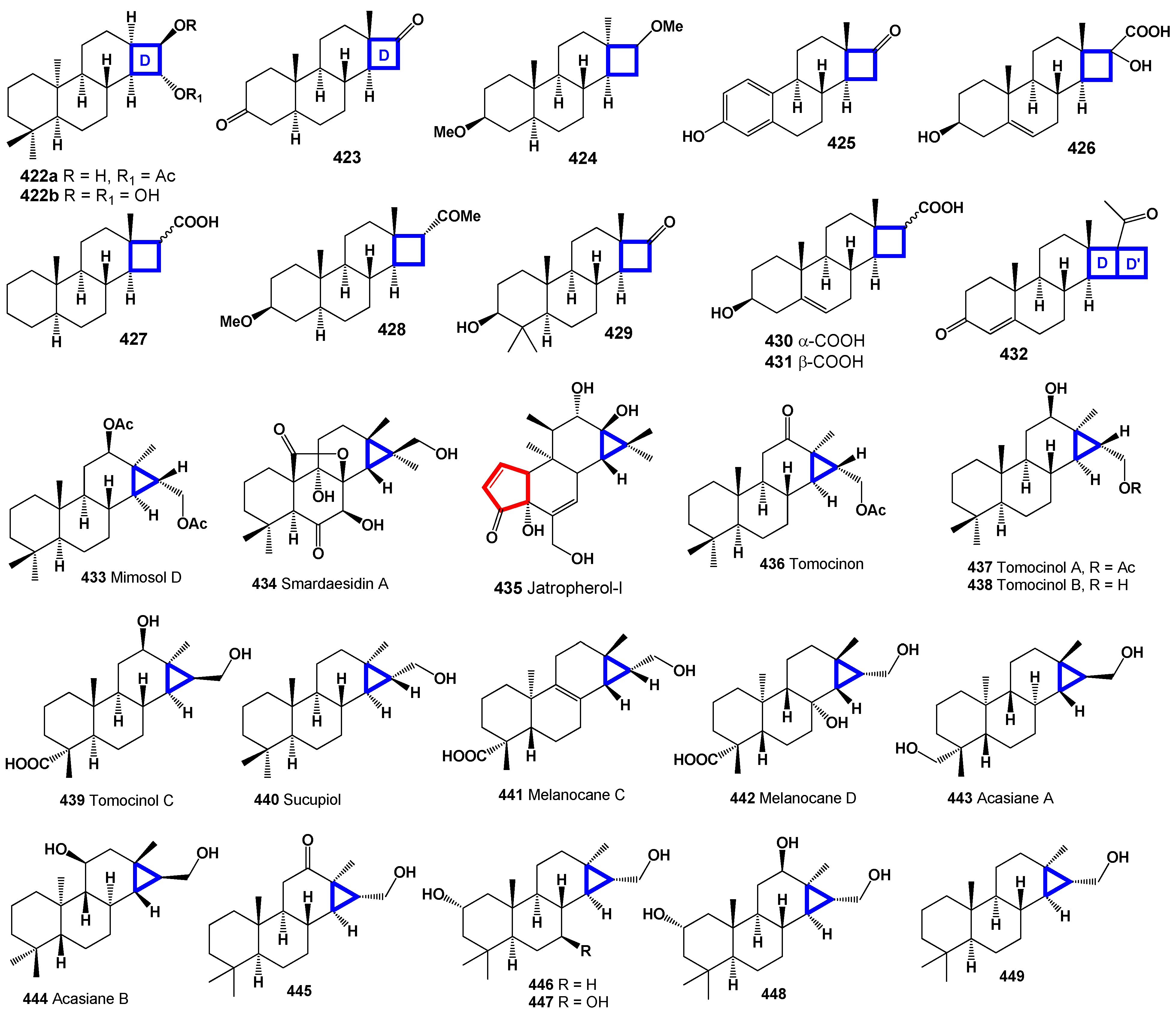
Jatropherol-I (435), a phorbol-type C20-terpene, was extracted from Jatropha curcas seeds using ultrasonic extraction, constituting 0.04% of the seed weight. It exhibited notable insecticidal activity against several species, including Bombyx mori, Lipaphis erysimi, and Pieris rapae. Jatropherol-I was more effective against B. mori compared to P. rapae. After 72 hours of exposure, the lethal concentration (LC50) for B. mori was 0.22 μg/mL and for P. rapae was 0.83 μg/mL. Additionally, its antifeedant concentration (AFC50) was 0.14 μg/mL for B. mori and 0.57 μg/mL for P. rapae. This compound also demonstrated contact toxicity against aphids with an LC50 of 0.11 μg/insect and an AFC50 of 18 μg/mL for L. erysimi. The oral toxicity of Jatropherol-I to mice was measured at 82.2 mg/kg body weight. Its mechanism of action is believed to involve activating protein kinase C (PKC). Jatropherol-I not only activates PKC in vitro but also in vivo. In vitro studies showed a 4.99-fold increase in PKC activity in silkworm mid-gut cells at 100 μg/mL compared to the control. In vivo, both the activity of PKC and phosphorylation levels increased with higher dosages and prolonged exposure [277,278]. When isolated from Jatropha curcas oil and seed kernel, Jatropherol-I was highly toxic to third instar silkworm larvae, with LC50 values of 0.58, 0.22, and 0.16 μg/mL at 48, 72, and 120 hours, respectively. This acute toxicity correlated with changes in midgut enzyme activities and pathological alterations in mid-gut epithelial cells [277,278].
Three cleistanthane C20-terpenes, namely tomocinon (436), tomocinol A (437), and tomocinol B (438), were isolated from the ethyl acetate (EtOAc) extract of Caesalpinia sappan seeds. These compounds (436-438) represent a novel class of antiausterity agents, displaying preferential cytotoxicity against the PANC-1 human pancreatic cancer cell line under nutrient-deprived conditions, with PC50 values of 34.7 μM, 42.4 μM, and 39.4 μM, respectively [279]. Additionally, tomocinol C (439) was discovered in the seeds of the same species [280]. A pimarane-type diterpenoid, sucupiol (440), was isolated from Bowdichia virgilioides seeds, suggesting the presence of an intermediate in the biosynthesis of furanocassane-type diterpenoids [281]. Two cytotoxic diterpenoids, melanocane C (441) and D (442), were obtained from the roots of Aralia melanocarpa [282], while acasiane A (443) and acasiane B (444) were isolated from Acacia farnesiana roots [283]. Several other diterpenoids (445-449) were found in extracts from seeds, roots, leaves, or bark of trees belonging to the Euphorbiaceae, Fabaceae, Leguminosae, and Rosaceae families [284,285,286,287,288,289].
Another interesting group of terpenoids, which can be classified as classic D-nor steroids, includes those containing the gem-dimethylcyclopropyl unit, particularly the tigliane and jatropholane types. These metabolites synthesized by plants share a common intermediate, casbene, formed by cyclizing geranylgeranyl pyrophosphate and retaining the cyclopropane ring ultimately [290,291,292,293]. Literature indicates two types of C20-terpenoids, tigliane (450, structures see Figure 31) and jatropholane, which can be considered D-nor steroids.
Tigliane C20-terpenoids are predominantly found in the Thymelaeaceae and Euphorbiaceae plant families. Their structural diversity stems from the presence of polyoxygenated functionalities within their polycyclic skeletons. These diterpenoids are known for their toxicity, yet they have demonstrated a range of biological activities, including anti-cancer, anti-HIV, and analgesic effects, making them significant in the field of natural product drug discovery. Tigliane diterpenoids feature a 5/7/6/3 (A/B/C/D) fused tetracyclic structure, with the D-ring forming a gem-dimethylcyclopropane ring. In tiglianes isolated from Thymelaeaceae plants, the A/B and B/C rings are trans-fused, while the C/D ring is cis-fused. A notable compound within this group is phorbol (451), characterized by an α,β-unsaturated ketone in the A-ring, a C-6 to C-7 double bond, a primary hydroxy group at C-20, a secondary hydroxy group at C-12, and tertiary hydroxy groups at C-4, C-9, and C-13. Phorbol esters, the most canonical class of tiglianes, are derivatives where the hydroxy groups at C-12, C-13, or C-20 of phorbol are esterified. Additionally, there is 12-deoxytigliane, which lacks a substituent at C-12. While most known tiglianes are from Euphorbiaceae plants, those from Thymelaeaceae exhibit diverse oxidative modifications on the B-ring, highlighting their structural variety [294,295,296,297].
Phorbol (451) was first identified in 1934 as a hydrolysis product of croton oil, derived from the seeds of Croton tiglium, the purging croton [298]. Another protein kinase C activator, prostratin (452), was discovered in Euphorbia species [299].
Figure 31.
Tigliane and jatropholane-type terpenoids derived from natural sources.

The Australian blushwood tree, Fontainea picrosperma, is known for its kernels that yield veterinary anticancer drugs like phorbol (453), 5β-hydroxy-6α,7α-epoxyphorbol (454), and phorbol diesters (455) [300]. Recently, Huang and colleagues [301] discovered two new tigliane diterpenoids through the hydrolysis of phorbol: 4β,9α,20-trihydroxy-14(13→12)-abeo-12βH-1,6-tigliadiene-3,13-dione (456) and 4β,9α,13,13,20-pentahydroxy-14(13→12)-abeo-12βH-1,6-tigliadiene-3-one (457). These compounds feature a cyclobutane D ring. Furthermore, chemical analysis of the roots of Euphorbia ebracteolata yielded a rare 14(13→12)-abeo-tigliane diterpenoid (458) [302], a unique case of a C20 steroid with a cyclobutane ring, indicating the potential discovery of D-nor steroids in the future.
Figure 32.
Natural terpenoids with D-ring removed.

Additionally, tigliane diterpenoids form a substantial group of biologically active metabolites, known for their anti-HIV-1 properties and activation of protein kinase C [303,304,305]. Two diterpenes, lagaspholones A (459) and B (460), were isolated from the methanol ice extract of Euphorbia lagascae. Both compounds exhibit a rare jatropholane-type skeleton with a 5:6:7:3 fused ring system [306]. Three jatropholane-type diterpenoids, jatropholones C (461), D (462), and E (463), were isolated from the roots of Jatropha curcas [307]. Similar C20-terpenoids, named sikkimenoids A–D (464-467), were found in the extracts of the aerial parts of Euphorbia sikkimensis [308].
Nature, compensating for the absence of classic D-nor steroids in living organisms, offered variants of pseudo D-nor steroids by removing the D ring at a distance of one chemical bond carbon-carbon (C-C) bond (for example, strophasterols (468-473, and/or tricholumin A (474). The carbon-carbon (C-C) bond distances in steroids, like in most organic molecules, can vary slightly depending on the specific structure and environment of the molecule. In alkanes, which are the simplest type of hydrocarbon chains with single bonds, the average C-C bond length is typically about 1.54 Å (angstroms). Since steroids are largely composed of carbon rings that involve single bonds, their C-C single bond distances are expected to be in this range as well. Such examples can be natural steroids (468-491) in which the D ring is removed at various distances from the smaller C ring.
Figure 33.
Samples of plants and fungi in which D-nor steroids with the D-ring removed were detected: a, mushrooms Stropharia rugosoannulata, commonly known as the wine cap stropharia, "garden giant", burgundy mushroom, king stropharia, or wine-red stropharia, is an agaric of the family Strophariaceae native to Europe and North America; b, mushrooms Pleurotus eryngii, an edible mushroom native to Mediterranean regions of Europe, the Middle East, and North Africa, but also grown in many parts of Asia; c, fungi Cortinarius glaucopus, a species of fungus in the family Cortinariaceae. It is commonly known as the blue-foot webcap; and d, plant Ailanthus malabarica, a medium to tall evergreen rainforest tree in Asia and Australia. The tree is known as halmaddi in India, where its resin, also called halmaddi, may be used in incense.
Figure 33.
Samples of plants and fungi in which D-nor steroids with the D-ring removed were detected: a, mushrooms Stropharia rugosoannulata, commonly known as the wine cap stropharia, "garden giant", burgundy mushroom, king stropharia, or wine-red stropharia, is an agaric of the family Strophariaceae native to Europe and North America; b, mushrooms Pleurotus eryngii, an edible mushroom native to Mediterranean regions of Europe, the Middle East, and North Africa, but also grown in many parts of Asia; c, fungi Cortinarius glaucopus, a species of fungus in the family Cortinariaceae. It is commonly known as the blue-foot webcap; and d, plant Ailanthus malabarica, a medium to tall evergreen rainforest tree in Asia and Australia. The tree is known as halmaddi in India, where its resin, also called halmaddi, may be used in incense.
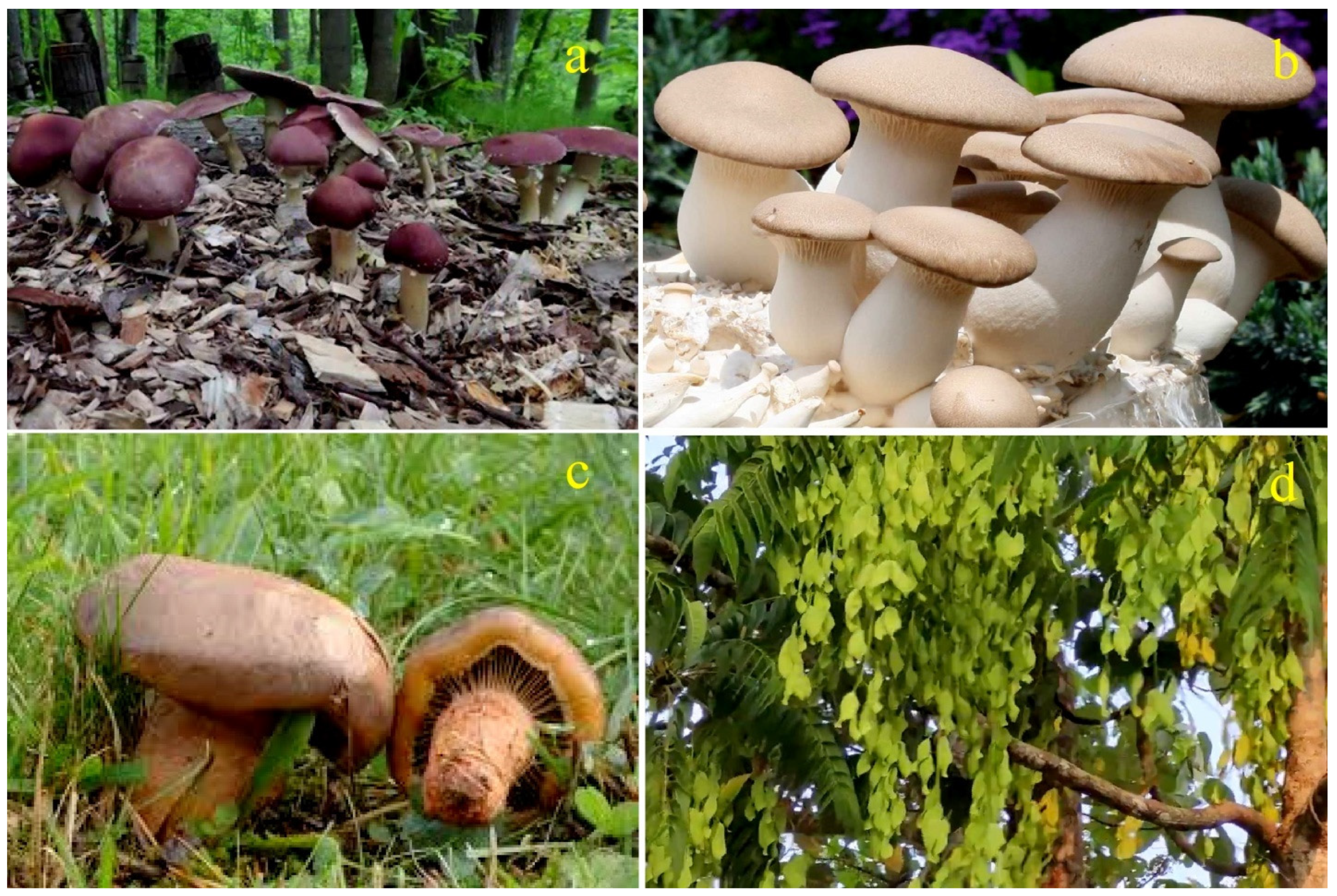
Strophasterols (468-473, structures see Figure 32), natural D-nor steroids from the mushroom Stropharia rugosoannulata (samples are shown in Figure 33), lack the D ring and form a remote D' ring through a "Retro-aldol" reaction [309,310]. Strophasterols E and F (472 and 473) were isolated from Pleurotus eryngii, showing interesting structural properties [311]. Strophasterol C (471) and glaucoposterol A (472) were obtained from Cortinarius glaucopus [312]. Tricholumin A (474), an ergosterol derivative from Trichoderma asperellum, exhibited antimicrobial activity [313].
Unusual malabaricane triterpenes (475 and 476) with a cyclobutane ring were isolated from Ailanthus malabarica [314]. In marine pharmacology, globostelletins (477-483) from Rhabdastrella globostellata and stellettins Q and R (484 and 485) from Stelletta sp are examples of D-nor steroids with cyclopentane units linked to different positions of sidechains [315,316]. Stelliferins L (486), M (487), and N (488) from Rhabdastrella cf. globostellata exhibited antimicrobial activity [317]. Rhabdastins E and F (489 and 490) from Rhabdastrella globostellata showed weak activity [318]. Jaspiferin C (491), an isomalabaricane-type triterpenoid from Jaspis stellifera, possesses a unique six-membered carbon ring [319]. These studies highlight the diversity and potential of D-nor steroids in drug discovery and development.
10. Modified D-ring in Steroids
The term 'D-ring modified' in steroid chemistry denotes an alteration to the D ring of the steroid nucleus. This modification might include variations in the ring's shape, angular structure, or bond lengths, deviating from the typical cyclopentane ring structure common in most steroids. Such changes could result from chemical reactions, physical forces, or interactions with other molecules. Altering the D ring can markedly influence the biological activity and characteristics of the steroid [71]. Steroids are used in a variety of biological contexts, including as hormones and in medications. Changes in the ring structure can alter how these compounds interact with biological systems, potentially changing their effectiveness or function [71,320,321].
According to environmental and/or physiological principles, nature was unable to synthesize classical D-nor steroids, i.e. four-membered D-ring, however, she came up with a mechanism that de facto provides such an opportunity. For example, by removing a carbon atom from the D-ring and introducing an oxygen atom in its place, we obtain a new stroid construct with a tetrahydrofuran D ring, and this construct is called meroterpenoids.
The conformation and reactivity of steroids with a cyclobutane D ring or a tetrahydrofuran D ring differ significantly from those of typical steroids with a cyclopentane D ring. These modifications lead to unique structural and chemical properties [71,320,321].
Cyclobutane is a four-membered ring, which is significantly more strained than the typical five-membered D ring in steroids. This strain arises from the angle strain and torsional strain due to the smaller ring size, which forces the carbon atoms into a less favorable alignment compared to a cyclopentane ring. The strain in the cyclobutane ring makes these steroids more reactive. The ring is more prone to chemical reactions, such as ring-opening reactions, due to the high-energy conformation. This could potentially be exploited in drug design, where the ring could be a site for targeted modification or activation.
Tetrahydrofuran is a five-membered ring containing an oxygen atom. Replacing the carbon-only ring with an oxygen-containing ring changes the electronic properties of the ring. The presence of oxygen introduces heteroatom characteristics, like different electronegativity and bond angles, altering the 3D conformation of the ring. The presence of oxygen in the ring affects the reactivity of the steroid. The electron-rich oxygen can participate in hydrogen bonding and other interactions, potentially affecting how the steroid interacts with biological molecules. It can also influence the stability and reactivity of adjacent functional groups.
Both types of modifications (cyclobutane and tetrahydrofuran D rings) can significantly alter the biological activity of the steroid. Such changes can impact the binding affinity of the steroid to receptors, its metabolic stability, and its overall pharmacological profile. This kind of structural modification is a key area in medicinal chemistry for designing new drugs with enhanced properties or reduced side effects.
Meroterpenoids with a tetrahydrofuran D ring have been found in nature, and this suggests that this structure is more stable than D-nor steroids [322,323,324]. When the D ring is deformed in steroid hormones, there are seven different variations of natural meroterpenoids as shown in Figure 34 and depends on the position of oxygen in the D ring.
Marine invertebrates have yielded several metabolites with an oxygen atom at position 17 (group M I, see Figure 34). A terpenoid, cadlinaldehyde (492, structures see Figure 35), with a unique degraded sesterterpenoid skeleton, was isolated from the skin extracts and egg masses of the Northeastern Pacific dorid nudibranch, Cadlina luteomarginata [325].
A distinctive C21 tetracyclic terpenoid lactone, murrayanolide (493), was sourced from the marine bryozoan Dendrobeania murrayana [326]. Strongylophorine 6 (494) and 7 (495) were identified in extracts from the sponge Strongylophora durissima, found near Maricaban Island in the Philippines [327]. A cheilanthane sesterterpenoid, 13,16-epoxy25-hydroxy-17-cheilanthen-19,25-olide (496), acting as a protein kinase inhibitor, was isolated from the marine sponge Ircinia sp. [328].
Pentacyclic sesterterpenes, lintenolide A (497) and lintenolide B (498), were characterized from the Caribbean sponge Cacospongia cf. linteiformis. Both compounds exhibited high ichthyotoxicity and antifeedant activity, suggesting their role as natural feeding deterrents [329]. Ichthyotoxicity tests on Gambusia affinis, the mosquito fish, revealed that lintenolides A and B are toxic at a concentration of 10 ppm. Antifeedant assays with Carassium auratus, the goldfish, indicated strong feeding deterrence at a concentration of 30 μg/cm2 of food pellets. Furthermore, lintenolides A and B inhibited protein kinase C (PKC) at IC50 values of 20–30 μg/mL and did not inhibit human 85-kD phospholipase A2 (PLA2). They also potently inhibited (IC50 0.50–1.40 μg/mL) the proliferation of the MCF-7 mammary tumor cell line [330]. Two more compounds, lintenolides F (499) and G (500), were identified as antiproliferative sesterterpenes from the same marine sponge [331].
The marine sponge Spongia sp. has been identified as a source of tricyclic sesterterpenoids, spongianolides C (501) and D (502). These compounds, featuring a γ-HB moiety, have been found to inhibit the proliferation of the MCF-7.4 mammary tumor cell line [330].
A significant diversity of meroterpenoids has been discovered in marine invertebrates, particularly in those where oxygen (or another heteroatom, such as nitrogen) is located at position 16 of the D ring (group M II, see Figure 34). The South China Sea sponge Spongia officinalis yielded 3-nor-spongiolide A (503), a rare 3-nor-spongian carbon skeleton, and spongiolides A (504) and B (505), which uniquely feature a γ-butenolide in place of the typical furan ring in ring D. Alongside these, six related metabolites (506-511) were also isolated as its metabolic components [332].
Numerous oxygenated meroterpenes (512-517) have been discovered in the Australian nudibranch Chromodoris reticulata [333]. 12-epi-Aplysillin (518) and another compound (522) were detected in extracts from the nudibranch Chromodoris luteorosea [334], while spongian-16-one (519) and its 7α-acetoxy derivative (520) were found in Chromodoris inopinata [335]. These latter two compounds, 519 and 520, were also reported by Miyamoto and colleagues [336] from the Japanese chromodorid Chromodoris obsoleta.
A minor metabolite, aplyroseol-15 (523, structures see Figure 36), was isolated from the marine sponge Aplysilla rosea [337]. An anticancer metabolite containing an epoxy group (524) was isolated from the mollusk Chromodoris obsoleta, exhibiting strong cytotoxicity against L1210 and KB cancer cells [338]. Isoagatholactone (525) was obtained from the sponge Spongia officinalis [339].
Recent studies have identified bioactive metabolites such as zimoclactones A (526), B (527), and C (528) from the marine sponge Spongia zimocca sp. irregularia [340,341]. Zimoclactone A demonstrated moderate cytotoxic activity against P388 cell lines [340,341]. Two spongian C20-terpenoids, 529 and 530, were derived from a Great Barrier Reef sponge, Spongia sp. [342]. Additionally, two oxidized diterpenoids, 3-methylspongia-3,12-dien-16-one (531) and 3β-acetoxy-15-hydroxyspongia-12-en (532), were isolated from the marine sponge Acanthodendrilla sp., collected in Pulau-Pulau [343].
Figure 36.
Meroterpenoids derived from marine organisms and fungi.
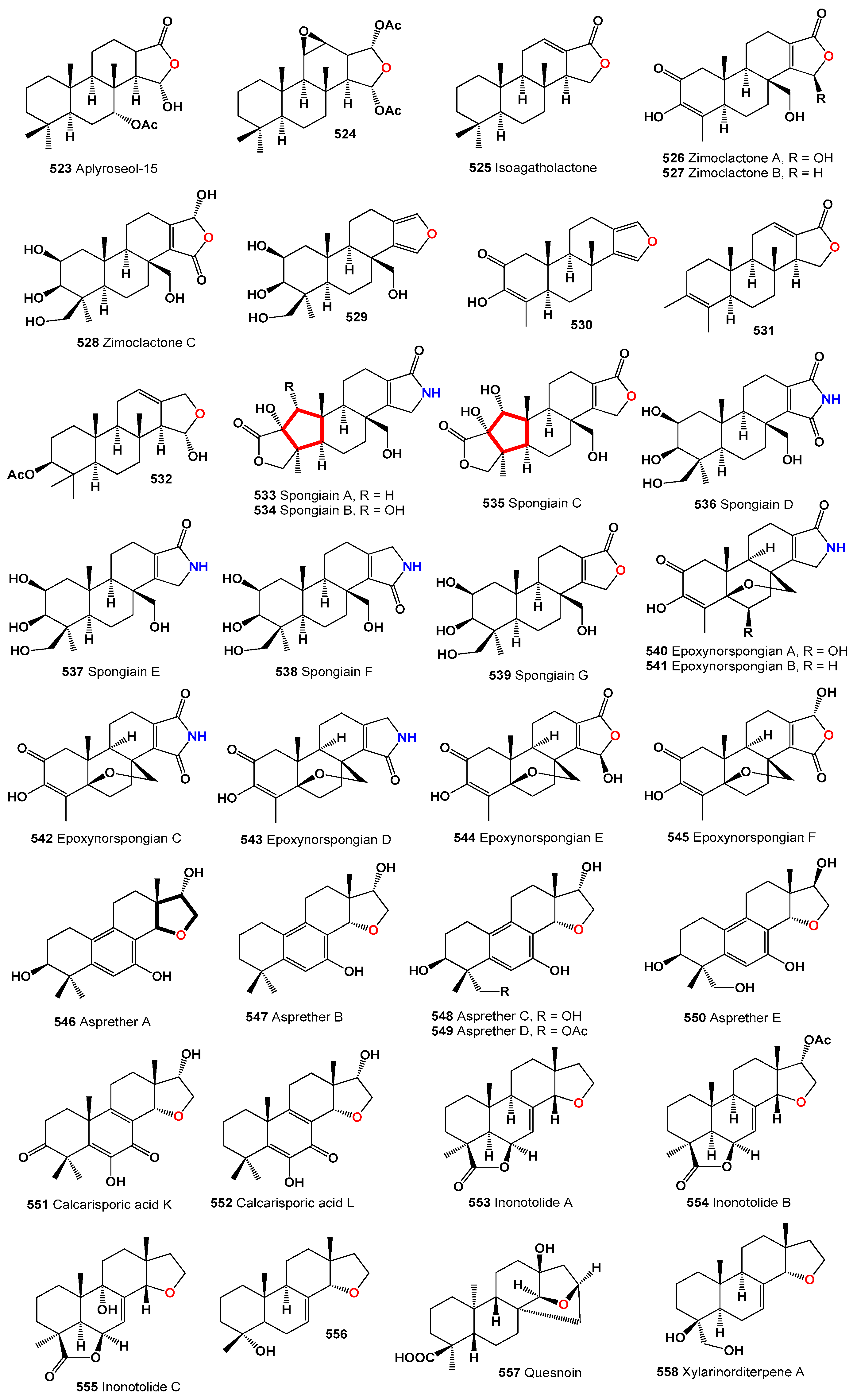
Spongiains A-C (533–535), the first examples of spongian diterpenes with a pentacyclic skeleton composed of a fused 5/5/6/6/5 ring system through ring A rearrangement, and four new spongian diterpenes, spongiains D-G (536–539), were isolated from the marine sponge Spongia sp. [344]. Novel epoxynorspongians A–F (540-545), new 19-norspongian diterpenes with a 5,17-epoxy unit, were also isolated from Spongia sp. Compound 544 displayed moderate activities against the PC3 and PBL-2H3 cell lines, with IC50 values of 24.8 and 27.2 μM, respectively [345].
Several metabolites with an oxygen atom at position 15 (group M III, see Figure 34) have been discovered in fungi and plants. From Aspergillus wentii, meroterpenoids named asprethers A–E (546-550) were isolated and tested for cytotoxicity. These compounds showed effectiveness against the A549 cell line, with IC50 values of 20, 16, 19, 17, and 20 μM, respectively. Specifically, compound 546 exhibited higher activity against the T-47D cell line, while compound 547 was more effective against the HEK293 and SMMC-7721 cell lines [346].
The fungus Calcarisporium arbuscula produces calcarisporic acid K (551) and L (552) [347]. Inonotolides A–C (553–555), isolated from the fungus Inonotus sinensis, represent another group of compounds [348]. From the endophytic fungus Xylaria sp., the isopimarane diterpene 14α,16-epoxy-18-norisopimar-7-en-4α-ol (556), exhibiting moderate antifungal activity, was obtained [349].
Fossilized tree resin, amber, found near the Oise River in the Paris basin, France, and dated to be 55 million years old, yielded the novel meroterpenoid quesnoin (557). The absolute configurations of its eight chiral centers were determined as 4S, 5S, 8R, 9S, 10S, 13S, 14R, and 16S. Quesnoin revealed the tree producer to be akin to modern Hymenaea oblongifolia, Fabaceae, a subfamily of Caesalpiniaceae, one of the oldest angiosperms. The discovery of H. oblongifolia suggests the Paris basin may have had a tropical climate in the early Eocene period, 55 million years ago [350]. Nor-isopimarane diterpene, xylarinorditerpene A (558), was isolated from the fungicolous fungus Xylaria longipes HFG1018, isolated from Fomitopsis betulinus [351].
The modified D ring in steroids, as shown in Figure 34, is categorized into four groups based on the position of the oxygen atom in the six-membered ring. Representatives of these groups (M IV – M VII) of meroterpenoids have been extracted from marine and terrestrial sources. Meroterpenoids named chevalones A–D (559–562, structures see Figure 37) were isolated from the fungus Eurotium chevalieri. Compound 562 exhibited antimalarial activity against Plasmodium falciparum, and 561 showed antimycobacterial activity against Mycobacterium tuberculosis. Compounds 560–562 also displayed cytotoxicity against cancer cell lines [352]. Chevalone C analogues, 1-hydroxychevalone C (563), 1-acetoxychevalone C (564), 1,11-dihydroxychevalone C (565), and 11-hydroxychevalone C (566) were isolated from the fungus Neosartorya spinosa. 1-hydroxychevalone C showed antimycobacterial activity against Mycobacterium tuberculosis with a MIC value of 26.4 μM, and 1-acetoxychevalone C exhibited antimalarial activity against Plasmodium falciparum with an IC50 value of 6.67 μM. These compounds also demonstrated cytotoxicity against KB and NCI-H187 cancer cell lines, with IC50 values ranging from 32.7 to 103.1 μΜ [353]. New α-pyrone meroterpenoid chevalones H–M (567–572) were isolated from the gorgonian coral-derived fungus Aspergillus hiratsukae SCSIO 7S2001 collected from Mischief Reef in the South China Sea. All compounds displayed various degrees of antibacterial activity, with MIC values between 6.25–100 µg/mL [354].
Meroterpenoid aglatomin B (573) was isolated from the leaves of Aglaia tomentosa and found in the bark of Aglaia lawii [355]. A highly oxygenated meroterpenoid, peniciacetal C (574), with a unique 3,6-dimethyldihydro-4H-furo[2,3-b]pyran-2,5-dione unit and a 6/6/6/5/6 fused pentacyclic skeleton, was detected in extracts from the mangrove-derived fungus Penicillium sp. HLLG-122 [356].
Figure 38.
Samples of mollusks, fungi and plants where meroterpenoids were discovered: a, nudibranch Cadlina luteomarginata, b, fungus Calcarisporium arbuscular. Calcarisporium is a genus of fungi in the order Hypocreales. Species are typically fungicolous, parasitizing other fungal fruit bodies. c, fungus Xylaria is a genus of ascomycetous fungi commonly found growing on dead wood. The name comes from the Greek xýlon meaning wood. d, fungus Eurotium chevalieri is the sexual state of the species Aspergillus chevalieri that belongs to the division Ascomycota. e, plant Aglaia tomentosa, and f, Chukrasia tabularis is a species of plant in the family Meliaceae. It is found in Australia (Queensland), Brunei, India, Indonesia, Laos, Malaysia, Papua New Guinea, the Philippines, Singapore, and Vietnam.
Figure 38.
Samples of mollusks, fungi and plants where meroterpenoids were discovered: a, nudibranch Cadlina luteomarginata, b, fungus Calcarisporium arbuscular. Calcarisporium is a genus of fungi in the order Hypocreales. Species are typically fungicolous, parasitizing other fungal fruit bodies. c, fungus Xylaria is a genus of ascomycetous fungi commonly found growing on dead wood. The name comes from the Greek xýlon meaning wood. d, fungus Eurotium chevalieri is the sexual state of the species Aspergillus chevalieri that belongs to the division Ascomycota. e, plant Aglaia tomentosa, and f, Chukrasia tabularis is a species of plant in the family Meliaceae. It is found in Australia (Queensland), Brunei, India, Indonesia, Laos, Malaysia, Papua New Guinea, the Philippines, Singapore, and Vietnam.

Aspermeroterpenes B (575) and C (576) were obtained from the marine-derived fungus Aspergillus terreus GZU-31-1, isolated from the air-breathing sea slug Onchidium struma [357]. Highly oxygenated meroterpenoids, terreustoxins E (577) and F (578), were isolated from the Antarctic fungus Aspergillus terreus [358].
Chukrasone A (579), incorporating a highly rearranged A/B ring system, was isolated from Chukrasia tabularis (plant samples are shown in Figure 38) and exhibited potential inhibition of the delayed rectifier (IK) K+ current [359]. A chukrasone-type limonoid, Guianofruit C (580), was found in the fruit oil of Carapa guianensis (Meliaceae), a traditional medicine in Brazil and Latin American countries, and showed moderate inhibitory activities [360]. Khayanolide A (581), a rearranged phragmalin-type limonoid with an A, B, D-seco compound structure, was isolated from the ether extract of the stem bark of Khaya senegalensis as an insect antifeedant. Khayanolides A demonstrated antifeedant activity against the third instar larvae of S. littoralis [361].
Several sesterterpenes have been reported in Aspergillus terreus, such as terretonin A (582), B (585), C (583), D (586), and terretonin (584) [362]. Endophytic Aspergillus terreus, associated with the root of Tripterygium wilfordii (Celastraceae), yielded spiro-dioxolane-containing adducts with 3,5-DMOA-based meroterpenoid and 2,3-butanediol moieties, named spiroterre usnoids A–D (587–590) [363].
Asperterpenes D (591) and E (592) have been obtained from extracts of the soil-derived Aspergillus terreus [364]. Furthermore, purification of the cytotoxic fractions of the methanol extracts of the succulent plant Kalanchoe hybrida leads to the isolation of three compounds characterized by the basic skeleton of α-pyrone ring-opening products of bufadienolides, namely, kalanhybrin A–C (593–595) [365].
In summary, this text highlights natural meroterpenoids (492-594) that are formed by the modification of the D-ring in steroids. The meroterpenoids discussed are primarily formed through the oxidation of corresponding steroids. However, there are notable exceptions; compounds 533, 534, 537, 538, 540, 541, 542, and 543, which uniquely contain nitrogen instead of oxygen as a heteroatom. This demonstrates the diversity in the biosynthesis of the compounds presented, emphasizing the variability in terpenoid structures. Additionally, we provide literature on the synthesis of norsteroids [366,367,368,369,370,371,372] and their biological activity [373,374,375,376,377,378].
11. Examples of Synthesis of Nor Steroids
The 1930s were a pivotal decade in the study of natural steroids and their chemical synthesis [379,380,381,382,383,384,385,386]. This era is often referred to by steroid chemists as the "decade of the Sex Hormones," a period marked by the determination of the molecular structures of certain sex hormones and their introduction into medical practice as drugs. Russell Marker achieved a significant milestone during this time with the first practical synthesis of the pregnancy hormone, progesterone, using a process now known as the Marker Degradation. He produced progesterone from a starting material found in a species of Mexican yam, and this progesterone eventually became the preferred precursor in the industrial preparation of the anti-inflammatory drug cortisone. Important research on sex hormones continued in Mexico, leading to the synthesis of the first useful oral contraceptive in 1951 [384,385,386,387,388,389,390,391,392].
The ring contraction reaction on 11-ketoprogesterone (595, see Scheme 1) was successfully carried out on a large scale. The purity of the product and its structure as 11-keto A-norsteroid (596) were confirmed by analytical and spectroscopic (IR, NMR, MS) methods. The method developed in Thomas' laboratory was repeated on a larger scale, carrying out the ring contraction of 11-ketoprogesterone using thallium nitrate in a mixture of trimethyl orthoformate and methanol to give the A-norsteroid (596) [393].
The first A-norpregnane was prepared by Butenandt [394]. They oxidized 5β-pregnanediol (597) to the 20-oxo-3,4-seco acid derivative (598). Upon heating with acetic anhydride, the A ring closed with the evolution of water and carbon dioxide to give A-nor-5β-pregnan-3,20-dione (599). Because the 5β-pregnan series has an A/B cis ring junction, enolization of the 3-oxo derivative will be directed toward the C4-position, and oxidative cleavage will give the 3,4-seco acid. Using a similar approach, Marker and co-workers [388,392] oxidized 5α-pregnane-3,20-dione (600) to the 2,3-seco acid (601). Treatment with acetic anhydride gave A-nor-5α-pregnan-2,20-dione (602).
Weisenborn and Applegate synthesized A-norprogesterone [379]. 2-Hydroxymethylenepregn-4-en-20β-ol-3-one (603) was cleaved with ozone to give the unsaturated 2,3-seco acid (604). Treatment with acetic anhydride gave the A-nor-α,β-unsaturated ketone, and mild oxidation gave A-norprogesterone (605).
Scheme 1.
Synthesis of A-nor steroids.

The first B-norsteroids were obtained by cleaving the Δ5-double bond of cholesterol derivatives, followed by cyclization of the resulting keto-acids (see Scheme 2). Windaus prepared Δ5-B-norcholestene (608) by permanganate oxidation of Δ5-cholestene (606) and pyrolysis of the keto-acid (607). Similarly, Windaus prepared Δ3,5-B-norcholestene (611) by pyrolysis of a resinous keto-acid (610) obtained in low yield from the chromic acid oxidation of cholesteryl acetate (609). It was later shown that the 6,7-seco-diacid (613), obtained from nitric acid oxidation of cholestane-6-one (612), could be cyclized to the B-nor-ketone (614) by pyrolysis of the barium salt [395].
When the commercially available hecogenin acetate (615) was refluxed in ethanol with different amounts of PhI(OAc)2 and KOH, variable yields of the C-ring contraction product 616 were obtained. The best result (58%) was achieved when hecogenin acetate was refluxed for 24 hours with PhI(OAc)2 and KOH. In all cases, variable amounts of hecogenin (product of the hydrolysis of the acetate in C-3) were obtained. All attempts at improving the yield of the C-norsteroid 616 by either extending the reaction time or increasing the amount of reagent resulted in lower yields and products of deteriorated purity [396].
The steroidal ketone (617), PhI(OAc)2, and KOH in methanol were refluxed for 24 hours before pouring into a cold saturated NaCl solution. The resulting solid was filtered and washed with water. Chromatographic purification on silica gel employing a gradient of hexane to an 85/15 hexane/ethyl acetate mixture as eluent afforded the rearranged product (618) [396].
Hecogenin acetate (615) is a readily available substance for the preparation of steroids modified in ring C, and it was converted to 3β,20-diacetoxy-5α-pregnan-12-one (619). The 11,12-ketol group in 619 this compound was oxidized using bismuth trioxide to form the C-nor steroid (620). Another use of hecogenin acetate was converted to 3β,20-diacetoxy-11-hydroxy-preg-9-en-12-one (621). Treatment of this compound with lead tetra-acetate gives the final product, 3β,20-dihydroxy-C-nor-pregnan-11-one (622) [397].
Scheme 3.
Synthesis of C-nor steroids.
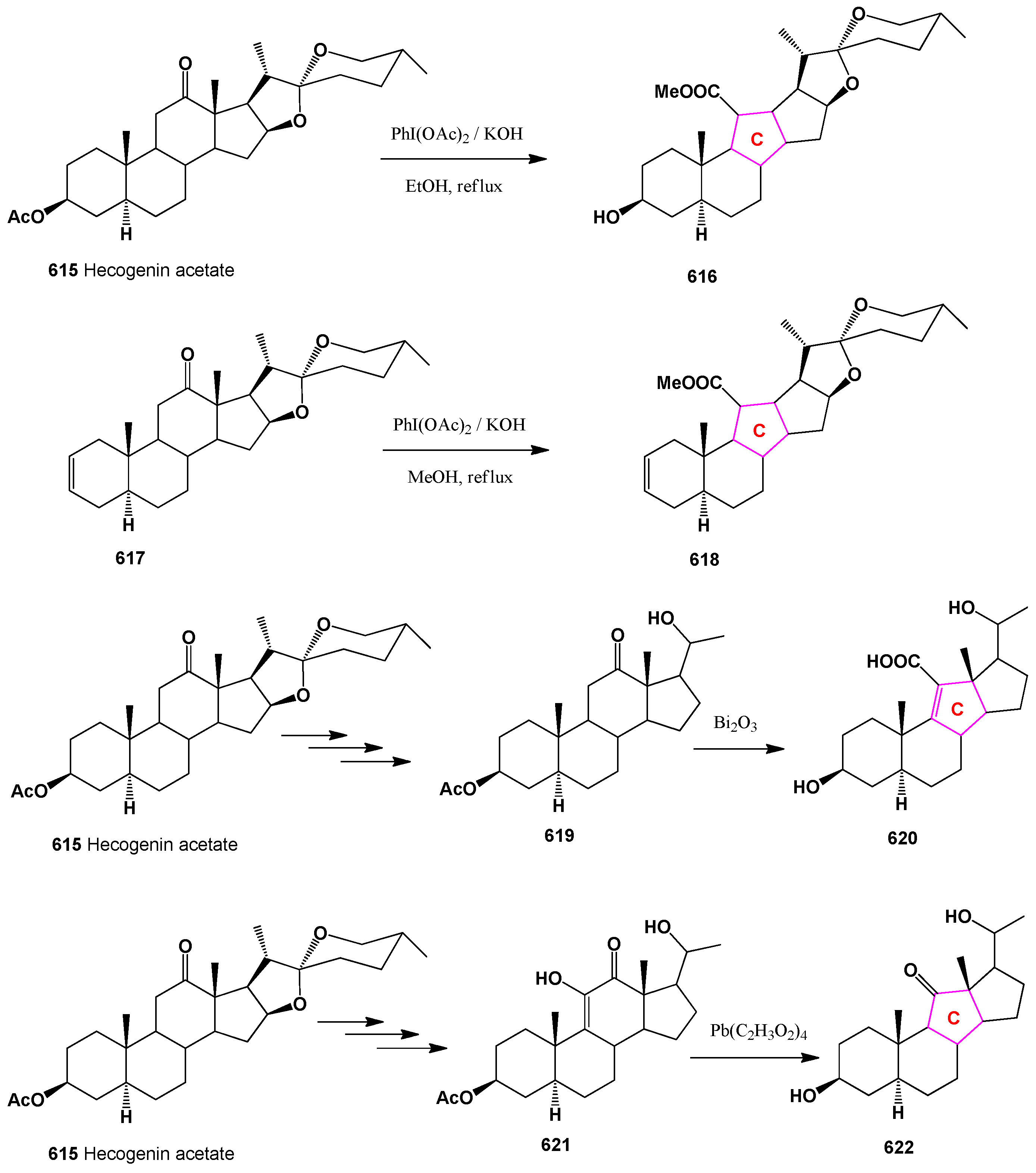
The preparation of 16-diazo-androstan-3β-ol-17-one (624) from 5α-androstan-3β-ol-17-one (623) has been described (see Scheme 4). The 16-diazo group has been replaced by 16β-acetate, 16α-halogen, and 16ζ-alkoxy substituents. Irradiation of the 16-diazo compound by UV light leads to contraction of the D-ring in the steroid molecule, resulting in the formation of a D-nor steroid (625) [268].
Starting with androst-5-en-3β-ol-17-one (626), the corresponding androst-5-en-16-diazo-17-one (627) was synthesized. Irradiation of this diazo compound caused contraction of the D-ring, leading to the production of the D-nor carboxylic acids (628 and 629) [272,398].
We have presented some syntheses of norsteroids, and it is interesting those steroids containing the diazo group under the influence of UV light form D-nor steroids, which are not found in nature.
Conclusions
In conclusion, the exploration of A, B, C, and D-norsteroids present a fascinating and fruitful area in the field of steroid chemistry and pharmacology. These compounds, characterized by their unique structural modifications from the typical four-ring steroid structure, exhibit a wide range of biological activities and potential therapeutic applications. The removal or alteration of specific methyl groups or changes in the steroid nucleus results in unprecedented molecular architectures, which in turn influence their interactions with biological systems.
The significance of these steroids is underscored by their diverse origins, from natural sources like marine organisms to synthetic laboratory creations. Marine sponges, corals, mollusks, fungi, and other organisms have been highlighted as rich sources of these unique compounds. Their varied ecological niches foster the production of steroids with novel structures, often with significant biological activity, such as cytotoxic, antimicrobial, and anti-inflammatory properties. These findings are not only crucial for understanding the ecological roles of these compounds but also for their potential in drug discovery and development.
The therapeutic potential of A, B, C, and D-nor steroids is vast, with applications ranging from hormone therapy and contraception to the treatment of various cancers and inflammatory diseases. The historical interest in these compounds, particularly in the context of hormonal drug development, has set the stage for ongoing research and exploration.
The article concludes by emphasizing the importance of continued research in this field. The unique structural features and biological activities of A, B, C, and D-nor steroids hold great promise for the development of novel pharmacological agents. Future studies are essential for unraveling their full potential, understanding their mechanisms of action, and harnessing their capabilities for medical advancements. In essence, the world of modified steroids offers a treasure trove of possibilities for advancing human health and medicine.
Funding
This work did not receive any specific grants from funding agencies in the public, commercial, or not-for-profit sectors.
Institutional Review Board Statement
Not applicable.
Informed Consent Statement
Not applicable.
Data Availability Statement
Not applicable.
Conflicts of Interest
The author declares that he has no known competing financial interests or personal relationships that could affect the work described in this article.
References
- Dembitsky, V.M. In silico prediction of steroids and triterpenoids as potential regulators of lipid metabolism. Mar. Drugs 2021, 19, 650. [Google Scholar] [CrossRef] [PubMed]
- Dembitsky, V.M. Antitumor and hepatoprotective activity of natural and synthetic neo steroids. Prog. Lipid Res. 2020, 79, 101048. [Google Scholar] [CrossRef] [PubMed]
- Dembitsky, V.M. Biological activity and structural diversity of steroids containing aromatic rings, phosphate groups, or halogen atoms. Molecules 2023, 28, 5549. [Google Scholar] [CrossRef] [PubMed]
- Dembitsky, V.M. Fascinating furanosteroids and their pharmacological profile. Molecules 2023, 28, 5669. [Google Scholar] [CrossRef]
- Dembitsky,V. M. Bioactive steroids bearing oxirane ring. Biomedicines 2023, 11, 2237. [Google Scholar]
- Pounina, T.A.; Gloriozova, T.A.; Savidov, N.; Dembitsky, V.M. Sulfated and sulfur-containing steroids and their pharmacological profile. Mar. Drugs 2021, 19, 240. [Google Scholar] [CrossRef] [PubMed]
- Ermolenko, E.V.; Imbs, A.B.; Gloriozova, TA.; Poroikov, VV.; Sikorskaya, T.V.; Dembitsky, V.M. Chemical diversity of soft coral steroids and their pharmacological activities. Mar. Drugs 2020, 18, 613. [Google Scholar] [CrossRef] [PubMed]
- Ramos-Martín, F.; D'Amelio, N. Biomembrane lipids: When physics and chemistry join to shape biological activity. Biochimie 2022, 203, 118–138. [Google Scholar] [CrossRef]
- Summons, R.E.; Welander, P.V.; Gold, D.A. Lipid biomarkers: molecular tools for illuminating the history of microbial life. Nat. Rev. Microbiol. 2022, 20, 174–185. [Google Scholar] [CrossRef]
- Volkman, J.K. Lipids of geochemical interest in microalgae. In: Wilkes, H. (Eds) Hydrocarbons, Oils and Lipids: Diversity, Origin, Chemistry and Fate. Handbook of Hydrocarbon and Lipid Microbiology. Springer, Cham. 2020. [CrossRef]
- Savidov, N.; Gloriozova, T.A.; Poroikov, V.V.; Dembitsky, V.M. Highly oxygenated isoprenoid lipids derived from fungi and fungal endophytes: Origin and biological activities. Steroids 2018, 140, 114–124. [Google Scholar] [CrossRef]
- Luo, G.; Yang, H.; Algeo, T.J.; Hallmann, C.; Xie, S. Lipid biomarkers for the reconstruction of deep-time environmental conditions. Earth-Science Rev. 2019, 189, 99–124. [Google Scholar] [CrossRef]
- Marker, R.E.; Kamm, O.; Fleming, G.H.; Popkin, A.H.; Wittle, E.L. Sterols. X. Cholesterol derivatives. J. Am. Chem. Soc. 1937, 59, 619–621. [Google Scholar] [CrossRef]
- Min, L.; Zhong, L.P.; Li, C.C. Total Synthesis of abeo-steroids via cycloaddition strategy. Acc. Chem. Res. 2023, 56, 2378–2390. [Google Scholar] [CrossRef] [PubMed]
- Duecker, FL.; Reuß, F.; Heretsch, P. Rearranged ergostane-type natural products: chemistry, biology, and medicinal aspects. Org. Biomol. Chem. 2019, 17, 1624–1633. [Google Scholar] [CrossRef] [PubMed]
- Moss, G.P. Nomenclature of steroids (Recommendations 1989). Pure Appl. Chem. 1989, 61, 1783–1822. [Google Scholar] [CrossRef]
- O’Keefe, S.F. Nomenclature and Classification of Lipids. 2nd Edition, 2002, CRC Press, pp. 40, eBook ISBN9780429221378.
- Hanson, J.R. Steroids: partial synthesis in medicinal chemistry. Nat. Prod. Rep. 2010, 27, 887–899. [Google Scholar] [CrossRef] [PubMed]
- Sica, D.; Musumeci, D. Secosteroids of marine origin. Steroids 2004, 69, 743–756. [Google Scholar] [CrossRef]
- Morrow, D.F.; Gallo, D. Steroids and biologically related compounds. Ann. Rep. Med. Chem. 1972, 7, 182–193. [Google Scholar] [CrossRef]
- Qian, P.Y.; Xu, Y.; Fusetani, N. Natural products as antifouling compounds: recent progress and future perspectives. Biofouling 2009, 26, 223–234. [Google Scholar] [CrossRef]
- Waters, J.A.; Kondo, Y.; Witkop, B. Photochemistry of steroids. J. Pharm. Sci. 1972, 61, 321–334. [Google Scholar] [CrossRef]
- Norman, A.W.; Ross, F.P. Vitamin D seco-steroids: unique molecules with both hormone and possible membranophilic properties. Life Sci. 1979, 24, 759–769. [Google Scholar] [CrossRef]
- Anderson, L.A. A chemical framework for the preservation of fossil vertebrate cells and soft tissues. Earth-Sci. Rev. 2023, 240, 104367. [Google Scholar] [CrossRef]
- Briggs, D.E.G.; Summons, R.E. Ancient biomolecules: their origins, fossilization, and role in revealing the history of life. BioEssays 2014, 36, 482–490. [Google Scholar] [CrossRef] [PubMed]
- Brocks, J.J.; Pearson, A. Building the biomarker tree of life. Rev. Mineral. Geochem. 2005, 59, 233–258. [Google Scholar] [CrossRef]
- Dembitsky, V.M. , Savidov, N., Poroikov, V.V. Naturally occurring aromatic steroids and their biological activities. Appl. Microbiol. Biotechnol. 2018, 102, 4663–4674. [Google Scholar] [CrossRef] [PubMed]
- Volkman, J.K. A review of sterol markers for marine and terrigenous organic matter. Org. Geochem. 1986, 9, 83–99. [Google Scholar] [CrossRef]
- Dembitsky, V.M. Oxidation, epoxidation and sulfoxidation reactions catalysed by haloperoxidases. Tetrahedron 2003, 59, 4701–4720. [Google Scholar] [CrossRef]
- Dembitsky, V.M. ; T Rezanka, M Srebnik. Lipid compounds of freshwater sponges: family Spongillidae, class Demospongiae. Chem. Phys. Lipids, 2003; 123, 117–155. [Google Scholar] [CrossRef]
- Webster, N.S.; Taylor, M.W. Marine sponges and their microbial symbionts: love and other relationships. Environ. Microbiol. 2012, 14, 335–346. [Google Scholar] [CrossRef]
- Hentschel, U.; Piel, J.; Degnan, S. Genomic insights into the marine sponge microbiome. Nat. Rev. Microbiol. 2012, 10, 641–654. [Google Scholar] [CrossRef]
- Mishra, C.; Sree, A. Composition of the lipophilic extract from the sponge Axinella carteri collected from the Bay of Bengal of the Orissa coast. Chem. Nat. Compd. 2008, 44, 282–286. [Google Scholar] [CrossRef]
- Anuradha, V. , Byju, K., Emilda, R. In silico biological activity of steroids from the marine sponge Axinella carteri. Med. Chem. Res. 2013, 22, 1142–1146. [Google Scholar]
- Santalova, E.A.; Makarieva, T.N.; Gorshkova, I.A.; Dmitrenok, A.S.; Vladimir, B. Krasokhin, Stonik, V.A. Sterols from six marine sponges. Biochem. Syst. Ecol. 2004, 32, 153–167. [Google Scholar] [CrossRef]
- Ivanchina, N.V.; Kalinin, V.I. Triterpene and steroid glycosides from marine sponges (Porifera, Demospongiae): structures, taxonomical distribution, biological activities. Molecules 2023, 28, 2503. [Google Scholar] [CrossRef]
- Barnathan, G.; Velosaotsy, N.; Al-Lihaibi, S.; Njinkoue, J.M.; Kornprobst, J.M.; Vacelet, J.; Boury-Eenault, N. Unusual sterol composition and classification of three marine sponge families. Boll. Mus. Ist. Biol. Univ. Genova 2004, 68, 201–208. [Google Scholar]
- Minale, L.; Sodano, G. Marine sterols: unique 3β-hydroxymethyl-A-nor-5α-steranes from the sponge Axinella verrucosa. J. Chem. Soc., Perkin Trans. 1, 1974, 20, 2380–2384. [Google Scholar] [CrossRef]
- Eggersdorfer, M.L.; Kokke, W.C.M.C.; Crandell, C.W.; Hochlowski, J.E.; Djerassi, C. Sterols in marine invertebrates. 32. Isolation of 3.beta.-(hydroxymethyl)-A-nor-5.alpha.-cholest-15-ene, the first naturally occurring sterol with a 15-16 double bond. J. Org. Chem. 1982; 47, 5304–5309. [Google Scholar]
- Bohlin, L.; Sjoestrand, U.; Sodano, G.; Djerassi, C. Sterols in marine invertebrates. 33. Structure of five new 3.beta.-(hydroxymethyl)-a-nor steranes: indirect evidence for transformation of dietary precursors in sponges. J. Org. Chem. 1982; 47, 5309–5314. [Google Scholar]
- Sheikh, Y.M.; Djerassi, C. Steroids from sponges. Tetrahedron 1974, 30, 4095–4103. [Google Scholar] [CrossRef]
- Aiello, A.; Fattorusso, E.; Menna, M. Steroids from sponges: Recent reports. Steroids 1999, 64, 687–714. [Google Scholar] [CrossRef] [PubMed]
- Kitagawa, I.; Kobayashi, M.; Kitanaka, K.; Kido, M.; Kyogoku, Y. Marine natural products. XII. On the chemical constituents of the Okinawan marine sponge Hymeniacidon aldis. Chem. Pharm. Bull. 1983, 31, 2321–2328. [Google Scholar]
- De Nanteuil, G.; Ahond, A.; Poupat, C.; Potier, P.; Pusset, M.; Pusset, J.; Laboute, P. Invertebres marins du lagon neo-caledonien -VI: Isolement et identification de onze sterols de type hydroxymethyl-3β nor-a cholestane du spongiaire, Pseudaxinyssa cantharella. Tetrahedron 1985, 41, 6035–6039. [Google Scholar] [CrossRef]
- Bohlin, L.; Sjöstrand, U.; Djerassi, C.; Sullivan, B.W. Minor and trace sterols in marine invertebrates. Part 20. 3ξ-Hydroxymethyl-A-nor-patinosterol and 3ξ-hydroxymethyl-A-nor-dinosterol. Two new sterols with modified nucleus and side-chain from the sponge Teichaxinella morchella. J. Chem. Soc., Perkin Trans. 1, 1981, 1023-1028.
- Elenkov, I.; Popov, S.; Andreev, S. Sterol composition of the Black Sea sponges Hymeniacidon sanguinea (Grant) and Halichondria panicea (Pallas). Z. Naturforsch. 1999, 54C, 972–976. [Google Scholar] [CrossRef]
- Masuno, M.N.; Pawlik, J.K.; Molinski, T.F. Phorbasterones A-D, cytotoxic Nor-ring A steroids from the sponge Phorbas amaranthus. J. Nat. Prod. 2004, 67, 731–733. [Google Scholar] [CrossRef]
- Tischler, M.; Ayer, S.W.; Andersen, R.J.; Mitchell, J.F.; Clardy, J. Anthosterones A and B, ring A contracted steroids from the sponge Anthoracuata graceae. Can. J. Chem., 1988, 66, 1173.
- Rahelivao, M.P.; Gruner, M.; Andriamanantoanina, H.; Andriamihaja, B.; Bauer, I.; Knölker, H.J. Red algae (Rhodophyta) from the coast of Madagascar: Preliminary bioactivity studies and isolation of natural products. Mar. Drugs 2015, 13, 4197–4216. [Google Scholar] [CrossRef]
- Ramalingam, V.; Rajaram, R. 2-Ethoxycarbonyl-2-β-hydroxy-a-nor-cholest-5-ene-4one: Extraction, structural characterization, antimicrobial, antioxidant, anticancer and acute toxicity studies. Steroids 2018, 140, 11–23. [Google Scholar] [CrossRef]
- Liang, Y.; Zhang, M.; Yu, M.; Wang, J.; Zhu, H.; Chen, C.; Zhang, Y. Four new ergostane-type steroids from Lasiodiplodia pseudotheobromae. Tetrahedron Lett. 2020, 61, 151737. [Google Scholar] [CrossRef]
- Li, G.; Deng, Z.; Guan, H.; van Ofwegen, L.; Proksch, P.; Lin, W. Steroids from the soft coral Dendronephthya sp. Steroids 2005, 70, 13–18. [Google Scholar] [CrossRef]
- Fan, W.; Wang, X.; Cai, H.; Sun, L.; Yang, L.; Nie, S. Chemical analysis of the South China Sea spine body sponge Acanthella cavernosa. J. Pharm. Pract. 2016, 34, 138–141. [Google Scholar]
- Ragini, K.; Piggott, A.M.; Karuso, P. Crellasterones A and B: A-Norsterol derivatives from the New Caledonian sponge Crella incrustans. Mar. Drugs 2017, 15, 177. [Google Scholar] [CrossRef]
- Gutierrez, G.; Serrar, M.; Hadid, Z. Steroid derivatives and use thereof as medicaments. Patent: WO2005014614A1. 2005-02-17.
- Chen, B.; Gu, Y.C.; de Voogd, N.J.; Wang, C.Y.; Guo, Y.W. Xidaosterols A and B, two new steroids with unusual α-keto-enol functionality from the South China Sea sponge Neopetrosia chaliniformis. Nat. Prod. Res. 2022, 36, 1941–1947. [Google Scholar] [CrossRef]
- Tang, H.F.; Yi, Y.H.; Yao, X.S.; Xu, Q.; Zhang, S.; Lin, H. A novel steroid for Sargassum carpophyllum. Zhongguo Haiyang Yaowu 2003, 22, 28–30. [Google Scholar]
- Kitagawa, I.; Kido, M.; Kyogoku, Y. Marine natural products, XII: on the chemical constituents of the Okinawan marine sponge Hymeniacidon aldis. Chem. Pharm. Bull. 1983, 31, 2376–2378. [Google Scholar] [CrossRef]
- Kanazawa, A.; Teshima, S.I.; Hyodo, S.I. Sterols of the sponges (porifera, class demospongiae). Comp. Biochem. Phys. 1979, 62B, 521–525. [Google Scholar] [CrossRef]
- Sahidin, I.; Sabandar, C.W.; Hamsidi, R.; Malaka, M.H.; Sadarun, B.; Aslan, L.O. A-Nor steroids from the marine sponge, Clathria species. Malaysian J. Anal. Sci. 2018; 22, 375–382. [Google Scholar]
- Malik, S.; Djerassi, C. Minor and trace sterols in marine invertebrates. 61. Isolation and structure elucidation of new A-nor sterols from the marine sponge Phakellia aruensis. Steroids 1989, 53, 271-284.
- Fujita, M.; Nakao, Y.; Nakao, Y.; Matsunaga, S.; Matsunaga, S.; Fusetani, N. Isolation and structure elucidation of two phosphorylated sterol sulfates, MT1-MMP inhibitors from a marine sponge Cribrochalina sp. Revision of the structures of haplosamates A and B. Tetrahedron 2001, 57, 3885–3890. [Google Scholar] [CrossRef]
- Teshima, S.; Kanazawa, A.; Yamada, I. Occurrence of 3β-hydroxymethyl-A-nor sterols in the sponge. Nippon Suisan Gakkaishi, 1984; 50, 702–712, CA, 101, 52053. [Google Scholar]
- Gallimore, W.A.; Cabral, C.; Kelly, M.; Scheuer, P.J. A novel D-ring unsaturated A-nor sterol from the Indonesian sponge, Axinella carteri Dendy. Nat. Prod. Res. 2008, 22, 1339. [Google Scholar] [CrossRef] [PubMed]
- Yu, S.; Deng, Z.; Proksch, P.; Lin, W. Oculatol, oculatolide, and A-nor sterols from the sponge Haliclona oculata. J. Nat. Prod. 2006, 69, 1330. [Google Scholar] [CrossRef] [PubMed]
- Aknin, M.; Gaydou, E.M.; Boury-Esnault, N.; Costantino, V.; Mangoni, A. Nor-sterols in Axinella proliferans, sponge from the Indian Ocean. Comp. Biochem. Physiol. 1996, 113B, 845–848. [Google Scholar] [CrossRef]
- Gross, H.; Wright, A.D.; Reinscheid, U.; Konig, G.M. Three new spongian diterpenes from the Fijian marine sponge Spongia sp. Nat. Prod. Commun. 2009, 4, 315. [Google Scholar] [CrossRef] [PubMed]
- Sheu, J.H.; Chao, C.H.; Wang, G.H.; Hung, K.C.; Duh, C.Y.; Chiang, M.Y.; Wu, Y.C.; Wu, C.C. The first A-nor-hippuristanol and two novel 4,5-secosuberosanoids from the Gorgonian Isis hippuris. Tetrahedron Lett. 2004, 45, 6413–6416. [Google Scholar] [CrossRef]
- Li, G.; Deng, Z.; Guan, H.; van Ofwegen, L.; Proksch, P.; Lin, W. Steroids from the soft coral Dendronephthya sp. Steroids 2005, 70, 13–18. [Google Scholar] [CrossRef] [PubMed]
- Crabbé, P. Some aspects of steroid research based on natural products from plant origin. Bull. des Soc. Chim. Belges 1979, 88, 345–358. [Google Scholar] [CrossRef]
- Dembitsky, V.M.; Gloriozova, T.A.; Poroikov, V.V. Antitumor profile of carbon-bridged steroids (CBS) and triterpenoids. Mar. Drugs 2021, 19, 324. [Google Scholar] [CrossRef] [PubMed]
- Machida, K.; Kikuchi, M. Viburnols: Six novel triterpenoids from Viburnum dilatatum. Tetrahedron Lett. 1997, 38, 571–574. [Google Scholar] [CrossRef]
- Wang, X.Y. ; Hai-Ming Shi, Xiao-Bo Li. Chemical constituents of plants from the genus Viburnum. Chem. Biodiver. 2010, 7, 567–593. [Google Scholar]
- Liu, Y.; Zhang, L.; Xue, J.; Wang, K.; Hua, H.; Yuan, T. Norcolocynthenins A and B, two cucurbitane 3-nor-Triterpenoids from Citrullus colocynthis and their cytotoxicity. Bioorg. Chem. 2020, 101, 104045. [Google Scholar] [CrossRef] [PubMed]
- He, X.F.; Wang, X.N.; Yin, S.; Dong, L.; Yu, J.M. Ring A modified novel triterpenoids from Dysoxylum hainanense. Eur. J. Org. Chem. 2009, 4818–4824. [Google Scholar] [CrossRef]
- Lv, H.W.; Wang, Q.L.; Li, S.W.; Zhu, M.D.; Zhou, Z.B. Cucurbitane-type triterpenoids from the fruits of Citrullus colocynthis. Fitoterapia 2023, 165, 105405. [Google Scholar] [CrossRef]
- Kapoor, M.; Kaur, N.; Sharma, C.; Kaur, G.; Kaur, R.; Batra, K.; Rani, J. Citrullus colocynthis an important plant in Indian traditional system of medicine. Pharmacog. Rev. 2020, 14, 22–27. [Google Scholar] [CrossRef]
- Mónico, A.; Ramalhete, C.; André, V.; Spengler, G.; Mulhovo, S.; Duarte, M.T.; Ferreira, M.J.U. Cucurbalsaminones A–C, rearranged triterpenoids with a 5/6/3/6/5-fused pentacyclic carbon skeleton from Momordica balsamina, as multidrug resistance reversers. J. Nat. Prod. 2019, 82, 2138–2143. [Google Scholar] [CrossRef]
- Llanos, G.G.; Araujo, L.M.; Jiménez, I.A.; Moujir, L.M.; Bazzochi, I.L. Withaferin A-related steroids from Withania aristata exhibit potent antiproliferative activity by inducing apoptosis in human tumor cells. Eur. J. Med. Chem. 2012, 54, 499–511. [Google Scholar] [CrossRef] [PubMed]
- Maher, S.; Rasool, S.; Mehmood, R.; Perveen, S.; Tareen, R.B. Trichosides A and B, new withanolide glucosides from Tricholepis eburnean. Nat. Prod. Res. 2018, 32, 1–6. [Google Scholar] [CrossRef]
- Ren, W.J.; Io, C.C.; Jiang, R.; Ng, K.F.; Liu, J.Z.; Bai, L.P.; Zhang, W. Di- and triterpenoids from the rhizomes of Isodon amethystoides and their anti-inflammatory activities. J. Nat. Prod. 2023, 86, 1230–1239. [Google Scholar] [CrossRef]
- Liu, H.H.; Tsai, T.H.; Chang, T.T.; Chou, C.J. ; Lin, LC. Lanostane-triterpenoids from the fungus Phellinus gilvus. Phytochemistry 2009, 70, 558–563. [Google Scholar]
- Wang, S.; Zhang, L.; Liu, L.-Y.; Dong, Z.-J.; Li, Z.-H.; Liu, J.-K. Six novel steroids from culture of basidiomycete Polyporus ellisii. Nat. Prod. Bioprospect. 2012, 2, 240–244. [Google Scholar] [CrossRef]
- van Graas, G.; de Lange, F.; de Leeuw, J. A-nor-steranes, a novel class of sedimentary hydrocarbons. Nature 1982, 296, 59–61. [Google Scholar] [CrossRef]
- Ren, Y.H.; Liu, Q.F.; Chen, L.; He, S.J.; Zuo, J.P.; Fan, Y.Y.; Yue, J.M. Urceoloids A and B, two C19 steroids with a rearranged spirocyclic carbon skeleton from Urceola quintaretii. Org. Lett. 2019, 21, 1904–1907. [Google Scholar] [CrossRef] [PubMed]
- Ji, C.J.; Zeng, G.Z.; Han, J.; He, W.J.; Zhang, Y.M.; Tan, N.H. Zizimauritic acids A-C, three novel nortriterpenes from Ziziphus mauritiana. Bioorg. Med. Chem. Lett. 2012, 22, 6377–6380. [Google Scholar] [CrossRef] [PubMed]
- Roitman, J.N.; Jurd, L. Triterpenoid and phenolic constituents of Colubrina granulosa. Phytochemistry 1978, 17, 491–494. [Google Scholar] [CrossRef]
- Lee, M.; Sang, B.S.; Min, C.-G.; Kim, K.-S.; Kho, Y.H.; Kho, Y.H. Cytotoxic triterpenoids from the fruits of Zizyphus jujuba. Planta Med. 2003, 69, 51–54. [Google Scholar]
- Mayo, P.D.; Starratt, A.N. Terpenoids. II. Ceanothenic acid: A C29 A-Norlupane derivative. Canadian J. Chem. 1962; 40, 1632–1641. [Google Scholar]
- Kang, K.; Jung, W.; Won, K.; Jinwoong, K.; Sang, H. Cytotoxic ceanothane- and lupane-type triterpenoids from the roots of Ziziphus jujuba. J. Nat. Prod. 2016, 79, 2364–2375. [Google Scholar] [CrossRef]
- Eade, R.A. ; J. Ellis, P. Harper, J. J. H. Simes. Jingullic acid, a triterpene of the lupane series containing a C-28 → 19-lactone group. J. Chem. Soc. D, 1969; 579–580. [Google Scholar]
- Suksamrarn, S.; Panomwan, P.; Soykam, K.; Thanomsin, D.; Saovaluk, R.; Apichart, S. Ceanothane-and lupane-type triterpenes with antiplasmodial and antimycobacterial activities from Ziziphus cambodiana. Chem. Pharm. Bull. 2006, 54, 535–537. [Google Scholar] [CrossRef] [PubMed]
- Roy, R.; Vishwakarma, R.A.; Varma, N.; Tandon, J.S. Coleonolic acid, a rearranged ursane triterpenoid from Coleus forskohlii. Tetrahedron Lett. 1990, 31, 3467–3470. [Google Scholar] [CrossRef]
- Zhang, J.; Yang, Y.N.; Feng, Z.M.; Yuan, X.; Zhang, X.; Jiang, J.S.; Zhang, P.C. The triterpenoids and sesquiterpenoids from the plant of Agrimonia pilosa. Fitoterapia 2022, 157, 105104. [Google Scholar] [CrossRef]
- Tagousop, C.N.; Ngnokam, D.; Harakat, D.; Nazabadioko, L.V. Melantheraside A–E, five original triterpenes with natural chloride or oxime group from the aerial parts of Melanthera elliptica O. Hoffm. Phytochemistry Lett. 2018, 26, 38–43. [Google Scholar] [CrossRef]
- Hill, R.A.; Connolly, J.D. Triterpenoids. Nat. Prod. Rep. 2018, 35, 1294–1329. [Google Scholar] [CrossRef] [PubMed]
- Tan, Q.W.; Ouyang, M.A.; Chen, Q.J.; Wu, Z.J. Five new taraxerene-type triterpenes from the branch barks of Davidia involucrata. Molecules 2014, 19, 17619–17631. [Google Scholar] [CrossRef] [PubMed]
- Chen, Z.; Tong, L.; Feng, Y.; Wu, J.; Zhao, X.; Ruan, H. Ursane-type nortriterpenes with a five-membered A-ring from Rubus innominatus. Phytochemistry 2015, 116, 329–336. [Google Scholar] [CrossRef] [PubMed]
- Beladjila, K.A.; Cotugno, R.; Berrehala, D.; Kabouche, Z.; De Tommasi, N.; Braca, A.; De Leo, M. Cytotoxic triterpenes from Salvia buchananii roots. Nat. Prod. Res. 2018, 32, 2025–2030. [Google Scholar] [CrossRef] [PubMed]
- Wu, J.; Zhang, Z.-Q.; Zhou, X.-D.; Yao, Q.-Y.; Chen, Z.-L.; Chu, L.-L.; Yu, H.-H. New terpenoids from Potentilla freyniana Bornm. and their cytotoxic activities. Molecules 2022, 27, 3665. [Google Scholar] [CrossRef] [PubMed]
- Hitotsuyanagi, Y. ; Akira Ozeki, Chee Yan Choo, Kit Lam Chan, Hideji Itokawa, Koichi Takeya. Malabanones A and B, novel nortriterpenoids from Ailanthus malabarica DC. Tetrahedron, 2001; 57, 7477–7480. [Google Scholar]
- Zeng, Q.; Guan, B.; Qin, J.J.; Wang, C.H.; Cheng, X.R.; Ren, J. 2,3-Seco- and 3,4-seco-tirucallane triterpenoid derivatives from the stems of Aphanamixis grandifolia Blume. Phytochemistry 2012, 80, 148–155. [Google Scholar] [CrossRef] [PubMed]
- Liu, H.B.; Zhang, H.; Li, P.; Gao, Z.B.; Yue, J.M. Chukrasones A and B: Potential Kv1.2 potassium channel blockers with new skeletons from Chukrasia tabularis. Org. Lett. 2012, 14, 4438–4441. [Google Scholar]
- Pointinger, S. Promdang, S.; Vajrodaya, S.; Pannell, C.M.; Hofer, O.; Mereiter, K.; Greger, H. Silvaglins and related 2, 3-secodammarane derivatives–unusual types of triterpenes from Aglaia silvestris. Phytochemistry, 2008; 69, 2696. [Google Scholar]
- Machida, K.; Kikuchi, M. Studies on the constituents of Viburnum species. XVII. New dammarane-type triterpenoids from Viburnum dilatatum THUNB. Chem. Pharm. Bull. 1997; 45, 1589. [Google Scholar]
- Machida, K. , Kikuchi, M. Viburnols: Novel triterpenoids with a rearranged dammarane skeleton from Viburnum dilatatum. Tetrahedron Lett. 1996, 37, 4157.
- Liu, H.-K.; Tsai, T.-H.; Chang, T.-T.; Chou, C.-J.; Lin, C.J. ; Lanostane-triterpenoids from the fungus Phellinus gilvus. Phytochemistry 2009, 70, 558. [Google Scholar] [CrossRef]
- Fu, X.; Li, X.C.; Smillie, T.J.; Khan, I.A. Rearranged cycloartanol glycosides from Sutherlandia frutescens. Planta Med. 2010, 76, P47. [Google Scholar] [CrossRef]
- An, F.; Wang, X.; Yang, M.; Luon, J.; Kong, L. Bioactive A-ring rearranged limonoids from the root barks of Walsura robusta. Acta Pharm. Sinica 2019, 9B, 545–556. [Google Scholar] [CrossRef]
- Liu, Y.P.; Cai, X.H.; Feng, T.; Li, Y.; Li, X.N.; Luo, X.D. Triterpene and sterol derivatives from the roots of Breynia fruticose. J. Nat. Prod. 2011, 74, 1161–1168. [Google Scholar] [CrossRef] [PubMed]
- Grishko, V.V.; Tolmacheva, I.A.; Pereslavtseva, A.V. Triterpenoids with a five-membered a-ring: Distribution in nature, transformations, synthesis, and biological activity. Chem. Nat. Compd. 2015, 51, 1–21. [Google Scholar] [CrossRef]
- Guo, S.; Tang, Y.P.; Duan, J.A.; Su, S.L.; Ding, A.W. Two new terpenoids from fruits of Ziziphus jujuba. Chinese Chem. Lett. 2009, 20, 197–200. [Google Scholar] [CrossRef]
- Li, X.-C.; Cai, L.; Wu, C.D. Antimicrobial compounds from Ceanothus americanus against oral pathogens Phytochemistry 1997, 46, 97.
- Lee, S.-S.; Lin, C.J.; Liu, K.C. Two triterpenes from Paliurus ramosissimus. J. Nat. Prod. 1992, 55, 602. [Google Scholar] [CrossRef]
- Leal, I.C.R.; dos Santos, K.R.N.; Junior, I.I.; Antunes, O.A.C.; Porzel, A.; Wessjohann, L.; Kuster, R.M. Ceanothane and lupane type triterpenes from Zizyphus joazeiro – An anti-Staphylococcal evaluation. Planta Med. 2010, 76, 47. [Google Scholar] [CrossRef]
- Fujiwara, Y.; Hayashida, A.; Tsurushima, K.; Nagai, R.; Yoshitomi, M.; Daiguji, N.; Sakashita, N.; Takeya, M.; Tsukamoto, S.; Ikeda, T. Triterpenoids isolated from Zizyphus jujuba inhibit foam cell formation in macrophages. J. Agric. Food Chem. 2011, 59, 4544. [Google Scholar] [CrossRef] [PubMed]
- Lee, S.S.; Chen, W.C.; Chen, C.H. New jujubogenin glycosides from Colubrina asiatica. J. Nat. Prod. 2000, 63, 11, 1580–1583. [Google Scholar] [CrossRef]
- Roitman, J.N.; Jurd, L. Triterpenoid and phenolic constituents of Colubrina granulosa. Phytochemistry 1978, 17, 491–494. [Google Scholar] [CrossRef]
- Wang, J.P.; Shu, Y.; Hu, J.T.; Liu, R.; Cai, X.Y.; Sun, C.T. Roquefornine A, a sesterterpenoid with a 5/6/5/5/6-fused ring system from the fungus Penicillium roqueforti YJ-14. Org. Chem. Front. 2020, 7, 1463–1468. [Google Scholar] [CrossRef]
- Wang, J.P.; Yu, J.; Shu, Y.; Shi, Y.X.; Luo, P.; Cai, L.; Ding, Z.T. Peniroquesines A–C: sesterterpenoids possessing a 5–6–5–6–5-fused pentacyclic ring system from Penicillium roqueforti YJ-14. Org. Lett. 2018, 20, 5853–5856. [Google Scholar] [CrossRef]
- Matsuyama, T.; Togashi, K.; Nakano, M.; Sato, H.; Uchiyama, M. Revision of the peniroquesine biosynthetic pathway by retrobiosynthetic theoretical analysis: Ring strain controls the unique carbocation rearrangement cascade. JACS Au, 2023; 3, 1596–1603. [Google Scholar]
- Liu, B.; Li, B.; Chen, G.; Pan, Y.; Zhou, D.; Li, N. Spirostane saponins with a rearranged A/B ring system isolated from the rhizomes of Ophiopogon japonicus. Phytochemistry 2022, 193, 112975. [Google Scholar] [CrossRef] [PubMed]
- Tian, H.Y.; Ruan, L.J.; Yu, T.; Zheng, Q.F.; Chen, N.H.; Wu, R.B. Bufospirostenin A and bufogargarizin B, steroids with rearranged skeletons from the toad Bufo bufo gargarizans. J. Nat. Prod. 2017, 80, 1182–1186. [Google Scholar] [CrossRef] [PubMed]
- Tian, H.Y.; Wang, L.; Zhang, X.Q.; Wang, Y.; Zhang, D.M. Bufogargarizins A and B: two novel 19-Norbufadienolides with unprecedented skeletons from the venom of Bufo bufo gargarizans. Chemistry – A Eur. J. 2010; 16, 10989–10993. [Google Scholar]
- Song, Y.Y.; Miao, J.H.; Qin, F.Y.; Yan, Y.M.; Yang, J.; Qin, D.P.; Hou, F.H.; Zhou, L.L.; Cheng, Y.X. Belamchinanes A–D from Belamcanda chinensis: Triterpenoids with an unprecedented carbon skeleton and their activity against age-related renal fibrosis. Org. Lett. 2018, 20, 5506–5509. [Google Scholar] [CrossRef] [PubMed]
- Dorfman, R.I.; Fajkoš, J.; Joska, J. Biological activity of various steroids including B-norsteroids. Steroids 1964, 3, 675–686. [Google Scholar] [CrossRef]
- Nussim, M.; Mazur, Y. Synthesis and conformational analysis of A-homo-B-nor and A-nor-B-homoe steroids. Tetrahedron 1968, 24, 5337–5359. [Google Scholar] [CrossRef]
- Shavva, A.G.; Antimonova, O.I.; Baigozin, D.V. Synthesis and molecular structure of D-homo-B-nor-8α analogs of steroidal estrogens. Russ. J. Org. Chem. 2010, 46, 1511–1516. [Google Scholar] [CrossRef]
- Wu, Q.; Nay, B.; Yang, M.; Ni, Y.; Wang, H.; Yao, L.; Li, X. Marine sponges of the genus Stelletta as promising drug sources: chemical and biological aspects. Acta Pharm. Sinica 2019, 9B, 237–257. [Google Scholar] [CrossRef]
- Patra, S.; Praharaj, P.P.; Panigrahi, D.P. Bioactive compounds from marine invertebrates as potent anticancer drugs: the possible pharmacophores modulating cell death pathways. Mol. Biol. Rep. 2020, 47, 7209–7228. [Google Scholar] [CrossRef] [PubMed]
- Lazzara, V.; Arizza, V.; Luparello, C.; Mauro, M.; Vazzana, M. Bright spots in the darkness of cancer: A review of starfishes-derived compounds and their anti-tumor action. Mar. Drugs 2019, 17, 617. [Google Scholar] [CrossRef]
- Zhu, Z.; Liu, Z.; Cui, J.; Huang, Y.; Chen, H.; Wu, Y.; Huang, X.; Gan, C. Apoptosis inducing properties of 3-biotinylate-6-benzimidazole B-nor-cholesterol analogues. Steroids 2021, 169, 108822. [Google Scholar] [CrossRef]
- Miyamoto, T.; Kodama, K.; Aramaki, Y.; Higuchi, R.; Van Soest, R.W.M. Orostanal, a novel abeo-sterol inducing apoptosis in leukemia cell from a marine sponge, Stelletta hiwasaensis. Tetrahedron Lett. 2001, 42, 6349–6351. [Google Scholar] [CrossRef]
- Wei, X.; Rodríguez, A.D.; Wang, Y.; Franzblau, S.G. Novel ring B abeo-sterols as growth inhibitors of Mycobacterium tuberculosis isolated from a Caribbean Sea sponge, Svenzea zeai. Tetrahedron Lett. 2007, 48, 8851–8854. [Google Scholar] [CrossRef]
- Turner, A.B. Steroids: Sterols and bile acids. Supplements to the 2nd Edition of Rodd's Chemistry of Carbon Compounds. A Modern Comprehensive Treatise. 1975, Volume II, 143-178.
- Mackenzie, A.; Lamb, N.; Maxwell, J. Steroid hydrocarbons and the thermal history of sediments. Nature 1982, 295, 223–226. [Google Scholar] [CrossRef]
- Rampen, S.W.; Schouten, S.; Hopmans, E.C.; Abbas, B.; Noordeloos, A.A.M.; Geenevasen, J.A.J.; Moldowan, J.M.; Denisevich, P.; Sinninghe Damsté, J.S. Occurrence and biomarker potential of 23-methyl steroids in diatoms and sediments. Org. Geochem. 2009, 40, 219–228. [Google Scholar] [CrossRef]
- Shin, A.Y.; Lee, H.S.; Lee, Y.J.; Lee, J.S.; Son, A.; Choi, C.; Lee, L. Oxygenated theonellastrols: interpretation of unusual chemical behaviors using quantum mechanical calculations and stereochemical reassignment of 7α-hydroxytheonellasterol. Mar. Drugs 2020, 18, 607. [Google Scholar] [CrossRef] [PubMed]
- Su, J.H.; Lin, F.Y.; Huang, H.C.; Dai, C.F. Novel steroids from the soft coral Nephthea chabrolii. Tetrahedron 2007, 63, 703–707. [Google Scholar] [CrossRef]
- Díaz-Marrero, A.R. ; Porras, G,; Aragón, Z.; de la Rosa, J.M.; Dorta, E. Carijodienone from the octocoral Carijoa multiflora. A spiropregnane-based steroid. J. Nat. Prod. 2011; 74, 292–295. [Google Scholar]
- Huang, C.Y.; Chang, C.W.; Tseng, Y.J.; Lee, J. Bioactive steroids from the Formosan soft coral Umbellulifera petasites. Mar. Drugs 2016, 14, 180. [Google Scholar] [CrossRef] [PubMed]
- Silchenko, A.S.; Kalinovsky, A.I.; Avilov, S.A. Fallaxosides B1 and D3, triterpene glycosides with novel skeleton types of aglycones from the sea cucumber Cucumaria fallax. Tetrahedron. 2017, 73, 2335–2341. [Google Scholar] [CrossRef]
- Hill, R.A.; Connolly, J.D. Triterpenoids. Nat. Prod. Rep. 2018, 35, 1294–1329. [Google Scholar] [CrossRef]
- Chang, Y.C.; Kuo, L.M.; Su, J.S.; Hwang, T.L. Pinnigorgiols A–C, 9,11-secosterols with a rare ring arrangement from a gorgonian coral Pinnigorgia sp. Tetrahedron 2016, 72, 999–1004. [Google Scholar] [CrossRef]
- Chang, Y.C.; Hwang, T.L.; Sheu, J.H.; Wu, Y.C. New anti-Inflammatory 9,11-secosterols with a rare tricyclo[5,2,1,1]decane ring from a Formosan gorgonian Pinnigorgia sp. Mar. Drugs 2016, 14, 218. [Google Scholar] [CrossRef]
- Uddin, M.H.; Hossain, M.K.; Nigar, M.; Roy, M.C.; Tanaka, J. New cytotoxic spongian-class rearranged diterpenes from a marine sponge. Chem. Nat. Compd. 2012, 48, 412–415. [Google Scholar] [CrossRef]
- Rungprom, W.; Chavasiri, W.; Kokpol, U.; Kotze, A.; Garson, M.J. Bioactive chromodorolide diterpenes from an Aplysillid sponge. Mar. Drugs 2004, 2, 101–107. [Google Scholar] [CrossRef]
- Kashman, Y.; Carmely, S.; Blasberger, D.; Hirsch, S.; Green, D. Marine natural products: New results from Red Sea invertebrates. Pure Appl. Chem. 1989, 61, 517–520. [Google Scholar] [CrossRef]
- Hochlowski, J.E.; Faulkner, D.F.; Matsumoto, G.K.; Clardy, J. Norrisolide, a novel diterpene from the dorid nudibranch Chromodoris norrisi. J. Org. Chem. 1983, 48, 1141. [Google Scholar] [CrossRef]
- Bobzin, S.C.; Faulkner, D.J. Diterpenes from the marine sponge Aplysilla polyrhaphis and the dorid nudibranch Chromodoris norrisi. J. Org. Chem. 1989, 54, 3902–3907. [Google Scholar] [CrossRef]
- Rudi, A.; Kashman, Y. Three new norrisolide related rearranged spongians. Tetrahedron 1990, 46, 4019. [Google Scholar] [CrossRef]
- Bergquist, P.R.; Bowden, B.F.; Cambie, R.C.; Craw, P.A.; Karuso, P.; Poiner, A.; Taylor, W.C. The constituents of marine sponges. VI. Diterpenoid metabolites of the New Zealand sponge Chelonaplysilla violacea. Aust. J. Chem. 1993, 46, 623. [Google Scholar]
- Carmely, S.; Cojocaru, M.; Loya, Y.; Kashman, Y. Ten new rearranged spongian diterpenes from two Dysidea species. J. Org. Chem. 1988, 53, 4801–4807. [Google Scholar] [CrossRef]
- Hambley, T.W.; Poiner, A.; Taylor, W.C. The Constituents of marine sponges. V. The isolation from Chelonaplysilla violacea (Dendroceratida) of aplyviolene and other diterpenes, and the determination of the crystal structure of aplyviolene. Australian J. Chem. 1990; 43, 1861–1870. [Google Scholar]
- Bobzin, S.C.; Faulkner, D.J. Diterpenes from the Pohnpeian marine sponge Chelonaplysilla sp. J. Nat. Prod. 1991, 54, 225–232. [Google Scholar] [CrossRef]
- Dewi, A.S. ; A,B Gregory K. Pierens, C Karen L. Cheney, D Joanne T. Blanchfield, A and Mary J. Garson. Chromolactol, an oxygenated diterpene from the Indo-Pacific nudibranch Goniobranchus coi: Spectroscopic and computational studies. Aust. J. Chem. 2018; 71, 798–803. [Google Scholar]
- Turner, A.B. Terpenoids and steroids. Annu. Rep. Prog. Chem., Sect. B: Org. Chem. 1968; 65, 409–440. [Google Scholar]
- Hanson, J.R. The microbiological transformation of diterpenoids. Nat. Prod. Rep. 1992, 9, 139–151. [Google Scholar] [CrossRef] [PubMed]
- Lin, W.H.; Fang, J.M.; Cheng, Y.S. Diterpenoids and steroids from Taiwania cryptomerioides. Phytochemistry 1998, 48, 1391–1397. [Google Scholar]
- Shukla, Y.J.; Pawar, R.S.; Ding, Y.; Li, X.C.; Ferreira, D.; Khan, I.A. Pregnane glycosides from Hoodia gordonii. Phytochemistry 2009, 70, 675–683. [Google Scholar] [CrossRef] [PubMed]
- Shen, T.; He, Y.L.; Wen, C.W.; Zheng, S.-Z. The Chemical Constituents of Polypodium Niponicum. J. Chinese Chem. Soc. 2009, 56, 626–631. [Google Scholar] [CrossRef]
- Andersson, P.F.; Bengtsson, S.; Stenlid, J.; Broberg, A. B-norsteroids from Hymenoscyphus pseudoalbidus. Molecules 2012, 17, 7769–7781. [Google Scholar] [CrossRef] [PubMed]
- Kikuchi, T.; Mori, M.; In, Y.; Zhang, J.; Yamada, T.; Hirano, T. Pleurocorols A and B: rearranged steroids from the fruiting bodies of Pleurotus cornucopiae. Org. Chem. Front. 2020, 7, 2022–2028. [Google Scholar] [CrossRef]
- Hen, J.-J.; Zhand, Z.X.; Zhou, J.; Wang, D.-Z.; Zhou, L.; Tao, G.D. A novel C21 steroidal glycoside from Marsdenia incisa. Plant Diversity 1991, 13, 1–3. [Google Scholar]
- Zhao, Q.Q.; Song, Q.Y.; Jiang, K.; Li, G.D.; Wei, W.J.; Li, Y.; Gao, K. Spirochensilides A and B, two new rearranged triterpenoids from Abies chensiensis. Org. Lett. 2015, 17, 2760–2763. [Google Scholar] [CrossRef]
- Wang, S.Y.; Huang, C.; Sun, R.K.; Lu, L.H.; Liang, H.G.; Gao, L. New tirucallane triterpenoids from the dried latex of Euphorbia resinifera. Phytochemistry Lett. 2019, 29, 220–224. [Google Scholar] [CrossRef]
- Guo, J. ; Hong-Ping He a, Xin Fang a, Ying-Tong Di a, Shun-Lin Li a, Zhen Zhang a, Ying Leng. Kansuinone, a novel euphane-type triterpene from Euphorbia kansui. Tetrahedron Letters 2010, 51, 6286–6289. [Google Scholar]
- Abdel-Aziz, A.; Brain, K.; Shatalebi, M.A.; Blunden, G.; Patel, A. A B-ring contracted spirostane from Tacca leontopetaloides. Phytochemistry 1990, 29, 2623–2627. [Google Scholar] [CrossRef]
- Cao, S.; Ross, L.; Tamayo, G.; Clardy, J. Asterogynins: Secondary metabolites from a Costa Rican endophytic fungus. Org. Lett. 2010, 12, 4661–4663. [Google Scholar] [CrossRef] [PubMed]
- Anke, A. , Werle, A.; Kappe, R.; Sterner, O. Laschiatrion, a new antifungal agent from a Favolaschia species (Basidiomycetes) active against human pathogens. J. Antibiot. 2004; 57, 496–501. [Google Scholar]
- Feng, T.; Cai, J.L.; Li, X.M.; Zhou, Z.Y.; Huang, R.; Zheng, Y.S. Phellibarin D with an unprecedented triterpenoid skeleton isolated from the mushroom Phellinus rhabarbarinus. Tetrahedron Lett. 2016, 57, 3544–3546. [Google Scholar] [CrossRef]
- Nguyen, T.T.; Nguyen, D.H.; Zhao, B.T.; Le, D.D.; Min, B.S. Triterpenoids and sterols from the grains of Echinochloa utilis Ohwi & Yabuno and their cytotoxic activity. Biomed. Pharmacother. 2017, 93, 202–207. [Google Scholar] [PubMed]
- Chen, H.; Meng, Y.H.; Guo, D.A.; Liu, X.; Liu, J.H.; Hu, L.H. New cytotoxic 19-norbufadienolide and bufogargarizin isolated from Chan Su. Fitoterapia 2015, 104, 1–6. [Google Scholar] [CrossRef] [PubMed]
- Zhou, S.W.; Quan, J.Y.; Li, Z.W.; Ye, G.; Shang, Z.; Chen, Z.P. Bufadienolides from the eggs of the toad Bufo bufo gargarizans and their antimelanoma activities. J. Nat. Prod. 2021, 84, 1425–1433. [Google Scholar] [CrossRef]
- Pu, D.B.; Du, B.W.; Chen, W.; Gao, J.B.; Hu, K.; Shi, N.; Li, Y.M. Premnafulvol A: A diterpenoid with a 6/5/7/3-fused tetracyclic core and its biosynthetically related analogues from Premna fulva. Org. Lett. 2018, 20, 6314–6317. [Google Scholar] [CrossRef]
- Tian, Y.; Guo, Q.; Xu, W.; Zhu, C.; Yang, Y.; Shi, S. A minor diterpenoid with a new 6/5/7/3 fused-ring skeleton from Euphorbia micractina. Org. Lett. 2014, 16, 3950–3953. [Google Scholar] [CrossRef] [PubMed]
- Lee, S.; Lee, D.; Ryoo, R.; Kim, J.C.; Park, H.B.; Kang, K.S. Calvatianone, a sterol possessing a 6/5/6/5-fused ring system with a contracted tetrahydrofuran B-ring, from the fruiting bodies of Calvatia nipponica. J. Nat. Prod. 2020, 83, 2737–2742. [Google Scholar] [CrossRef]
- Zhang, Z.; In, Y.; Fukaya, K.; Yang, T.; Harunari, E.; Urabe, D.; Imada, C.; Oku, N.; Igarashi, Y. Kumemicinones A–G, cytotoxic angucyclinones from a deep sea-derived Actinomycete of the genus Actinomadura. J. Nat. Prod. 2022, 85, 1098–1108. [Google Scholar] [CrossRef]
- Han, J.; Li, L.; Zhong, J.; Tohtaton, Z.; Ren, Q.; Han, L.; Huang, X.; Yuan, T. Officimalonic acids A−H, lanostane triterpenes from the fruiting bodies of Fomes officinalis. Phytochemistry 2016, 130, 193–200. [Google Scholar] [CrossRef] [PubMed]
- Tanaka, R.; Wada, S.I.; Aoki, H.; Matsunaga, S.; Yamori, T. Spiromarienonols A and B: two new 7(8→9)-abeo-lanostane-type triterpene lactones from the stem bark of Abies mariesii. Helvetica Chim. Acta 2004, 87, 240–249. [Google Scholar] [CrossRef]
- Srisurichan, S.; Piapukiew, J.; Puthong, S.; Pornpakakul, S. Lanostane triterpenoids, spiro-astraodoric acid, and astraodoric acids E and F, from the edible mushroom Astraeus odoratus. Phytochemistry Lett. 2017, 21, 78–83. [Google Scholar] [CrossRef]
- Zhang, B.; Liu, D.; Cao, S.; Yao, T.; Liu, G.; Chen, L.; Qiu, F. Anti-proliferative tirucallane triterpenoids from gum resin of Boswellia sacra. Bioorg. Chem. 2022, 129, 106155. [Google Scholar] [CrossRef]
- Su, L.H.; Geng, C.A.; Li, T.Z.; Huang, X.Y.; Ma, Y.B. Spiroseoflosterol, a rearranged ergostane-steroid from the fruiting bodies of Butyriboletus roseoflavus. J. Nat. Prod. 2020, 83, 1706–1710. [Google Scholar] [CrossRef] [PubMed]
- Wang, C.F.; Liu, J.Q.; Yan, Y.X.; Chen, J.C.; Yang Lu, Y.; Guo, Y.H.; Qiu, M.H. Three new triterpenoids containing four-membered ring from the fruiting body of Ganoderma sinense. Org. Lett. 2010, 12, 1656–1659. [Google Scholar] [CrossRef] [PubMed]
- Li, Z.Y.; Qi, F.M.; Zhi, D.J.; Hu, Q.L.; Liu, Y.H.; Zhang, Z.X.; Fei, D.Q. A novel spirocyclic triterpenoid and a new taraxerane triterpenoid from Teucrium viscidum. Org. Chem. Front. 2017, 4, 42–46. [Google Scholar] [CrossRef]
- Vieira, L.M.M.; Kijjoa, A.; Wilairat, R.; Nascimento, M.S.J.; Gales, L.; Damas, A.M.; Silva, A.M.S.; Mondranondra, I.O.; Herz, W. Bioactive friedolanostanes and 11(10→8)-abeolanostanes from the bark of Garcinia speciosa. J. Nat. Prod. 2004, 67, 2043–2047. [Google Scholar] [CrossRef] [PubMed]
- Maher, S.; Rasool, S.; Mehmood, R.; Perveen, S.; Tareen, R.B. Trichosides A and B, new withanolide glucosides from Tricholepis eburnean. Nat. Prod. Res. 2018, 32, 1–6. [Google Scholar] [CrossRef]
- Luchanskaya, V.N. , Kondratenko, E.S. & Abubakirov, N.K. Triterpene glycosides of Gypsophila trichotoma III. Structure of trichoside B. Chem. Nat. Compd. 1971; 7, 409–411. [Google Scholar]
- Ratnaweera, P.B.; David, E. Williams, Brian O. Patrick, E. Dilip de Silva, Andersen, R.J. Solanioic acid, an antibacterial degraded steroid produced in culture by the fungus Rhizoctonia solani isolated from the tubers of the medicinal plant Cyperus rotundus. Org. Lett. 2015, 17, 2074–2077.
- Ramshan, R.M.; Ratnaweera, P.B.; Williams, D.E.; de Silva, E.D.; Andersen, R.J. Stable isotope feeding studies reveal a steroid 5(6→7)abeo ring 3 contraction biogenesis for the antibiotic solanioic acid produced by 4 cultures of the fungus Rhizoctonia solani. J. Antibiot. 2019, 72, 246–251. [Google Scholar] [CrossRef]
- Ferreira, R.J.; Kincses, A.; Gajdács, M.; Spengler, G.; dos Santos, D.J.V.A.; Molnár, J.; Ferreira, M.J.U. Terpenoids from Euphorbia pedroi as multidrug-resistance reversers. J. Nat. Prod. 2018, 81, 2032–2040. [Google Scholar] [CrossRef] [PubMed]
- Zhao, Q.Q.; Song, Q.Y.; Jiang, K.; Li, G.D.; Wei, W.J.; Li, Y.; Gao, K. Spirochensilides A and B, two new rearranged triterpenoids from Abies chensiensis. Org. Lett. 2015, 17, 2760–2763. [Google Scholar] [CrossRef]
- Luo, J.; Huang, W.S.; Hu, S.M.; Zhang, P.P; Zhou, X.W.; Wang, X.B.; Yang, M.H. Rearranged limonoids with unique 6/5/6/5 tetracarbocyclic skeletons from Toona ciliata and biomimetic structure divergencе. Org. Chem. Front. 2017, 4, 2417–2421. [Google Scholar] [CrossRef]
- Yang, B.J.; Fan, S.R.; Cai, J.Y.; Wang, Y.T.; Jing, C.X.; Guo, J.J.; Chen, D.Z.; Hao, X.J. Aphananoid A is an anti-Inflammatory limonoid with a new 5/6/5 fused ring featuring a C24 carbon skeleton from Aphanamixis polystachya. J. Org. Chem. 2020, 85, 8597–8602. [Google Scholar] [CrossRef]
- Lu, Y.; Chen, C.X.; Ni, W.; Hua, Y.; Liu, H.Y. Spirostanol tetraglycosides from Ypsilandra thibetica. Steroids 2010, 75, 982–987. [Google Scholar] [CrossRef]
- Chen, Y.; Ni, W.; Yan, H.; Qin, X.J.; Khan, A.; Liu, H.; Shu, T.; Jin, L.Y.; Liu, H.Y. Spirostanol glycosides with hemostatic and antimicrobial activities from Trillium kamtschaticum. Phytochemistry 2016, 131, 165–173. [Google Scholar] [CrossRef]
- Lee, D.J.; Hong, S.M.; Yoon, D.H.; Ham, S.L. Triterpenoids from the leaves of Abies koreana and their biological activities. Phytochemistry 2023, 208, 113594. [Google Scholar] [CrossRef]
- Kim, C.; Oh, J.; Subedi, L. Holophyllane A: a triterpenoid possessing an unprecedented B-nor-3,4-seco-17,14-friedo-lanostane architecture from Abies holophylla. Sci. Rep. 2017, 7, 43646. [Google Scholar] [CrossRef] [PubMed]
- Jacobs, H.J.C. Photochemistry of conjugated trienes: Vitamin D revisited. Pure Appl. Chem. 1995, 67, 63–70. [Google Scholar] [CrossRef]
- Kalaras, M.D. Production of ergocalciferol (Vitamin D2) and related sterols in mushrooms with exposure to pulsed ultraviolet light. Ph.D. Thesis, Pennsylvania State University, State College, PA, USA, January 2012. [Google Scholar]
- Qiua, Y.; Gao, S. Trends in applying C–H oxidation to the total synthesis of natural products. Nat. Prod. Rep. 2016, 33, 562–581. [Google Scholar] [CrossRef]
- Mimaki, Y.; Sashida, Y. Steroidal saponins from the Liliaceae plants and their biological activities. In: Waller, G.R.; Yamasaki, K. (Eds) Saponins Used in Traditional and Modern Medicine. Advances in Experimental Medicine and Biology, vol 404. Springer, Boston, MA. 2016. [CrossRef]
- Gasi, P.; Sakac, M.; Jovanovic-Santa, S.; Djurendic, E. An overview of partial synthesis and transformations of secosteroids. Current Org. Chem. 2014, 18, 216–259. [Google Scholar] [CrossRef]
- Trang, D.T.; Dung, D.T.; Nhiem, N.X.; Cuc, N.T.; Yen, P.H. New tetracyclic and pentacyclic isomalabaricanes from the marine sponge Rhabdastrella globostellata (Carter, 1883). Tetrahedron Lett. 2022, 89, 153607. [Google Scholar] [CrossRef]
- Marion, F.; Williams, D.E.; Patrick, B.O.; Hollander, I.; Mallon, R.; Kim, S.C.; Roll, D.M.; Feldberg, L.; Van Soest, R.; Andersen, R.J. Liphagal, a selective inhibitor of PI3 kinase α isolated from the sponge Aka coralliphaga: structure elucidation and biomimetic synthesis. Org. Lett. 2006, 8, 321–324. [Google Scholar] [CrossRef]
- Li, J.; Tang, H.; Kurtán, T.; Mándi, A.; Zhuang, C.L.; Su, L.; Zheng, G.L.; Zhang, W. swinhoeisterols from the South China sea sponge Theonella swinhoei. J. Nat. Prod. 2018, 81, 1645–1650. [Google Scholar] [CrossRef]
- Gong, J.; Sun, P.; Jiang, N.; Riccio, R.; Lauro, G.; Bifulco, G.; Li, T.J.; Gerwick, W.H.; Zhang, W. New steroids with a rearranged skeleton as (h)P300 inhibitors from the sponge Theonella swinhoei. Org. Lett. 2014, 16, 2224–2227. [Google Scholar] [CrossRef] [PubMed]
- Miyata, Y.; Diyabalanage, T.; Amsler, C.D.; McClintock, J.B.; Valeriote, F.A.; Baker, B.J. Ecdysteroids from the Antarctic tunicate Synoicum adareanum. J. Nat. Prod. 2007, 70, 1859–1864. [Google Scholar] [CrossRef]
- Shubina, L.K.; Kalinovsky, A.I.; Makarieva, T.N.; Fedorov, S.N.; Dyshlovoy, S.A. New meroterpenoids from the marine sponge Aka coralliphaga. Nat Prod Commun. 2012, 7, 487–490. [Google Scholar] [CrossRef] [PubMed]
- Han, J.; Calvin, M. , Occurrence of C22-C25 isoprenoids in Bell Creek crude oil. Geochim. Cosmochim. Acta 1969, 33, 733. [Google Scholar] [CrossRef]
- Morand, P.F.; Lyall, J.M. Steroidal estrogens. Chem. Rev. 1968, 68, 85–124. [Google Scholar] [CrossRef]
- Dung, D.T.; Hang, D.T.T.; Kiem, P.V. Rhabdaprovidines D–G, four new 6,6,5-tricyclic terpenoids from the Vietnamese sponge Rhabdastrella providentiae. Nat. Prod. Commun. 2018, 13, 1251–1254. [Google Scholar] [CrossRef]
- Bourguet-Kondracki, M.L.; Kornprobst, J.M. Marine pharmacology: Potentialities in the treatment of infectious diseases, osteoporosis and Alzheimer's disease. In: Ulber, R.; Le Gal, Y. (Eds) Marine Biotechnology II. Advances in Biochemical Engineering/Biotechnology, vol 97. Springer, Berlin, Heidelberg. [CrossRef]
- Blunt, J.W.; Copp, B.R.; Munro, M.H.G.; Northcote, P.T.; Prinsep, M.R. Marine natural products. Nat. Prod. Rep. 2004, 21, 1–49. [Google Scholar] [CrossRef]
- Chang, Y.C.; Tseng, S.W.; Liu, L.L.; Chou, Y.; Ho, Y.S.; Lu, M.C.; Su, J.H. Cytotoxic sesterterpenoids from a sponge Hippospongia sp. Mar. Drugs 2012, 10, 987–997. [Google Scholar] [CrossRef]
- Goclik, E.; König, G.M.; Wright, A.D.; Kaminsky, R. Pelorol from the tropical marine sponge Dactylospongia elegans. J. Nat. Prod. 2000, 63, 1150–1152. [Google Scholar] [CrossRef]
- Matsukawa, M.; Akizawa, T.; Morris, J.F. Marinoic acid, a novel bufadienolide-related substance in the skin of the giant toad, Bufo marinus. Chem. Pharm. Bull. 1996, 44, 255–257. [Google Scholar] [CrossRef]
- Gao, W.; Chai, C.; He, Y.; Li, F.; Hao, X.; Cao, F.; Gu, L.; Liu, J.; Hu, Z.; Zhang, Y. Periconiastone A, an antibacterial ergosterol with a pentacyclo[8.7.0.01,5.02,14.010,15]heptadecane system from Periconia sp. TJ403-rc01. Org. Lett. 2019; 21, 8469–8472. [Google Scholar]
- Ma, K.X.; Shen, X.T.; He, J. Bioactive metabolites produced by the endophytic fungus Phomopsis sp. YM355364. Natural Product Commun. 2014, 9, 669–670. [Google Scholar] [CrossRef]
- Hu, Z.; Wu, Y.; Xie, S.; Sun, W.; Guo, Y.; Li, X.N.; Liu, J.; Li, H. Phomopsterones A and B, two functionalized ergostane-type steroids from the endophytic fungus Phomopsis sp. TJ507A. Org. Lett. 2017, 19, 258–261. [Google Scholar] [CrossRef] [PubMed]
- Li, Q. ; Chunmei Chen, Li Cheng, Mengsha Wei, Chong Dai, Yan He, Jiaojiao Gong, Runqi Zhu, Xiao-Nian Li, Liu, J.; Wang, J.; Zhu, H.; Zhang, Y. Emeridones A–F, a series of 3,5-demethylorsellinic acid-based meroterpenoids with rearranged skeletons from an endophytic fungus Emericella sp. TJ29. J. Org. Chem. 2019; 84, 1534–1541. [Google Scholar]
- Su, H.G.; Liang, H.F.; Hu, G.L.; Zhou, L.; Peng, X.R.; Bi, H.C.; Qiu, M.H. Applanoids A—E as the first examples of C-15/C-20 Michael adducts in Ganoderma triterpenoids and their PXR agonistic activity. Chinese J. Chem. 2022, 40, 2633–2641. [Google Scholar] [CrossRef]
- Han, J.J.; Bao, L.; Tao, Q.Q.; Yao, Y.J.; Liu, X.Z.; Yin, W.B.; Liu, H.W. Gloeophyllins A–J, cytotoxic ergosteroids with various skeletons from a Chinese Tibet fungus Gloeophyllum abietinum. Org. Lett. 2015, 17, 2538–2541. [Google Scholar] [CrossRef]
- Mierau, V.; Rojas de La Parra, V.; Sterner, O. The dasyscyphins A-C and niveulone, new biologically active compounds from the Ascomycete Dasyscyphus niveus. J. Antibiot. 2006, 59, 53–56. [Google Scholar] [CrossRef] [PubMed]
- Liermann, J.C.; Kolshorn, H.; Anke, H.; Thines, E.; Opatz, T. Tetracyclic Terpenoids from Dasyscyphus niveus, dasyscyphins D and E. J. Nat. Prod. 2008, 71, 1654–1656. [Google Scholar] [CrossRef]
- Li, L.; Peng, X.R.; Dong, J.R.; Lu, S.Y.; Li, X.N.; Zhou, L.; Qiu, M.H. Rearranged lanostane-type triterpenoids with anti-hepatic fibrosis activities from Ganoderma applanatum. RSC Adv. 2018, 8, 31287–31295. [Google Scholar] [CrossRef] [PubMed]
- Peng, X.R.; Huang, Y.J.; Lu, S.Y.; Yang, J.; Qiu, M.H. Ganolearic acid A, a hexanorlanostane triterpenoid with a 3/5/6/5-fused tetracyclic skeleton from Ganoderma cochlear. J. Org. Chem. 2018, 83, 13178–13183. [Google Scholar] [CrossRef] [PubMed]
- Peng, X.-R.; Wang, X.; Zhou, L.; Hou, B.; Zuo, Z.L.; Qiu, M.-H. Ganocochlearic acid A, a rearranged hexanorlanostane triterpenoid, and cytotoxic triterpenoids from the fruiting bodies of Ganoderma cochlear. RSC Adv. 2015, 5, 95212–95222. [Google Scholar] [CrossRef]
- Yao, J.N.; Chen, L.; Tang, Y. Lanostane triterpenoids from fruiting bodies of basidiomycete Stereum sp., structures and biological activities. J. Antibiot. 2017; 70, 1104–1111. [Google Scholar]
- Baby, S.; Johnson, A.J.; Govindan, B. Secondary metabolites from Ganoderma. Phytochemistry 2015, 114, 66–101. [Google Scholar] [CrossRef] [PubMed]
- Luis, J.G.; Lahlou, E.H.; Andrés, L.S.; Sood, G.H.N.; Ripoll, M.M. Apiananes: C23 terpenoids with a new type of skeleton from Salvia apiana. Tetrahedron Lett. 1996, 37, 4213–4216. [Google Scholar] [CrossRef]
- Miura, K.; Kikuzaki, H.; Nakatani, N. Apianane terpenoids from Salvia officinalis. Phytochemistry 2001, 58, 1171–1175. [Google Scholar] [CrossRef]
- Kamtcha, D.W.; Tene, M.; Bedane, K.G.; Knauer, L.; Strohmann, C.; Tane, P.; Kusari, S.; Spiteller, M. Cardenolides from the stem bark of Salacia staudtiana. Fitoterapia 2018, 127, 402–409. [Google Scholar] [CrossRef]
- Li, Y.L.; Gao, Y.X.; Yang, Z.W.; Jin, H.Z.; Ye, Y.; Simmons, L. Cytotoxic triterpenoids from Abies recurvate. Phytochemistry 2012, 81, 159–164. [Google Scholar] [CrossRef] [PubMed]
- Li, Y.L.; Gao, Y.X.; Jin, H.Z.; Shan, L.; Liang, X.S.; Xu, X.K. Chemical constituents of Abies nukiangensis. Phytochemistry 2014, 106, 116–123. [Google Scholar] [CrossRef]
- Zhou, P.J.; Zang, Y.; Li, C.; Yuan, L.; Zeng, H.; Li, J.; Hu, J.F.; Xiong, J. Forrestiacids C and D, unprecedented triterpene-diterpene adducts from Pseudotsuga forrestii. Chinese Chem. Lett. 2022, 33, 4264–4268. [Google Scholar] [CrossRef]
- MacKinnon, S.L.; Bensimon, C.; Arnason, J.T.; Sanchez-Vindas, P.E.; Durst, T. Spirocaracolitones, CD-spiro triterpenoids from Ruptiliocarpon caracolito. J. Org. Chem. 1997, 62, 840–845. [Google Scholar] [CrossRef]
- Li, L.N.; Liu, X.Q.; Zhu, D.R.; Chen, C.; Lin, Y.L.; Wang, W.L. Officinalins A and B, a pair of C23 terpenoid epimers with a tetracyclic 6/7/5/5 system from Salvia officinalis. Org. Chem. Front. 2019, 6, 3369–3373. [Google Scholar] [CrossRef]
- Lavoie, S.; Legault, J.; Gauthier, C.; Mshvildadze, V.; Mercier, S.; Pichette, A. Abibalsamins A and B, two new tetraterpenoids from Abies balsamea Oleoresin. Org. Lett. 2012, 14, 1504–1507. [Google Scholar] [CrossRef]
- Nabiev, A.; Shakirov, R.; Yunusov, S.Y. Alkaloids of Petilium raddeana. V. Structure of petisidinone. Chem. Nat. Compd. 1986, 22, 583–584. [Google Scholar] [CrossRef]
- Harrison, D. M. Steroidal alkaloids. Nat. Prod. Rep. 1990, 7, 139–147. [Google Scholar] [CrossRef]
- Saito, K. Veratramine, a new alkaloid of white hellebore (Veratrum grandifiorum Loes. fil.). Bull. Chem. Soc. Japan, 1940; 15, 22–27. [Google Scholar]
- Saito, K.; Suginome, H.; Takaoka, M. On the alkaloids of white hellebore. I. Isolation of constituent alkaloids. Bull. Chem. Soc. Japan 1934, 9, 15. [Google Scholar] [CrossRef]
- Fried, J.; Wintersteiner, O.; Moore, M.; Iselin, B. M.; Klingsberg, A. The structure of jervine. II. Degradation to perhydrobenzfluorene derivatives. J. Am. Chem. Soc. 1951, 73, 2970–2971. [Google Scholar] [CrossRef]
- Heretsch, P.; Giannis, A. The Veratrum and Solanum alkaloids. The Alkaloids: Chemistry and Biology, 2015; 74, 201–232. [Google Scholar]
- He, J.; Xu, J.K.; Zhang, J.; Bai, H.J.; Ma, B.Z.; Cheng, Y.C.; Zhang, W.K. Fischeriana A, a meroterpenoid with an unusual 6/6/5/5/5/6/6 heptacyclic carbon skeleton from the roots of Euphorbia fischeriana. Org. Biomol. Chem. 2019, 17, 2721–2724. [Google Scholar] [CrossRef] [PubMed]
- Liu, J.; Qi, Y.; Lai, H.; Zhang, J.; Jia, X.; Liu, H.; Zhang, B.; Xiao, P. Genus Kadsura, a good source with considerable characteristic chemical constituents and potential bioactivities. Phytomedicine 2014, 21, 1092–1097. [Google Scholar] [CrossRef]
- Yang, L.M.; Shang, S.Z.; Li, Y.; Zheng, Y.T.; Zhang, H.B.; Xiao, W.L.; Sun, H.D. Kadcoccitones A and B, two new 6/6/5/5-fused tetracyclic triterpenoids from Kadsura coccinea. Org. Lett. 2012, 14, 6362–6365. [Google Scholar]
- Kangouri, K.; Miyoshi, T.; Kawashima, A.; Ikeda, A.; Mizutani, T.; Omura, S. Isolation and structure elucidation of neokadsuranic acid A, the first triterpenoid with the 14 (13→12)-abeo-lanostane skeleton, and (24Z)-3-oxo-lanosta-8,24-dien-26-oic acid. Planta Med. 1989, 55, 297–299. [Google Scholar] [CrossRef] [PubMed]
- Li, L. N, Hong, X.; Kangouri, K.; Ikeda, A.; Omura, S. Triterpenoid acids from Kadsura longipedunculata. Neokadsuranic acids B and C: two novel triterpenoids with 14 (13 → 12)-abeo-lanostane skeletons. Planta Med. 1989; 55, 294–296. [Google Scholar]
- Hu, Z.X.; Hu, K.; Shi, Y.M.; Wang, W.G.; Du, X.; Li, Y.; Zhang, Y.H.; Pu, J.X.; Sun, H.D. Rearranged 6/6/5/6-fused triterpenoid acids from the stems of Kadsura coccinea. J. Nat. Prod. 2016, 79, 2590–2598. [Google Scholar] [CrossRef] [PubMed]
- Xu, H.C.; Hu, K.; Sun, H.D. Four 14(13 → 12)-abeo-lanostane triterpenoids with 6/6/5/6-fused ring system from the roots of Kadsura coccinea. Nat. Prod. Bioprospect. 2019, 9, 165–173. [Google Scholar] [CrossRef]
- Hu, Z.X.; Shi, Y.M.; Wang, W.G.; Li, X.N.; Du, X.; Liu, M.; Li, Y.; Xue, Y.B. Kadcoccinones A–F, new biogenetically related lanostane-type triterpenoids with diverse skeletons from Kadsura coccinea. Org. Lett. 2015, 18, 4616–4619. [Google Scholar] [CrossRef]
- Dong, K.; Pu, J.P.; Du, X.; Su, J.; Li, X.N.; Yang, J.H.; Zhao, W. Kadpolysperins A–N, lanostane triterpene acids possessing rich structure types from Kadsura polysperma. Tetrahedron 2012, 68, 4820–4829. [Google Scholar] [CrossRef]
- Zhao, J.Q.; Wang, Y.M.; He, H.P.; Li, S.H.; Li, X.N.; Yang, C.R. Two new highly oxygenated and rearranged limonoids from Phyllanthus cochinchinensis. Org. Lett. 2013, 15, 2414–2417. [Google Scholar] [CrossRef] [PubMed]
- Han, M.L.; Zhang, H.; Yang, S.P.; Yue, J.M. Walsucochinoids A and B: new rearranged limonoids from Walsura cochinchinensis. Org. Lett. 2012, 14, 486–489. [Google Scholar] [CrossRef] [PubMed]
- Yang, J.H.; Pu, J.X.; Wen, J.; Li, X.N.; He, F.; Su, J.; Li, Y.; Sun, H.D. Unusual cycloartane triterpenoids from Kadsura ananosma. Phytochemistry 2015, 109, 36–42. [Google Scholar] [CrossRef] [PubMed]
- Liang, C.Q.; Shi, Y.M.; Wang, W.G.; Hu, Z.X.; Li, Y.; Zheng, Y.T.; Li, X.N. Kadcoccinic acids A–J, triterpene acids from Kadsura coccinea. J. Nat. Prod. 2015, 78, 2067–2073. [Google Scholar] [CrossRef]
- Xu, H.C.; Hu, K.; Shi, X.H.; Tang, J.W.; Li, X.N.; Sun, H.D.; Puno, P.T. Synergistic use of NMR computation and quantitative interproton distance analysis in the structural determination of neokadcoccitane A, a rearranged triterpenoid featuring an aromatic ring D from Kadsura coccinea. Nat. Prod. Bioprosp. 2023, 13, 12. [Google Scholar] [CrossRef]
- Pu, J.X.; Li, R.T.; Xiao, W.L.; Gong, N.B.; Huang, S.X.; Lu, Y. Longipedlactones A–I, nine novel triterpene dilactones possessing a unique skeleton from Kadsura longipedunculata. Tetrahedron 2006, 62, 6073–6081. [Google Scholar] [CrossRef]
- Pu, J.X.; Huang, S.X.; Ren, J.; Xiao, W.L.; Li, L.M.; Li, R.T.; Li, L.B. Isolation and structure elucidation of kadlongilactones C−F from Kadsura longipedunculata by NMR spectroscopy and DFT computational methods. J. Nat. Prod. 2007, 70, 1706–1711. [Google Scholar] [CrossRef]
- Kitazawa, E.; Ogiasso, A. Two diterpene alcohol from Petunia patagonica. Phytochemistry 1981, 20, 287–289. [Google Scholar] [CrossRef]
- Dembitsky, V.M.; Gloriozova, T.A.; Poroikov, V.V. Antitumor profile of carbon-bridged rteroids (CBS) and triterpenoids. Mar. Drugs 2021, 19, 324. [Google Scholar] [CrossRef] [PubMed]
- Dembitsky, V.M. Naturally occurring bioactive cyclobutane-containing (CBC) alkaloids in fungi, fungal endophytes, and plants. Phytomedicine 2014, 21, 1559–1581. [Google Scholar] [CrossRef] [PubMed]
- Townsenda, S.D.; Rossb, A.G.; Liua, K.; Danishefsky, S.J. Stereospecificcis-andtrans-ring fusions arisingfrom common intermediates. Proc. Nat. Acad. Sci. USA 2014, 111, 7931–7935. [Google Scholar] [CrossRef] [PubMed]
- Allan, A. Preparative routes to C-Homosteroids. Thesis, 1976. University of Edinburgh, UK.
- Meinwald, J.; Taggi, A.J; Luhan, P.A.; McPhail, A.T. D-Nor steroids: Anomalous conformation and reactivity of Cf-D-cis-D-Norandrostanes. Proc. Nat. Acad. Sci. USA 1974, 71, 78–79. [Google Scholar] [CrossRef] [PubMed]
- Mateos, J.L.; Chao, O.; Flores, H.R. Some reactions of 16-diazo-androstan-3β-ol-17-one: Synthesis of D-nor-steroids. Tetrahedron 1963, 19, 1051–1056. [Google Scholar] [CrossRef]
- Meinwald, J. ; A. J. Taggi. D-nor steroids. VI. Stereochemical effects on carbonium ion reactions of C/D cis D-nor steroids. J. Am. Chem. Soc. 1973; 95, 7663–7671. [Google Scholar]
- Meinwald, J.; Labana, L.L.; Wheeler, T.N. D-Nor steroids. III. Synthesis of conformationally defined cyclobutylamines and alcohols. J. Am. Chem. Soc. 1970, 92, 1006–1009. [Google Scholar] [CrossRef]
- Coggon, P.; McPhail, A.T.; Levine, S.G.; Misra, R. Conformations of D-nor-steroids by X-ray analysis. J. Chem. Soc. D, 1971; 11, 1133–1134. [Google Scholar]
- Mateos, J.L. ; Rocío Pozas. Synthesis of D-nor-desoxycorticosterone acetate. Steroids, 1963; 2, 525–527. [Google Scholar]
- Djerassi, C.; Popov, S.; Eadon, G. Mass spectrometry in structural and stereochemical problems. CCXIII. Effect of ring size upon the electron impact induced behavior of steroidal ketones. J. Org. Chem. 1972, 37, 155–165. [Google Scholar] [CrossRef]
- Marcotullio, M.C.; Rosati, O.; Curini, M. Virescenols: sources, structures and chemistry. Nat. Prod. Commun. 2008, 3, 975–988. [Google Scholar] [CrossRef]
- Hu, L.; Liu, G.; Ma, L.; Li, D. Cassane diterpene-lactones from the seed of Caesalpinia minax Hance. Chem. Biodiv. 2006, 3, 1260–1265. [Google Scholar]
- Wang, X.N.; Bashyal, B.P.; Wijeratne, E.M.K.; U’Ren, J.M.; Liu, M.X.; Gunatilaka, M.K.; Arnold, A.E.; Gunatilaka, A.A.L. Smardaesidins A – G, isopimarane and 20-Nor-isopimarane diterpenoids from Smardaea sp., a fungal endophyte of the moss Ceratodon purpureus. J. Nat. Prod. 2011, 74, 2052–2061.
- Jing, L. Study of insecticidal active components in Jatropha curcas L. seed on its extraction, isolation and toxicity action mechanism. PhD dissertation, Sichuan University, China, 2005.
- Jing, L.; Fang, Y.; Ying, X.; Wenxing, H.; Meng, X.; Syed, M.N.; Fang, C. Toxic impact of ingested jatropherol-I on selected enzymatic activities and the ultra structure of midgut cells in silkworm, Bombyx mori L. J. Appl. Entomol. 2005, 129, 98–104. [Google Scholar] [CrossRef]
- Nguyen, H.X.; Nguyen, M.T.T.; Nguyen, T.A.; Nguyen, N.Y.T.; Phan, D.A.T.; Thi, P.H.; Nguyen, T.H.P.; Dang, P.H. Cleistanthane diterpenes from the seed of Caesalpinia sappan and their antiausterity activity against PANC-1 human pancreatic cancer cell line. Fitoterapia 2013, 91, 148–153. [Google Scholar] [CrossRef] [PubMed]
- Xiao, F.; Tang, C.P.; Ke, C.Q.; Sand, Y.; Ye, Y. Rearranged diterpenoids from the seeds of Caesalpinia sappan. Chinese Chem. Lett. 2016, 27, 1751–1754. [Google Scholar] [CrossRef]
- Kubo, M.; Uemura, M.; Harada, K.; Ohsaki, A.; Fukuyama, Y. A new pimarane-type diterpenoid from the seeds of Bowdichia virgilioides. Nat. Prod. Commun. 2016, 11, 917–919. [Google Scholar] [CrossRef] [PubMed]
- Jiang, Z.Y.; Yang, C.T.; Hou, S.Q.; Tian, K.; Wang, W.; Hu, Q.F.; Huang, X.Z. Cytotoxic diterpenoids from the roots of Aralia melanocarpa. Planta Med. 2016, 82, 742–746. [Google Scholar] [CrossRef] [PubMed]
- Lin, A.S.; Lin, C.R.; Du, Y.C.; Lübken, T.; Chiang, M.Y.; Chen, I.H.; Wu, C.C. Acasiane A and B and farnesirane A and B, diterpene derivatives from the roots of Acacia farnesiana. Planta Med. 2009, 75, 256–261. [Google Scholar] [CrossRef]
- Jæger, D.; O’Leary, M.C.; Weinstein, P. Phytochemistry and bioactivity of Acacia sensu stricto (Fabaceae: Mimosoideae). Phytochem. Rev. 2019, 18, 129–172. [Google Scholar] [CrossRef]
- Xu, Y.; Tang, P.; Zhu, M.; Wang, Y.; Sun, Y.; Li, H.; Chen, L. Diterpenoids from the genus Euphorbia: Structure and biological activity (2013–2019). Phytochemistry 2021, 190, 112846. [Google Scholar] [CrossRef]
- Bailly, C. Yuexiandajisu diterpenoids from Euphorbia ebracteolata Hayata (Langdu roots): An overview. Phytochemistry 2023, 213, 113784. [Google Scholar] [CrossRef]
- Jian, B.; Zhang, H.; Liu, J. Structural diversity and biological activities of diterpenoids derived from Euphorbia fischeriana Steud. Molecules 2018, 23, 935. [Google Scholar] [CrossRef] [PubMed]
- da Silva Oliveira, F.G.; de Souza Araújo, C.; Rolim, L.A.; Barbosa-Filho, J.M.; da Silva Almeida, J.R.G. The genus Hymenaea (Fabaceae): A chemical and pharmacological review. Stud. Nat. Prod. Chem. 2018, 58, 339–388. [Google Scholar]
- Hanson, J.R. Diterpenoids of terrestrial origin. Nat. Prod. Rep. 2011, 28, 1755–1772. [Google Scholar] [CrossRef]
- Mendes, E.; Ramalhete, C.; Duarte, N. Myrsinane-type diterpenes: A comprehensive review on structural diversity, chemistry and biological activities. Int. J. Mol. Sci. 2024, 25, 147. [Google Scholar] [CrossRef] [PubMed]
- Tao, W.-W.; Duan, J.A.; Tang, Y.P.; Yang, N.Y.; Li, J.P.; Qian, Y.F. Casbane diterpenoids from the roots of Euphorbia pekinensis. Phytochemistry 2013, 94, 249–253. [Google Scholar] [CrossRef]
- Thibodeaux, C.J.; Chang, W.; Liu, H. Enzymatic chemistry of cyclopropane, epoxide, and aziridine biosynthesis. Chem. Rev. 2012, 112, 1681–1709. [Google Scholar] [CrossRef]
- Shi, Q.-W.; Su, X.H.; Kiyota, H. Chemical and pharmacological research of the plants in genus Euphorbia. Chem. Rev. 2008, 108, 4295–4327. [Google Scholar] [CrossRef]
- Wang, H.B.; Wang, X.Y.; Liu, L.P.; Qin, G.W.; Kang, T.G. Tigliane diterpenoids from the Euphorbiaceae and Thymelaeaceae families. Chem. Rev. 2015, 115, 2975–3011. [Google Scholar] [CrossRef]
- Jiménez-González, V.; Kowalczyk, T.; Piekarski, J.; Szemraj, J.; Rijo, P.; Sitarek, P. Nature’s green potential: anticancer properties of plants of the Euphorbiaceae family. Cancers 2024, 16, 114. [Google Scholar] [CrossRef]
- Zhao, J.H.; Wang, Y.W.; Yang, J.; Tong, Z.J. Natural products as potential lead compounds to develop new antiviral drugs over the past decade. Eur. J. Med. Chem. 2023, 260, 115726. [Google Scholar] [CrossRef] [PubMed]
- Tan, H.H.; Xia, M.; Su, P.; Huang, L.Q. Research progress in tigliane-type macrocyclic diterpenoids. Zhongguo Zhongyao Zazhi ( J. Chinese Materia Medica), 2023; 48, 4620–4633. [Google Scholar]
- Flaschenträger, B.; Van Wolffersdorff, R. Über den Giftstoff des Crotonöles. 1. Die Säuren des Crotonöles. Helvetica Chim. Acta. 1934; 17, 1444–1452. [Google Scholar]
- Abbas Miana, G.; Riaz, M.; Shahzad-ul-Hussan, S.; Zafar Paracha, R.; Zafar Paracha, U. Prostratin: An overview. Mini Rev. Med. Chem. 2015, 13, 1122–1130. [Google Scholar] [CrossRef]
- Giuseppina, C.; Amin, H.I.M.; Maioli, C.; Reddell, P.; Parsons, P.; Cullen, J.; Johns, J.; Handoko, H.; Boyle, G.; Appendino, G.; Taglialatela-Scafati, O.; Gaeta, S. Cryptic Epoxytiglianes from the Kernels of the Blushwood Tree (Fontainea picrosperma). J. Nat. Prod. 2022, 85, 1959–1966. [Google Scholar]
- Huang, X.L.; Huang, X.S.; Li, Q.R.; Ma, M.D.; Cui, Y.D.; Yang, L.M.; Wang, H.B. Seco-cyclic phorbol derivatives and their anti-HIV-1 activities. Chinese J. Nat. Med. 2023, 21, 1–20. [Google Scholar] [CrossRef]
- Wang, A.H.; Tian, X.G.; Cui, Y.L.; Huo, X.K.; Zhang, B.J.; Deng, S. Diterpenoids from the roots of Euphorbia ebracteolata and their inhibitory effects on human carboxylesterase 2. Phytochemistry 2018, 146, 82–90. [Google Scholar] [CrossRef]
- Wirasisya, D.G.; Hohmann, J. An overview of the traditional use, phytochemistry, and biological activity of the genus Homalanthus. Fitoterapia 2023, 166, 105466. [Google Scholar] [CrossRef]
- Nothias, L.F.; Nothias-Esposito, M.; da Silva, R.; Wang, M.; Protsyuk, I.; Zhang, Z.; Sarvepalli, A. Bioactivity-based molecular networking for the discovery of drug leads in natural product bioassay-guided fractionation. J. Nat. Prod. 2018, 81, 758–767. [Google Scholar] [CrossRef]
- Zhan, Z.J.; Li, S.; Chu, W.; Yin, S. Euphorbia diterpenoids: isolation, structure, bioactivity, biosynthesis, and synthesis (2013–2021). Nat. Prod. Rep. 2022, 39, 2132–2174. [Google Scholar] [CrossRef]
- Duarte, N.; Ferreira, M.J.U. Lagaspholones A and B: Two new jatropholane-type diterpenes from Euphorbia lagascae. Org.Lett. 2007, 9, 489–492. [Google Scholar] [CrossRef] [PubMed]
- Yang, Y.F.; Liu, J.Q.; Shi, L. New jatropholane-type diterpenes from Jatropha curcas cv. Nat. Prod. Bioprospect. 2013, 3, 99–102. [Google Scholar] [CrossRef]
- Yang, D.S.; Zhang, Y.L.; Peng, W.B.; Wang, L.Y.; Li, Z.L.; Wang, X.; Liu, K.C.; Yang, Y.P.; Li, H.L.; Li, X.L. Jatropholane-type diterpenes from Euphorbia sikkimensis. J. Nat. Prod. 2013, 76, 265–269. [Google Scholar] [CrossRef] [PubMed]
- Wu, J.; Tokuyama, S.; Nagai, K.; Yasuda, N.; Noguchi, K.; Matsumoto, T.; Hirai, H.; Kawagishi, H. Strophasterols A to D with an unprecedented steroid skeleton: from the mushroom Stropharia rugosoannulata. Angew. Chem. 2012, 124, 10978–10980. [Google Scholar] [CrossRef]
- Yaoita, Y.; Kikuchi, M.; Machida, K. Terpenoids and sterols from mushrooms. Stud. Nat. Prod. Chem. 2015, 44, 1–32. [Google Scholar]
- Kikuchi, T.; Isobe, M.; Uno, S.; In, Y.; Zhang, J.; Yamada, T. Strophasterols E and F: Rearranged ergostane-type sterols from Pleurotus eryngii. Bioorg. Chem. 2019, 89, 103011. [Google Scholar] [CrossRef] [PubMed]
- Aung, H.T.; Porta, A.; Clericuzio, M.; Takaya, Y.; Vidari, G. Two new ergosterol derivatives from the Basidiomycete Cortinarius glaucopus. Chem. Biodiver. 2017, 14, e1600421. [Google Scholar] [CrossRef]
- Song, Y.P.; Shi, Z.Z.; Miao, F.P.; Fang, S.T.; Yin, X.L.; Ji, N.Y. Tricholumin A, a highly transformed ergosterol derivative from the alga-endophytic fungus Trichoderma asperellum. Org. Lett. 2018, 20, 6306–6309. [Google Scholar] [CrossRef]
- Achanta, P. S.; Gattu, R.K.; Belvotagi, A.R.V.; Akkinepally, R.R.; Bobbala, R.K.; Achanta, A.R.V.N. New malabaricane triterpenes from the oleoresin of Ailanthus malabarica. Fitoterapia 2015, 100, 166–173. [Google Scholar] [CrossRef]
- Li, J.; Xu, B.; Cui, J.; Deng, Z.; de Voogd, N.J.; Proksch, P. ; Lin. W. Globostelletins A–I, cytotoxic isomalabaricane derivatives from the marine sponge Rhabdastrella globostellata. Bioorg. Med. Chem. 2010; 18, 4639–4647. [Google Scholar]
- Kolesnikova, S.A.; Lyakhova, E.G.; Kozhushnaya, A.B.; Kalinovsky, A.I.; Berdyshev, D.V.; Popov, R.S.; Stonik, V.A. New isomalabaricane-derived metabolites from a Stelletta sp. marine sponge. Molecules 2021, 26, 678. [Google Scholar] [CrossRef]
- Tanaka, N.; Momose, R.; Shibazaki, A.; Gonoi, T.; Fromont, J.; Kobayashi, J. Stelliferins JeN, isomalabaricane-type triterpenoids from Okinawan marine sponge Rhabdastrella cf. globostellata. Tetrahedron 2011, 67, 6689–6696. [Google Scholar] [CrossRef]
- Hirashima, M.; Tsuda, K.; Hamada, T.; Okamura, H.; Furukawa, T. Cytotoxic isomalabaricane derivatives and a monocyclic triterpene glycoside from the sponge Rhabdastrella globostellata. J. Nat. Prod. 2010, 73, 1512–1518. [Google Scholar] [CrossRef]
- Jin, D.J.; Tang, S.A; Xing, G.S.; Zhao, W.J.; Zhao, C.; Duan, H.Q. Jaspiferins C–F, four new isomalabaricane-type triterpenoids from the South China Sea sponge Jaspis stellifera. J. Asian Nat. Prod. Res. 2014, 16, 427–433. [Google Scholar] [CrossRef]
- Kawagoe, F.; Mototani, S.; Kittaka, A. The synthesis and biological evaluation of D-ring-modified vitamin D analogues. Biomolecules 2021, 11, 1639. [Google Scholar] [CrossRef]
- Iqbal, A.; Siddiqui, T. A review on synthesis and biological activities of D-ring modified pregnenolone. Steroids 2021, 170, 108827. [Google Scholar] [CrossRef] [PubMed]
- Goyer, E.; Lavaud, C.; Massiot, G. Meroterpenoids? A historical and critical review of this biogenetic determinant. Nat. Prod. Rep. 2023, 40, 1071–1077. [Google Scholar] [CrossRef] [PubMed]
- Nazir, M.; Saleem, M.; Tousif, M.I.; Anwar, M.A.; Surup, F. Meroterpenoids: A comprehensive update insight on structural diversity and biology. Biomolecules 2021, 11, 957. [Google Scholar] [CrossRef]
- Zhao, M.; Tang, Y.; Xie, J.; Zhao, Z.; Cui, H. Meroterpenoids produced by fungi: Occurrence, structural diversity, biological activities, and their molecular targets. Eur. J. Med. Chem. 2021, 209, 112860. [Google Scholar] [CrossRef] [PubMed]
- Dumdei, E.J.; Kubanek, J.; Coleman, J.E.; Pika, J.; Andersen, R.J.; Steiner, J.R.; Clardy, J. New terpenoid metabolites from the skin extracts, an egg mass, and dietary sponges of the Northeastern Pacific dorid nudibranch Cadlina luteomarginata. Can. J. Chem. 1997, 75, 773–789. [Google Scholar] [CrossRef]
- Yu, C.M.; Wright, J.L.C. Murrayanolide, an unusual C21 tetracyclic terpenoid lactone from the marine bryozoan Dendrobeania murrayana. J. Nat. Prod. 1995, 58, 1978–1982. [Google Scholar] [CrossRef] [PubMed]
- Salva, J.; Faulkner, D.J. Metabolites of the sponge Strongylophora durissima from Maricaban Island, Philippines. J. Org. Chem. 1990, 55, 1941–1943. [Google Scholar] [CrossRef]
- Buchanan, M.S.; Edser, A.; King, G.; Whitmore, J.; Quinn, R.J. Cheilanthane sesterterpenes, protein kinase inhibitors, from a marine sponge of the genus Ircinia. J. Nat. Prod. 2001, 64, 300–303. [Google Scholar] [CrossRef]
- Conte, M.R.; Fattorusso, E.; Lanzotti, V.; Magno, S.; Mayol, L. Lintenolides, new pentacyclic bioactive sesterterpenes from the Caribbean sponge Cacospongia cf. linteiformis. Tetrahedron 1994, 50, 849–856. [Google Scholar] [CrossRef]
- He, H.; Kulanthaivel, P.; Baker, J.B. New cytotoxic sesterterpenes from the marine sponge Spongia sp. Tetrahedron. Lett. 1994, 35, 7189–7192. [Google Scholar] [CrossRef]
- Carotenuto, A.; Fattorusso, E.; Lanzotti, V.; Magno, S.; Carnuccio, R.; Iuvone, T. Antiproliferative sesterterpenes from the Caribbean sponge Cacospongia cf. linteiformis. Comp. Biochem. Physiol. 1998, 119C, 119. [Google Scholar] [CrossRef]
- Han, G.Y.; Sun, D.Y.; Liang, L.F.; Yao, L.G.; Chen, K.X.; Guo, Y.W. Spongian diterpenes from Chinese marine sponge Spongia officinalis. Fitoterapia 2018, 127, 159–165. [Google Scholar] [CrossRef] [PubMed]
- Lambert, L.K.; Garson, M.J. Structures and anatomical distribution of oxygenated diterpenes in the Australian nudibranch Chromodoris reticulate. Australian J. Chem. 2011, 64, 757–765. [Google Scholar]
- Cimino, G.; Crispino, A.; Gavagnin, M.; Sodano, G. Diterpenes from the nudibranch Chromodoris luteorosea. J. Nat. Prod. 1990, 53, 102–106. [Google Scholar] [CrossRef]
- Schmitz, J.F.; Chang, S.J.; Hossain, B.M.; van der Helm, D. Marine natural product: spongian derivatives from the sponge Igernella notabilis. J. Org. Chem. 1985, 50, 2862. [Google Scholar] [CrossRef]
- Miyamoto, T.; Sakamoto, K.; Arao, K.; Komori, T.; Higuchi, R.; Sasaki, T. Dorisenones, cytotoxic spongian diterpenoids, from the nudibranch Chromodoris obsolete. Tetrahedron 1996, 52, 8187. [Google Scholar] [CrossRef]
- Taylor, W. C.; Toth, S. The Constituents of marine sponges. VIII. Minor diterpenoid metabolites of Aplysilla rosea and A. var. sulphurea. Aust. J. Chem. 1997, 50, 895–902. [Google Scholar]
- Miyamoto, T.; Sakamoto, K.; Arao, K.; Komori, T.; Higuchi, R.; Sasaki, T. Dorisenones, cytotoxic spongian diterpenoids, from the Nudibranch Chromodoris obsoleta. Tetrahedron 1996, 52, 8187–8198. [Google Scholar] [CrossRef]
- Cimino, G.; De Rosa, D.; De Stefano, S.; Minale, L. Isoagatholactone, a diterpene of a new structural type from the sponge Spongia officinalis. Tetrahedron 1974, 30, 645–649. [Google Scholar] [CrossRef]
- Zeng, M.; Guan, Z.; Su, J.-Y.; Feng, X.-L.; Cai, J.-W. Two new spongian diterpene lactones. Acta Chim. Sin. 2001, 59, 1675–1679. [Google Scholar]
- Su, J.-Y.; Lin, C.-W.; Zeng, L.-M.; Yan, S.-J.; Feng, X.-L.; Cai, J.-W. Separation and structure determination of a new 19-Nor-spongian diterpenoid. Chem. J. Chinese Uni. 2003, 24, 817–819. [Google Scholar]
- Gunasekera, S. P.; Schmitz, F. J. New spongian diterpenoids from a Great Barrier Reef sponge, Spongia sp. J. Org. Chem. 1991, 56, 1250–1253. [Google Scholar] [CrossRef]
- Costa, M.; Fernández, R.; Pérez, M.; Thorsteinsdottir, M. Two new spongian diterpene analogues isolated from the marine sponge Acanthodendrilla sp. Nat. Prod. Res. 2020, 34, 1053–1060. [Google Scholar] [CrossRef] [PubMed]
- Liang, Y.Q.; Liao, X.J.; Lin, J.L.; Xu, W.; Chen, G.D.; Zhao, B.X.; Xu, S.H. Spongiains A-C: Three new spongian diterpenes with ring A rearrangement from the marine sponge Spongia sp. Tetrahedron 2019, 75, 3802–3808. [Google Scholar] [CrossRef]
- Liang, Y.Q.; Liao, X.J.; Zhao, B.X.; Xu, S.H. Novel 3,4-seco-3,19-dinorspongian and 5,17-epoxy-19-norspongian diterpenes from the marine sponge Spongia sp. Org. Chem. Front. 2020, 7, 3253–3261. [Google Scholar] [CrossRef]
- Li, X.; Li, X.-M.; Li, X.-D.; Xu, G.-M.; Liu, Y.; Wang, B.-G. 20-Nor-isopimarane cycloethers from the deep-sea sediment-derived fungus Aspergillus wentii SD-310. RSC Adv. 2016, 6, 75981–75987. [Google Scholar] [CrossRef]
- Bai, J.; Mu, R.; Dou, M.; Yan, D.; Liu, B.; Wei, Q.; Wan, J.; Tang, Y.; Hu, Y. Epigenetic modification in histone deacetylase deletion strain of Calcarisporium arbuscula leads to diverse diterpenoids. Acta Pharm. Sin. 2018, 8B, 687–697. [Google Scholar] [CrossRef]
- Ding, J.H.; Li, Z.H.; Feng, T.; Liu, J.K. Inonotolides A-C, isopimarane diterpenoid lactones from Inonotus sinensis. Fitoterapia 2018, 127, 410–412. [Google Scholar] [CrossRef]
- Wu, S.H.; He, J.; Li, X.N.; Huang, R.; Song, F.; Chen, Y.W.; Miao, C.P. Guaiane sesquiterpenes and isopimarane diterpenes from an endophytic fungus Xylaria sp. Phytochemistry 2014, 105, 197–204. [Google Scholar] [CrossRef]
- Jossang, J.; Bel-Kassaoui, H.; Jossang, A.; Seuleiman, M.; Nel, A. Quesnoin, a novel pentacyclic ent-diterpene from 55 million years old Oise amber. J. Org. Chem. 2008, 73, 412–417. [Google Scholar] [CrossRef] [PubMed]
- Chen, H.-P.; Zhao, Z.-Z.; Cheng, G.-G.; Zhao, K.; Han, K.-Y.; Zhou, L.; Feng, T.; Li, Z.-H.; Liu, J.-K. Immunosuppressive norisopimarane diterpenes from cultures of the fungicolous fungus Xylaria longipes HFG1018. J. Nat. Prod. 2020, 83, 401–412. [Google Scholar] [CrossRef] [PubMed]
- Kanokmedhakul, K.; Kanokmedhakul, S.; Suwannatrai, R.; Soytong, K.; Prabpai, S.; Kongsaere, P. Bioactive meroterpenoids and alkaloids from the fungus Eurotium chevalieri. Tetrahedron 2011, 67, 5461–5468. [Google Scholar] [CrossRef]
- Rajachan, O.A.; Kanokmedhakul, K.; Sanmanoch, W.; Boonlue, S.; Hannongbua, S.; Saparpakorn, P.; Kanokmedhakul, S. Chevalone C analogues and globoscinic acid derivatives from the fungus Neosartorya spinosa KKU-1NK1. Phytochemistry 2016, 132, 68–75. [Google Scholar] [CrossRef]
- Chen, X.-Y.; Zeng, Q.; Chen,Y. -C.; Zhong, W.-M.; Xiang, Y.; Wang, J.-F.; Shi, X.-F.; Zhang, W.-M.; Zhang, S.; Wang, F.-Z. Chevalones H–M: six new α-pyrone meroterpenoids from the gorgonian coral-derived fungus Aspergillus hiratsukae SCSIO 7S2001. Mar. Drugs 2022, 20, 71. [Google Scholar] [CrossRef]
- Mohamad, K.; Sevenet, T.; Dumontet, V.; Pais, M.; Tri, M.V.; Hadi, H.; Awang, K.; Martin, M.T. Dammarane triterpenes and pregnane steroids from Aglaia lawii and A. tomentosa. Phytochemistry 1999, 51, 1031–1037. [Google Scholar] [CrossRef]
- Qin, Y.; Zou, L.; Lei, X.; Su, J.; Yang, R.; Xie, W.; Li, W.; Chen, G. OSMAC strategy integrated with molecular networking discovery peniciacetals A−I, nine new meroterpenoids from the mangrove-derived fungus Penicillium sp. HLLG-122. Bioorg. Chem. 2023; 130, 106271. [Google Scholar]
- Tang, Y.; Liu, Y.; Ruan, Q.; Zhao, M.; Zhao, Z.; Cui, H. Aspermeroterpenes A-C: three meroterpenoids from the marine-derived fungus Aspergillus terreus GZU-31-1. Org Lett. 2020, 22, 1336–1339. [Google Scholar] [CrossRef]
- Feng, W.; Chen, C.; Mo, S.; Qi, C.; Gong, J.; Li, X.N. Highly oxygenated meroterpenoids from the Antarctic fungus Aspergillus terreus. Phytochemistry 2019, 164, 184–191. [Google Scholar] [CrossRef]
- Liu, H.B.; Zhang, H.; Li, P.; Gao, Z.B.; Yue, J.M. Chukrasones A and B: botential Kv1.2 potassium channel blockers with new skeletons from Chukrasia tabularis. Org. Lett. 2012, 14, 4438–4441. [Google Scholar]
- Tsukamoto, Y.; Oya, H.; Kikuchi, T.; Yamada, T.; Tanaka, R. Guianofruits C–I from fruit oil of andiroba (Carapa guianensis, Meliaceae). Tetrahedron 2019, 75, 1149–1156. [Google Scholar] [CrossRef]
- Abdelgaleil, S.A.M.; Okamura, H.; Iwagawa, T.; Sato, A.; Miyahara, I.; Doe, M.; Nakatani, M. Khayanolides, rearranged phragmalin limonoid antifeedants from Khaya senegalensis. Tetrahedron 2001, 57, 119–126. [Google Scholar] [CrossRef]
- Li, G-Y.; Li, B.G.; Yang, T.; Yin, J.H.; Qi, H.Y.; Liu, G.Y.; Zhang, G.L. Sesterterpenoids, terretonins A− D, and an alkaloid, asterrelenin, from Aspergillus terreus. J Nat Prod. 2005, 68, 1243–1246.
- Qi, C.; Zhou, Q.; Gao, W.; Liu, M.; Chen, C.; Li, X.N. Anti-BACE1 and anti-AchE activities of undescribed spirodioxolane-containing meroterpenoids from the endophytic fungus Aspergillus terreus Thom. Phytochemistry 2019, 165, 112041. [Google Scholar] [CrossRef] [PubMed]
- Qi, C.; Liu, M.; Zhou, Q.; Gao, W.; Chen, C.; Lai, Y. BACE1 inhibitory meroterpenoids from Aspergillus terreus. J. Nat. Prod. 2018, 81, 1937–1945. [Google Scholar] [CrossRef] [PubMed]
- Kuo, P.C.; Kuo, T.H.; Su, C.R.; Liou, M.J.; Wu, T.S. Cytotoxic principles and α-pyrone ring-opening derivatives of bufadienolides from Kalanchoe hybrid. Tetrahedron 2008, 64, 3392–3396. [Google Scholar] [CrossRef]
- Zheng, M.; Lin, Z.; Lin, S.; Qu, X. Chemoenzymatic synthesis of steroidal products: recent advances. Eur. J. Org. Chem. 2024, 27, e202301066. [Google Scholar] [CrossRef]
- Wang, Y.; Gui, J. Bioinspired skeletal reorganization approach for the synthesis of steroid natural products. Acc. Chem. Res. 2024, 57, 4, 568–579. [Google Scholar] [CrossRef] [PubMed]
- Zhao, M.; Li, X.; Xiong, L.; Liu, K.; Liu, Y.; Xue, Z.; Han, R. Green manufacturing of steroids via Mycolicbacteria: Current status and development trends. Fermentation 2023, 9, 890. [Google Scholar] [CrossRef]
- Indua, S.; Kaliappan, K.P. Synthetic approaches towards cortistatins: evolution and progress through its ages. Org. Biomol. Chem. 2020, 18, 3965–3995. [Google Scholar] [CrossRef]
- Kaur, K.; Srivastava, S. Beckmann rearrangement catalysis: a review of recent advances. New J. Chem. 2020, 44, 18530–18572. [Google Scholar] [CrossRef]
- Pereira dos Santos, V.H.; Coelho Neto, D.M.; Lacerda Júnior, V.; Borges, W.S.; de Oliveira Silva, E. Fungal biotransformation: An efficient approach for stereoselective chemical reactions. Current Org. Chem. 2020, 24, 2902–2953. [Google Scholar] [CrossRef]
- Ekobena, P.; Ivanyuk, A.; Livio, F. Pharmacovigilance update. Rev. Med. Suisse. 2021, 17, 80–84. [Google Scholar] [PubMed]
- Dembitsky, V.M. Steroids bearing heteroatom as potential drugs for medicine. Biomedicines 2023, 11, 2698. [Google Scholar] [CrossRef] [PubMed]
- Bricout, V.; Wright, F. Update on nandrolone and norsteroids: how endogenous or xenobiotic are these substances? Eur. J. Appl. Physiol. 2004, 92, 1–12. [Google Scholar] [CrossRef] [PubMed]
- Melby, J.C.; Azar, S.T.; Delaney, M.; Holbrook, M.; Griffing, G.T.; Johnston, J.O. 19-Nor-corticosteroids in genetic hypertension. Effects of inhibitors of 11μ,18,19-hydroxylase activity. J. Steroid Biochem. Mol. Biol. 1993; 45, 13–18. [Google Scholar]
- Zaĭdieva, I.Z. Norsteroids: their biological activity and clinical use. Akush. Ginekol. (Moskva) 1990, 9, 5–8. [Google Scholar]
- Bricout, V.; Wright, F. Update on nandrolone and norsteroids: how endogenous or xenobiotic are these substances? Eur. J. Appl. Physiol. 2004, 92, 1–12. [Google Scholar] [CrossRef] [PubMed]
- Waters, J.A.; Kondo, Y.; Witkop, B. Photochemistry of steroids. J. Pharm. Sci. 1972, 61, 321–34. [Google Scholar] [CrossRef] [PubMed]
- Weisenborn, F.L.; Applegate, H.E. Synthesis of A-Norsteroids. J. Am. Chem. Soc. 1959, 81, 1960–1964. [Google Scholar] [CrossRef]
- Djerassi, C. Steroids Made It Possible; American Chemical Society: Washington, DC, 1990. [Google Scholar]
- Applezweig, N. Steroid Drugs; McGraw-Hill: New York, 1962. [Google Scholar]
- Marker, R. The early production of steroidal hormones. CHOC News 1987, 4, 36. [Google Scholar]
- Lehmann, P.A.F.; Bolivar, G.; Quintero, R. Russell E. Marker, Pionero de la industria de los Esteroides. Revista Soc. Quím. México, 1970; 14, 133–144. [Google Scholar]
- Djerassi, C. The Politics of Contraception. Norton W. W., New York, 1980.
- Lehmann, P.A.F. Early history of steroid chemistry in Mexico: The story of three remarkable men. Steroids 1992, 57, 403–408. [Google Scholar] [CrossRef]
- Rosenkranz, G. From Ruzicka’s terpenes in Zurich to Mexican steroids via Cuba. Steroids 1992, 57, 408–418. [Google Scholar] [CrossRef] [PubMed]
- Marker, R.E. Suggestion for an empirical method for predicting the configuration of optically active carbon compounds. J. Am. Chem. Soc. 1936, 58, 976–978. [Google Scholar] [CrossRef]
- Marker, R.E.; Kamm, O.; Oakwood, T.S.; Laucius, J.F. Sterols. VII. Cis and trans 3-carboxyandrostanone. An oestrus-producing male hormone derivative, and epi-cholesterol. J. Am. Chem. Soc. 1936; 58, 1948–1950. [Google Scholar]
- Marker, R.E.; Rohrmann, E. Sterols. LIII. The structure of the side chain of sarsasapogenin. J. Am. Chem. Soc. 1939, 61, 846–851. [Google Scholar] [CrossRef]
- Marker, R.E.; Krueger, J. Sterols. CXII. Sapogenins. XLI. The preparation of trillin and its conversion to progesterone. J. Am. Chem. Soc. 1940, 62, 3349–3350. [Google Scholar] [CrossRef]
- Marker, R.E.; Kamm, O.; Crooks Jr. , H.M.; Oakwood, T.S.; Lawson, E.J.; Wittle, E.L. Sterols. XXIII. Pregnandiols in pregnancy urine of mares. J. Am. Chem. Soc. 1937, 59, 2297–2298. [Google Scholar] [CrossRef]
- Marker, R.E.; Lawson, E.J. Sterols. XXVI. Sitosteryl chloride, stigmasteryl chloride and related compounds. J. Am. Chem. Soc. 1937; 59, 2711–2713. [Google Scholar]
- Thomas, C. PhD Thesis, New York City University, N.Y., 1993.
- Butenandt, A. Über die chemische Untersuchung der Sexualhormone. Zeitsch. Angew. Chem. 1931, 44, 905–908. [Google Scholar] [CrossRef]
- Ellis, D.J. The chemistry and biological activity of A-Nor-B-Norsteroids. University of California, Berkeley. ProQuest Dissertation, s Publishing, 1965, 6910418. [Google Scholar]
- Sánchez-Flores, J.; Pelayo-González, V.G.; Romero-Ávila, M.; Flores-Pérez, B.; Flores-Álamo, M.; Iglesias-Arteaga, M.A. Hypervalent-iodine induced quasi-Favorskii C-ring contraction of 12-oxosteroids: A shortcut to C-norsteroids. Steroids 2013, 78, 234–240. [Google Scholar] [CrossRef]
- Mitsuhashi, H.; Tomimoto, K. Synthesis of a heterocyclic ring steroid. Rearrangements of C-nor-steroid. Chem. Pharm. Bull. 1971; 19, 1974–1978. [Google Scholar]
- Meinwald, J.; Labana, L.L.; Wheeler, T.N. D-Nor steroids. III. Synthesis of conformationally defined cyclobutylamines and alcohols. J. Am. Chem. Soc. 1970, 92, 1006–1009. [Google Scholar] [CrossRef]
Figure 1.
Steroids are categorized into various groups based on their carbon content. Gonanes, comprising 17 carbons, are one such group. Estranes, another group, consist of 18 carbons (C18 steroids) and include estrogens. Androstanes, encompassing 19 carbons (C19 steroids), are known for including androgens. Pregnanes, contains 21 carbons (C21 steroids), include important hormones like progesterone and corticosteroids. Cholanes, with 24 carbons, are associated with bile acids. Cholestanes, which have 27 carbons, include cholesterol and similar compounds. Ergostane, a tetracyclic triterpene, also known as 24S-methylcholestane, and campestane or 24R-methylcholestane is a tetracyclic triterpene (both have 28 carbon atoms). Lastly, stigmastane or 24R-ethylcholestane is a tetracyclic triterpene, has 29 carbon atoms. Structurally, steroidal hormones are characterized by three cyclohexane rings (labeled A, B, and C) and one cyclopentane ring (D), connected in a specific manner. Alterations in the structure of these rings lead to neither formation of nor steroids.
Figure 1.
Steroids are categorized into various groups based on their carbon content. Gonanes, comprising 17 carbons, are one such group. Estranes, another group, consist of 18 carbons (C18 steroids) and include estrogens. Androstanes, encompassing 19 carbons (C19 steroids), are known for including androgens. Pregnanes, contains 21 carbons (C21 steroids), include important hormones like progesterone and corticosteroids. Cholanes, with 24 carbons, are associated with bile acids. Cholestanes, which have 27 carbons, include cholesterol and similar compounds. Ergostane, a tetracyclic triterpene, also known as 24S-methylcholestane, and campestane or 24R-methylcholestane is a tetracyclic triterpene (both have 28 carbon atoms). Lastly, stigmastane or 24R-ethylcholestane is a tetracyclic triterpene, has 29 carbon atoms. Structurally, steroidal hormones are characterized by three cyclohexane rings (labeled A, B, and C) and one cyclopentane ring (D), connected in a specific manner. Alterations in the structure of these rings lead to neither formation of nor steroids.

Figure 2.
A-nor steroids derived from the sediments, crude oils, and fossil organic biomarkers.
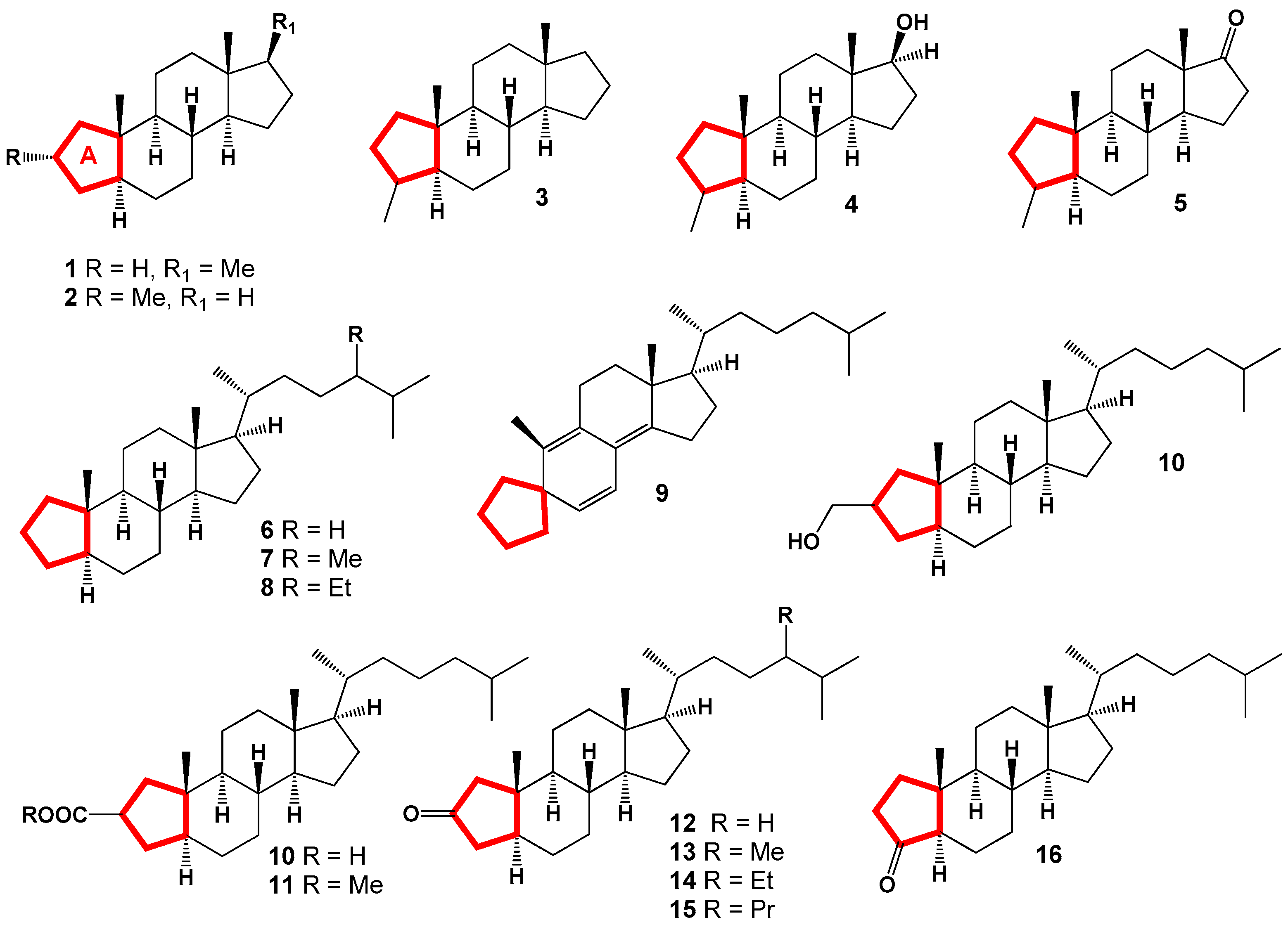
Figure 3.
Samples of some species of marine sponges that contains A-non steroids and inhabit various areas of the world's oceans: а, Axinella carteri, b, Darwinella australiensis, c, Haliclona sp., d, Suberites massa, e, Axinella verrucosa, and f, Ciocalypta sp. The pictures are taken from sites that allow their use for non-commercial purposes.
Figure 3.
Samples of some species of marine sponges that contains A-non steroids and inhabit various areas of the world's oceans: а, Axinella carteri, b, Darwinella australiensis, c, Haliclona sp., d, Suberites massa, e, Axinella verrucosa, and f, Ciocalypta sp. The pictures are taken from sites that allow their use for non-commercial purposes.

Figure 14.
B-nor steroids isolated from marine invertebrate extracts.
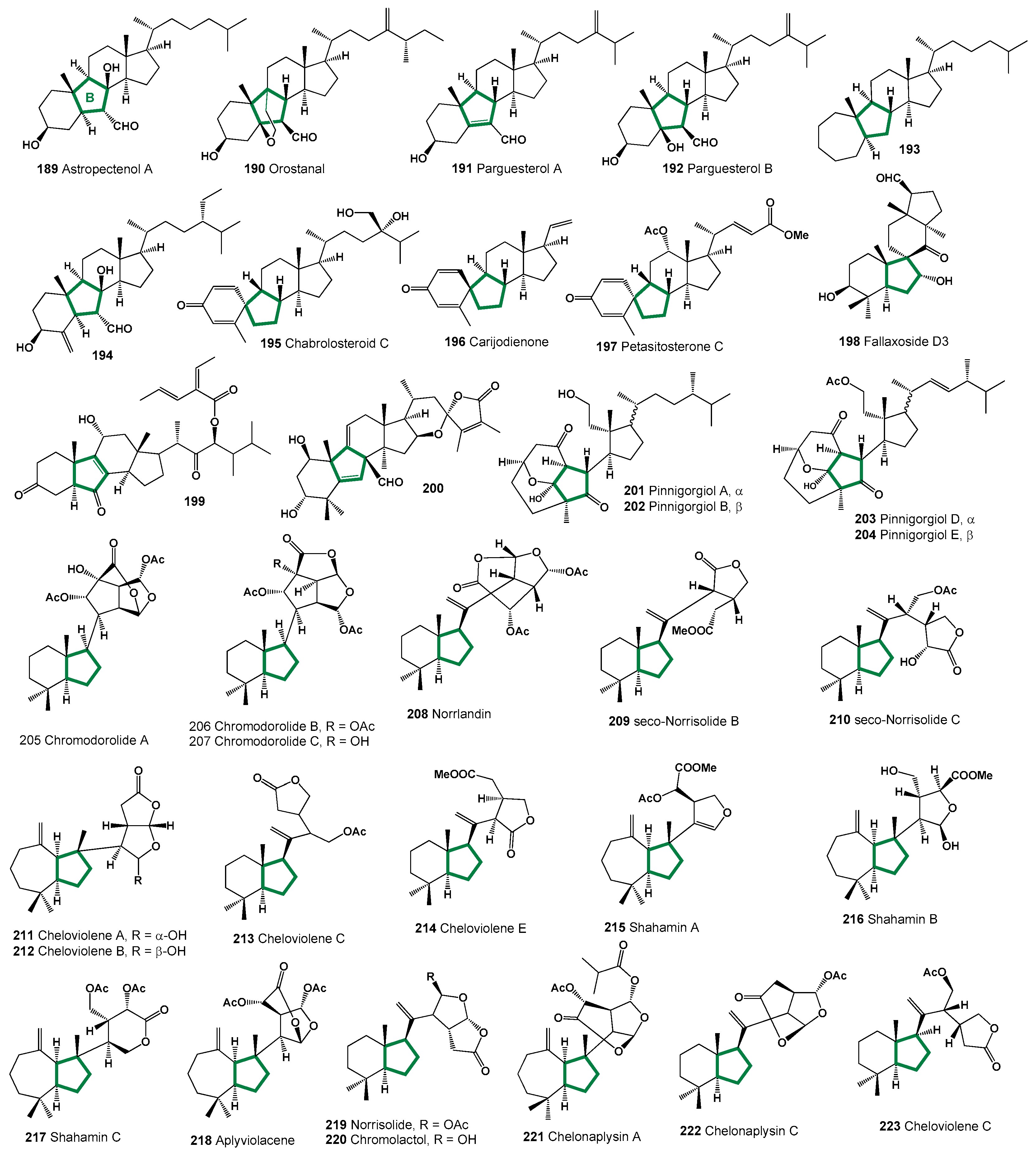
Figure 15.
Samples of marine invertebrates in which B-nor steroids were found: a, marine sponge Dendrilla sp., b, the New Zealand sponge Chelonaplysilla violacea, c, the Indo-Pacific nudibranch Goniobranchus coi, and d, the cosmopolitan marine sponge Dysidea sp.
Figure 15.
Samples of marine invertebrates in which B-nor steroids were found: a, marine sponge Dendrilla sp., b, the New Zealand sponge Chelonaplysilla violacea, c, the Indo-Pacific nudibranch Goniobranchus coi, and d, the cosmopolitan marine sponge Dysidea sp.
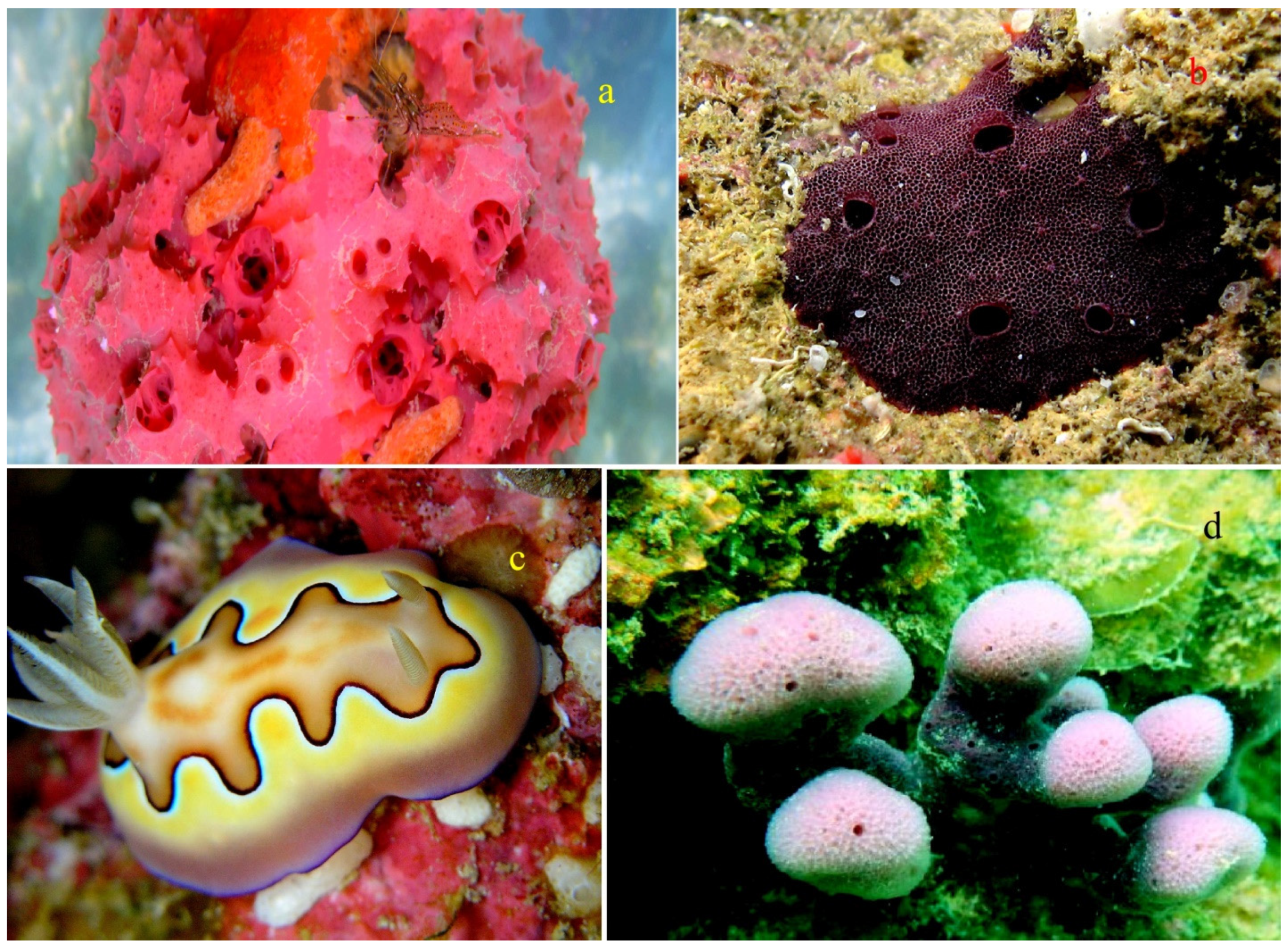
Figure 21.
Samples of plants, or individual parts of leaves, fruits in which B-nor steroids were found: a, Euphorbia pedroi, b, Abies chensiensis, c, Aphanamixis polystachya, d, Ypsilandra thibetica.
Figure 21.
Samples of plants, or individual parts of leaves, fruits in which B-nor steroids were found: a, Euphorbia pedroi, b, Abies chensiensis, c, Aphanamixis polystachya, d, Ypsilandra thibetica.

Figure 34.
Natural meroterpenoids are formed by modification of the D ring in steroid hormones.
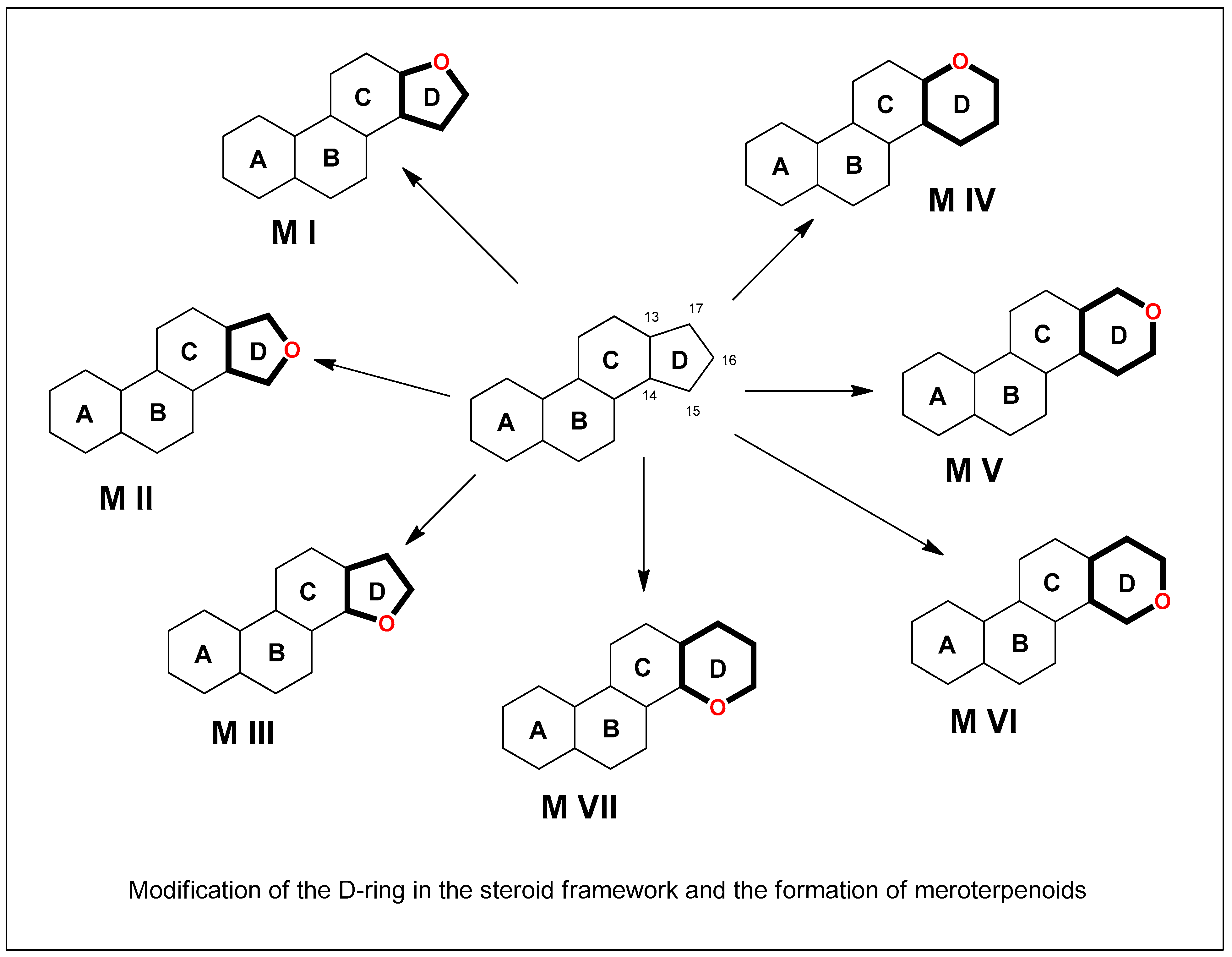
Figure 35.
Meroterpenoids derived from natural sources.
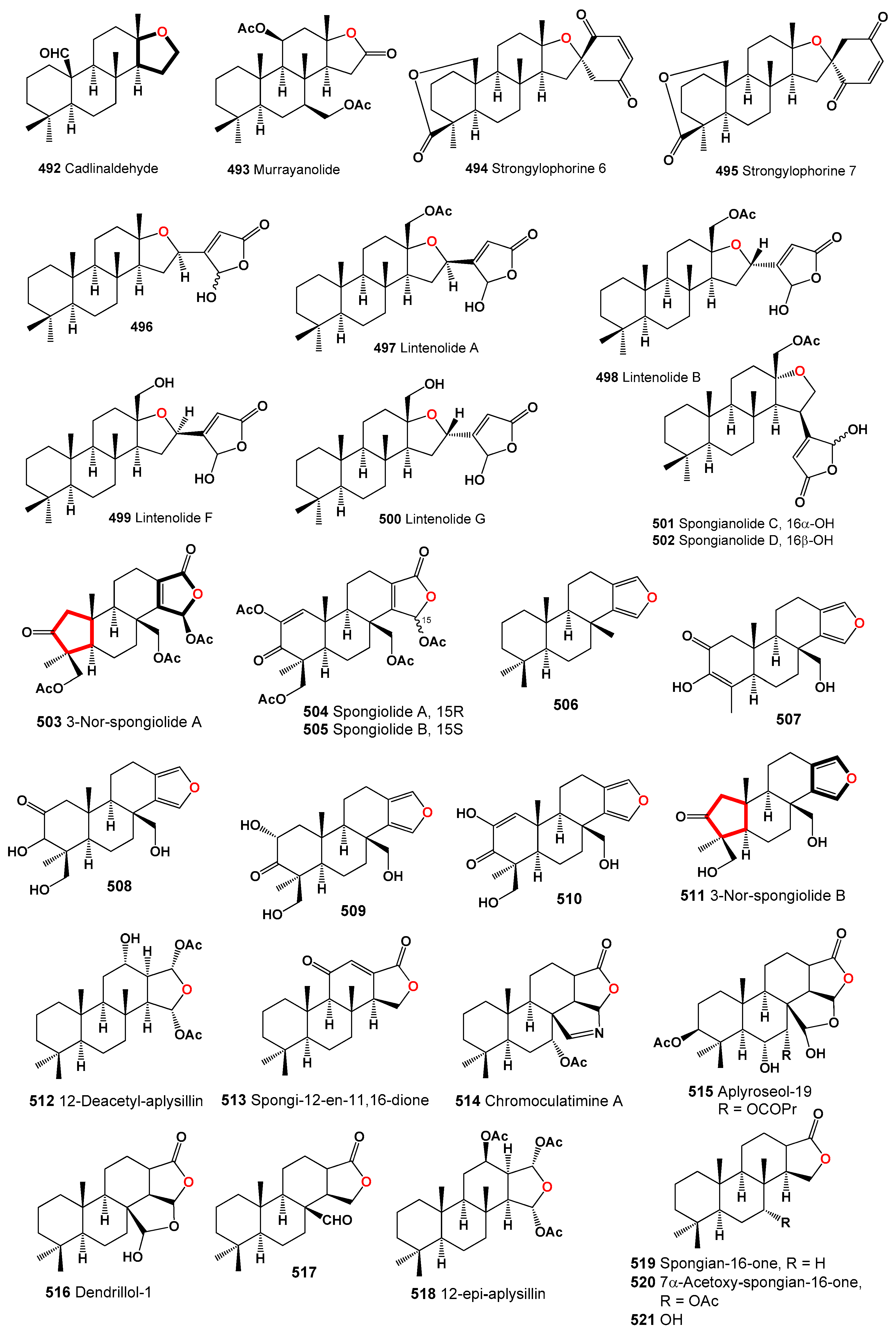
Figure 37.
Meroterpenoids derived from fungal endophytes, fungi and plants.

Scheme 2.
Synthesis of B-nor steroids.
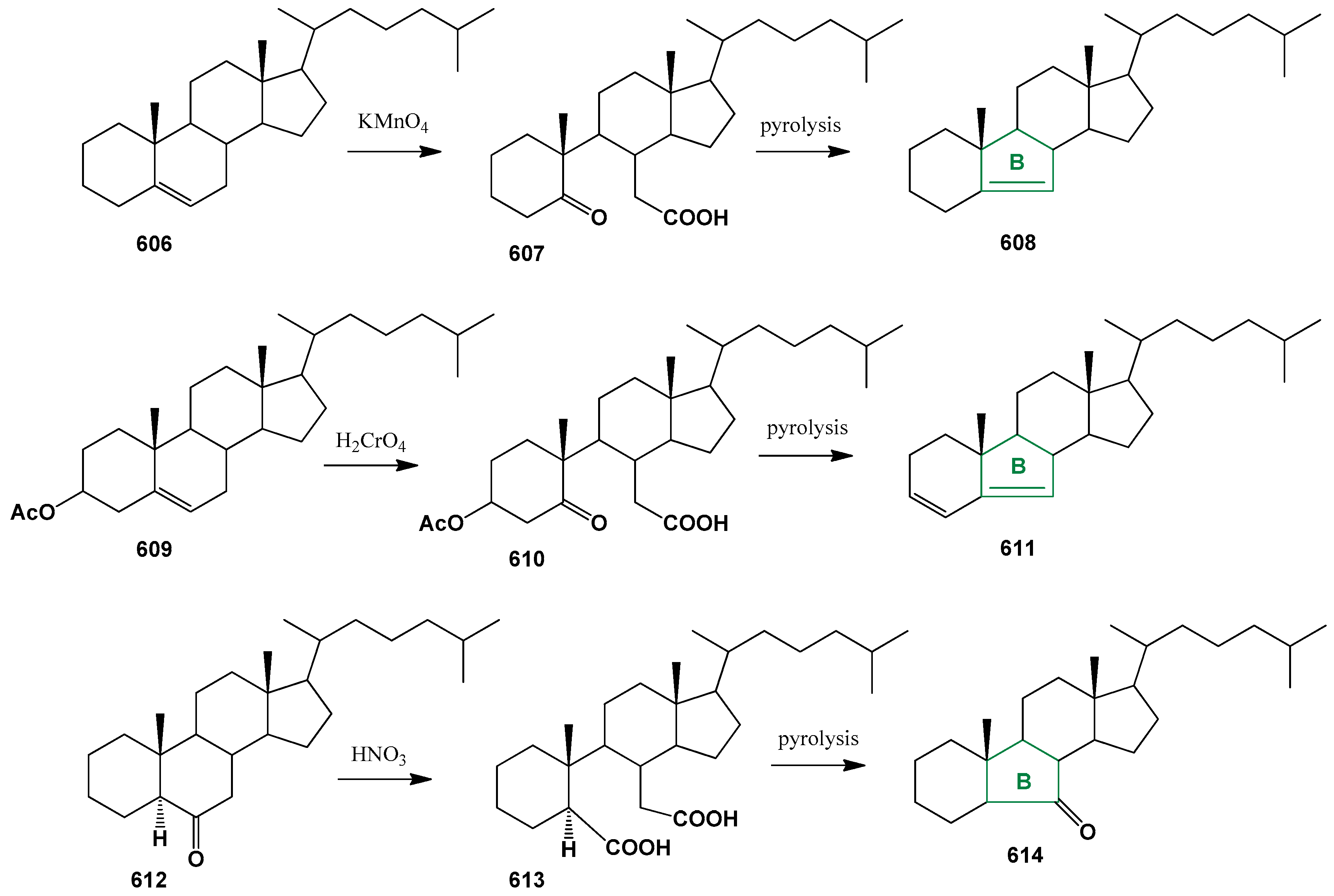
Scheme 4.
Synthesis of D-nor steroids.
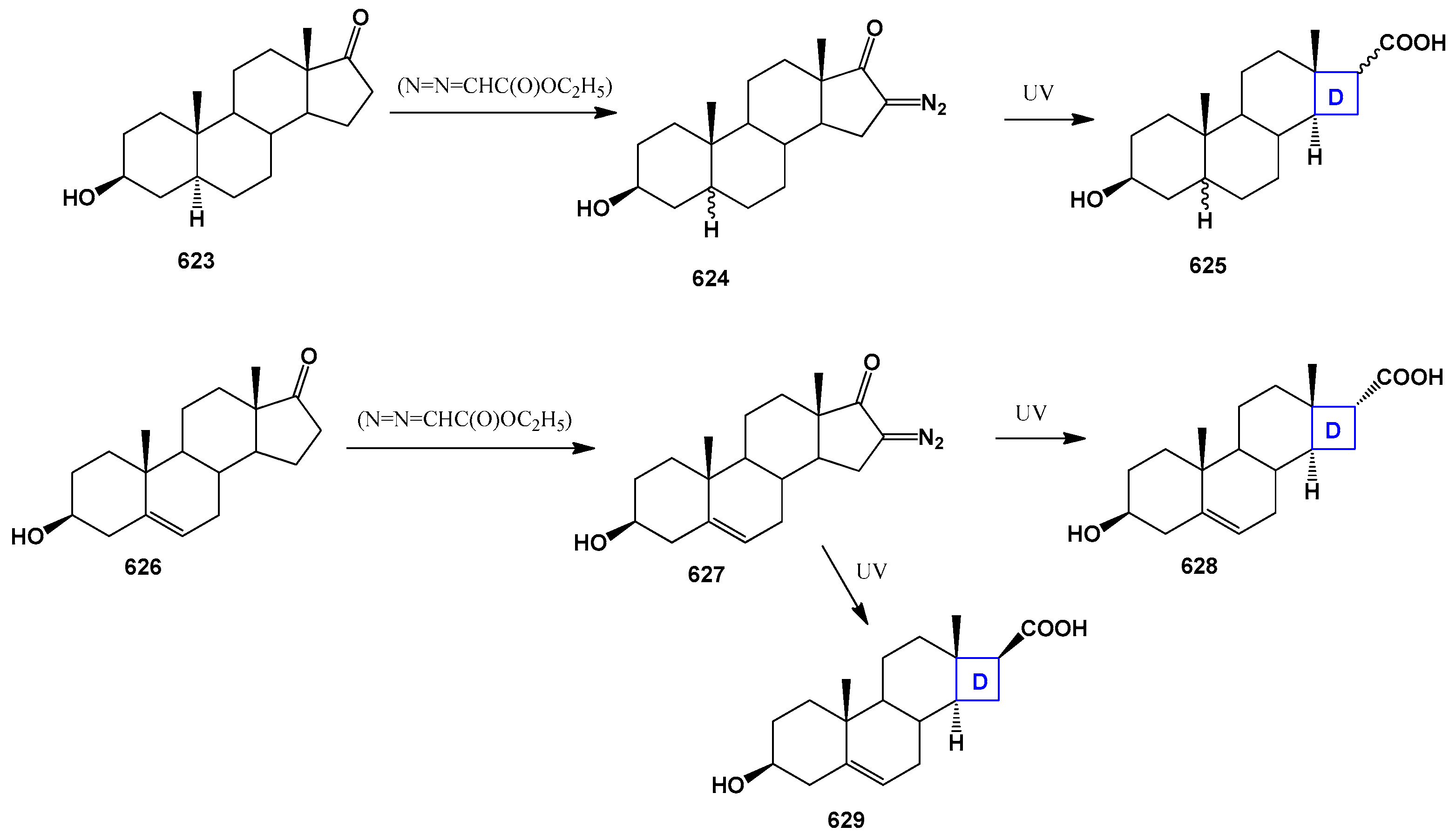
Disclaimer/Publisher’s Note: The statements, opinions and data contained in all publications are solely those of the individual author(s) and contributor(s) and not of MDPI and/or the editor(s). MDPI and/or the editor(s) disclaim responsibility for any injury to people or property resulting from any ideas, methods, instructions or products referred to in the content. |
© 2024 by the authors. Licensee MDPI, Basel, Switzerland. This article is an open access article distributed under the terms and conditions of the Creative Commons Attribution (CC BY) license (http://creativecommons.org/licenses/by/4.0/).
Copyright: This open access article is published under a Creative Commons CC BY 4.0 license, which permit the free download, distribution, and reuse, provided that the author and preprint are cited in any reuse.
Alerts
MDPI Initiatives
Important Links
© 2025 MDPI (Basel, Switzerland) unless otherwise stated





